

Meet the 2022 Golden Pencil winners: Carmen Fortino & Michel Manseau

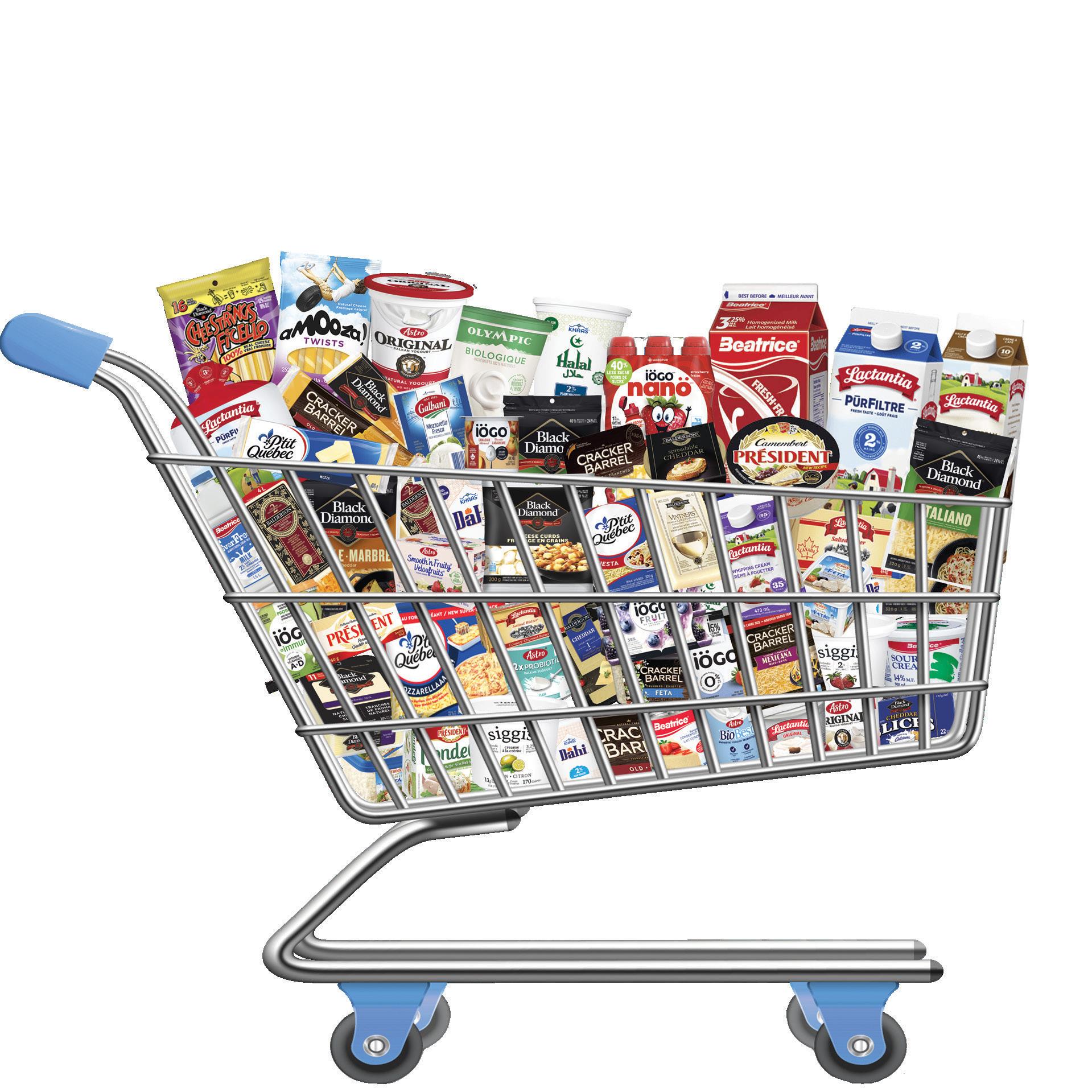
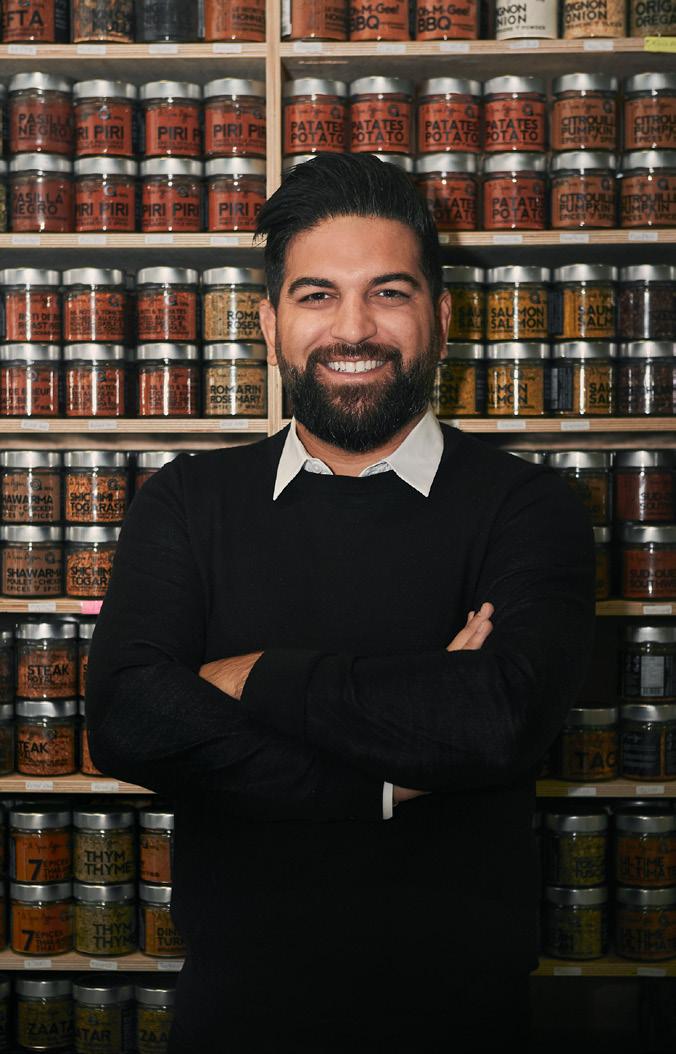





November 2022 || CANADIAN GROCER 3 COVER PHOTO: MIKE FORD, PEOPLE PORTRAIT: CHANTALE LECOURS, ILLUSTRATION: GARY NEILL, BAKED GOODS: GETTY IMAGES/PIDJOE Contents Features Cover Story WHAT RETAIL PAYMENT TRENDS ARE HERE TO STAY? 34 Contactless is in and cash is out, as savvy retailers give shoppers new ways to pay CHECKING IN ON SELF-CHECKOUT 39 As tech improves, shoppers are more willing to do their own checking out at the store GROCERY’S GREATS 29 Meet Carmen Fortino and Michel Manseau, the 2022 Golden Pencil Award winners! 8 Follow us on @CanadianGrocer Canadian Grocer Opinions 5 || Front Desk 21 || Behind the Trends 23 || Eating in Canada People 6 || The Buzz Comings and goings, store openings, awards, events, etc. 8 || The spice of life After taking over his family’s spice business, Ayman Saifi pivoted to create custom blends inspired by his own cooking Ideas 11 || Chop shop The cost saving measures Canadians are adopting to tackle rising food prices 13 || The big question Grocery leaders weigh in on industry hot topics 15 || Mastering the ‘F’ words The Star Women winners panel on the importance of flexibility, feedback and failure 16 || Longo’s teams up with Kitchen Hub The store within a store concept offers restaurant quality meals and convenience 16 || Loblaw, Gatik hit the road with driverless fleet Autonomous delivery service is on the move without a safety driver 17 || Global grocery News and ideas from the world of food retail 24 || Time to shine! See photos from this year’s sold out Star Women in Grocery ceremony, held in Toronto Aisles 49 || Snack of all trades At home or on the go, consumers are experiencing a serious snack attack 53 || Rising to the occasion Why Canadians are willing to indulge in baked goods 54 || Booze-free bevvies: Four things to know Cheers! Your guide to this booming beverage category 55 || New on shelf Shining a spotlight on the latest products hitting shelves Express Lane 56 || Taking Stock CIBC Capital Markets’ Mark Petrie on grocery’s post pandemic opportunities 53 November 2022 || Volume 136 Number 7 34


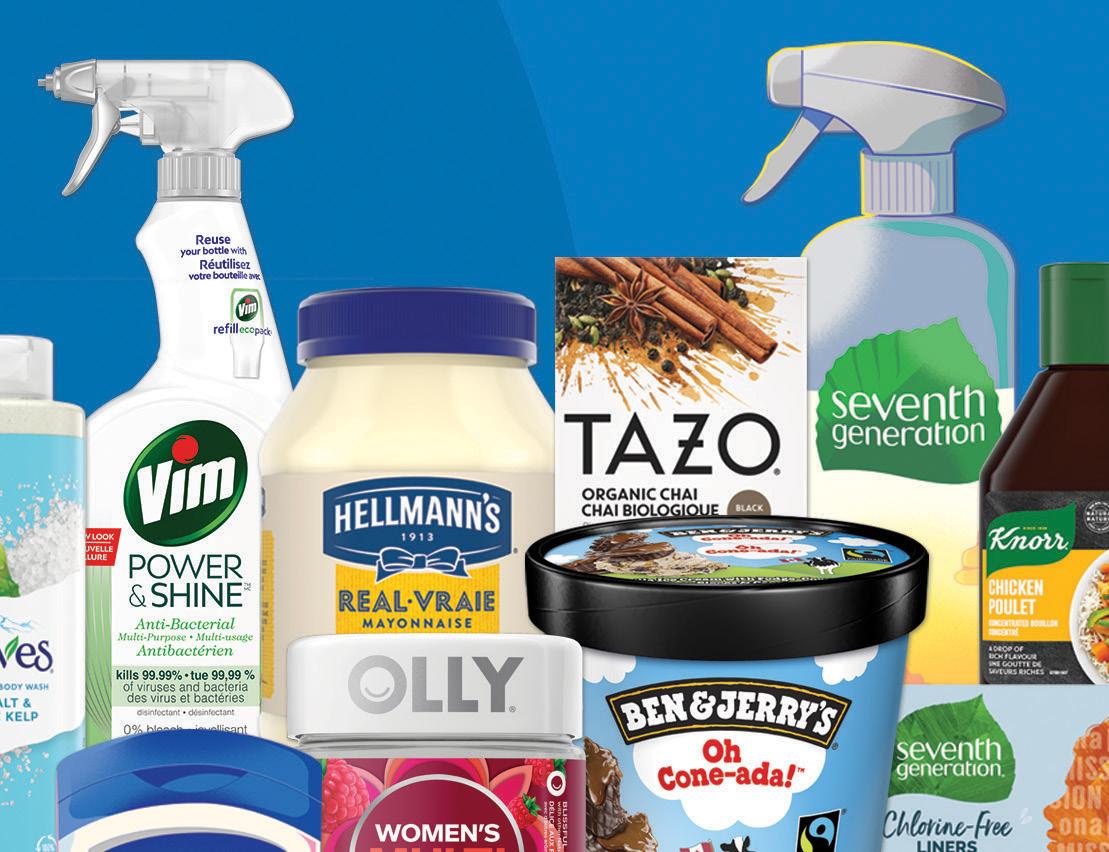
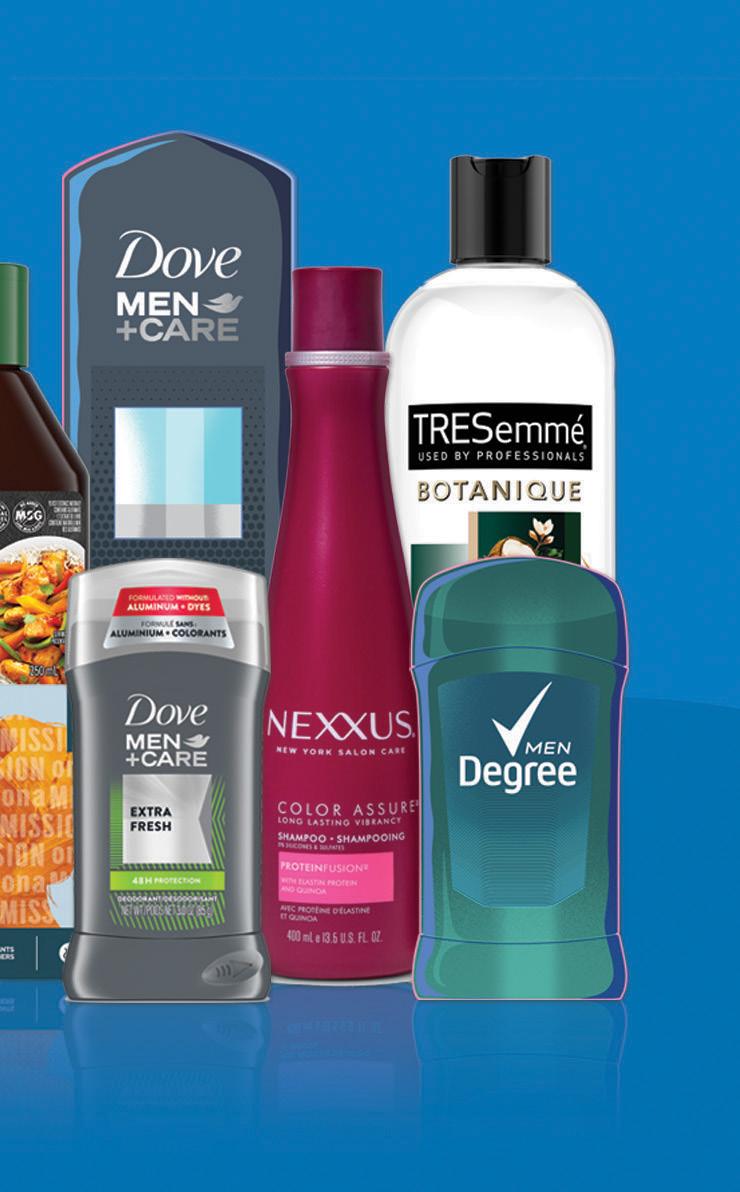


PUBLISHER


Vanessa Peters vpeters@ensembleiq.com
EDITOR-IN-CHIEF
Shellee Fitzgerald sfitzgerald@ensembleiq.com
MANAGING
Kristin Laird klaird@ensembleiq.com

DIGITAL
Jillian Morgan jmorgan@ensembleiq.com
ART
Josephine Woertman jwoertman@ensembleiq.com
SENIOR
Michael Kimpton mkimpton@ensembleiq.com
SENIOR
Sandra Parente sparente@ensembleiq.com
VICE
Megan Judkins mjudkins@ensembleiq.com
SENIOR
Valerie White vwhite@ensembleiq.com
Katherine Frederick kfrederick@ensembleiq.com
krajani@ensembleiq.com


jchacon@ensembleiq.com
So what lie S ahead? Analysts and industry observers are already specu lating on both big issues—how long will high inflation stick around? (according to The Bank of Canada, awhile yet)—and those a little less weighty; for instance, Whole Foods’ predictions that kelp and something called yaupon, will be ingre dients to watch in 2023.

How the in-store shopping experience will continue to evolve in the future is always a fascinating subject to explore. In this issue, the question was put to CIBC Capital Markets’ Mark Petrie. We asked the equity research analyst what grocery shoppers expect from the in-store experi ence in a post- COVID world. Among other things, Petrie said we’re returning to a time of shopper engagement, and that consumers expect technology to be lay ered into their shop to improve the expe rience (read the full interview, page 58)
Staying on the topic of in-store tech and the shopping experience, in “Checking in on self-checkout” (page 39) writer Rosalind Stefanac looks at the rise, thanks to a pan demic boost, of these self-serve systems, which are projected to grow 11.9% year over year to 2026. Once disparaged, more and more consumers are now embracing the idea of skipping the line and checking themselves out. We also look at the new age of payments (page 34) and how the pressure is on for retailers to stay on top of all the ways shoppers want to pay, and how integrating loyalty and payments can be a big opportunity for grocers.
Finally, in this issue we are also shin ing a light on excellence in the Cana dian grocery industry. Metro’s Carmen Fortino and Michel Manseau of Kruger Products (our cover subjects) are the win ners of the 2022 Golden Pencil Awards, a decades-old award that recognizes out standing contributions to the industry and communities. Turn to page 29 to see why these two impressive leaders are the recipients of the industry’s highest hon our. Fortino and Manseau will receive their awards at a ceremony in Toronto on Nov. 21, as part of Canadian Grocer’s GroceryConnex leadership conference. Visit groceryconnex.com for details. CG

November 2022 || CANADIAN GROCER 5 GETTY IMAGES/WHYFRAMESTUDIO
As another tumultuous year
winds down, inevitably, we look to what’s next
Shellee Fitzgerald Editor-in-Chief sfitzgerald@ensembleiq.com Keep up to date on the latest news by signing up for our e-newsletter. It’s free and we’ll deliver it to your inbox four times a week. Visit canadiangrocer.com to subscribe Front desk Self-checkout is predicted to grow considerably over the next few years LOOKING AHEAD CORPORATE OFFICERS CHIEF EXECUTIVE OFFICER Jennifer Litterick CHIEF FINANCIAL OFFICER Jane Volland CHIEF PEOPLE OFFICER Ann Jadown EXECUTIVE VICE PRESIDENT, OPERATIONS Derek Estey EXECUTIVE VICE PRESIDENT, CONTENT & COMMUNICATION Joe Territo MAIL PREFERENCES: From time to time other organizations may ask Canadian Grocer if they may send information about a product or service to some Canadian Grocer subscribers, by mail or email. If you do not wish to receive these messages, contact us in any of the ways listed above. Contents Copyright © 2022 by EnsembleIQ, may not be reprinted without permission. Canadian Grocer receives unsolicited materials (including letters to the editor, press releases, promotional items and images) from time to time. Canadian Grocer, its affiliates and assignees may use, reproduce, publish, republish, distribute, store and archive such submissions in whole or in part in any form or medium whatsoever, without compensation of any sort. ISSN# 0008 3704 PM 42940023 Canadian Grocer is Published by Stagnito Partners Canada Inc., 20 Eglinton Avenue West, Ste. 1800, Toronto, Ontario, M4R 1K8. Printed in Canada
EDITOR
EDITOR
DIRECTOR
DIRECTOR OF PRODUCTION
VICE PRESIDENT, GROCERY AND CONVENIENCE, CANADA
PRESIDENT, EVENTS
DIRECTOR, DIGITAL CANADA & SPECIAL PROJECTS
SALES NATIONAL ACCOUNT MANAGER
ACCOUNT MANAGER Karishma Rajani
SALES COORDINATOR Juan Chacon
SUBSCRIPTION SERVICES Subscriptions: $85.00 per year, 2 year $136.00, Outside Canada $136.00 per year, 2 year $216 Single Copy $12.00, Groups $61.00, Outside Canada Single Copy $16.00. Digital Subscriptions: $60.00 per year, 2 year $95.00 Category Captain: Single Copy $20.00, Outside Canada Single Copy $30.00 Fresh Report: Single Copy $20.00, Outside Canada Single Copy $30.00 Who’s Who: Single Copy $190.00, Outside Canada Single Copy $230.00 Email: contactus@canadiangrocer.com Phone: 1-877-687-7321 between 9 a.m. to 5 p.m. EST weekdays Fax: 1-888-520-3608 Online: www.canadiangrocer.com/subscription
The
Langley, B.C.’s Walnut Grove neighbourhood is home to a new FRESH ST. MARKET. The store, which opened in late October, is inspired by the executive and culinary team’s tours of public markets and eateries across North America and offers a wide range of local prod ucts. “This destination brings a market-like expe rience to those who live in and around the Fraser Valley who also enjoy supporting local farmers and producers,” said Mark McCurdy, vice-president retail operations and brand strategy at Fresh St. Market, in a release. Among the store’s local offerings are a curry bar featuring family recipes from Spice Mantra Curries, meat sourced from Lepp Farms, coffee beans from Lion’s Bay Coffee Company and cheese from the likes of Golden Ears Cheesecrafters and Creekside Cheese and Creamery. The Langley store is the sev enth Fresh St. Market location in the province.
Toronto is getting a second EATALY location. The Ital ian food hall has signed a multi-year lease at Cadillac Fairview Sherway Gardens shopping centre, located

The latest news in the grocery biz


in the city’s west end. Eataly opened its first Canadian location in Toronto in November 2019, and it currently has nine food halls in North America with 40 stores worldwide. An opening date has not been announced.
FARM BOY opened its ninth Toronto location in November. The Empire-owned banner continues its expansion across Southwestern Ontario with a new 27,739-sq.-ft. space located at the busy midtown intersection of Yonge and St. Clair. The store will employ 139 staff members and feature a wide variety of fruit and vegetables, butcher-quality meats, arti san cheese, plant-based and vegan options as well as a salad bar and hot bar for grab-and-go options.

CALGARY CO-OP’S North Hill location is being rede veloped into a mixed-use community. The site, purchased in September by Royop Development Corporation, will be transformed to include resi dential apartments, a parkade, two new commercial buildings and a new, full-service Calgary Co-op gro cery store along with a Calgary Co-op Wine Spirits Beer store, a cannabis shop, car wash and gas bar. Construction will begin early next year and the cur rent Calgary Co-op grocery store will continue to operate until the new store opens, at which time the old location will be demolished to make room for other new buildings.

6 CANADIAN GROCER || November 2022 FRESH ST. MARKET, EATALY, CALGARY CO-OP, LOBLAW
Buzz News to share? Tell us about your openings, comings and goings, etc. by dropping a line to sfitzgerald@ensembleiq.com
OPENINGS
(Top left and above) Fresh St. Market opened a new store in Langley, B.C. in late October. (Right)
Eataly announced plans for a second Toronto location at CF Sherway Gardens shopping centre
Calgary Co-op’s North Hill location is being redeveloped. (Below) A new Real Canadian Super store has opened at Calgary’s Bow River Shopping Centre
NATURE’S EMPORIUM continues to expand. The health food market chain has announced plans to open a new location in Oakville, Ont., west of Toronto in 2023. To be located at Dorval Crossing shopping cen tre, the 24,000-sq.-ft. store will specialize in organic produce, plant-based products, healthy meals to go, supplements and natural health and beauty items. Last summer, the retailer announced plans to open its first downtown Toronto store, in the city’s South Core district in 2023. Nature’s Emporium currently has four locations in the Greater Toronto Area: in Newmarket, Burlington, Maple and Woodbridge.


Loblaw has opened a new REAL CANADIAN SUPERSTORE at Calgary’s Bow River Shopping Centre. At 86,200 sq. ft., the store serves as an anchor tenant in the development, which also includes a new Real Cana dian Liquor Store.

WALMART CANADA has announced plans to open its firstever fulfilment centre in Quebec. The new, $100 million high-tech facility will be located in Vaudreuil-Dorion, near Montreal, and will function as a delivery hub for Quebec as well as Atlantic Canada. The retailer says the 457,000-sq.-ft. fulfilment centre will be capable of shipping 20 million items annually to local customers. Walmart Canada is investing $1 billion in infrastructure this year as part of its efforts to “speed up and trans form the business for its customers.”


(Clockwise from top) Walmart is opening its first fulfilment centre in Quebec; Farm Boy announces ninth Toronto store; Nature’s Emporium is expanding to Oakville, Ont.
P&G Canada has made changes to its leadership team. Jennifer Seiler, a 22-year veteran of the company, has been appointed senior vice-president of marketing, Canada. Meanwhile, Melody Wallis, who has racked up 20 years of experience at P&G in Canada and the United Kingdom, has been named vice-president of analytics & insights and technology, Canada. Seiler and Wallis succeed Bethanie Butcher, who has relocated to Panama to take on the role of senior vice-president analytics & insights, Latin America.
Suzanne Dalrymple has joined Gay Lea Foods and will transition to the role of president and chief executive officer of the company next February. The former Mars executive replaces Michael Barrett, who has announced plans to retire at the end of January. Barret has held the top post since 2014.



At Conagra Brands, Sebla Guvener is the company’s new head of supply chain for Canada. Prior to Conagra, Guvener led the supply chain for nutrition at Nestlé Canada and she has also held several roles at P&G Canada.



FHCP AWARD OF DISTINCTION
Food, Health & Consumer Products of Canada (FHCP) has named Margaret Hudson, president and CEO of Burnbrae Farms, and former Tree of Life Canada executive Jamie Moody, as the winners of its 2022 Award of Distinction. The award recognizes “lasting and profound impact on FHCP and Canada’s food, health and the consumer products industry.” Hudson and Moody received their awards at FHCP’s annual CEO and Executive Leadership Conference held in Niagaraon-the-Lake, Ont., in October.
November 2022 || CANADIAN GROCER 7 WALMART CANADA, FARM BOY
Melody Wallis
Jennifer Seiler
Suzanne Dalrymple
Michael Barrett
Sebla Guvener
PEOPLE
AWARDS/RECOGNITION
By Andrea Yu Photography by Chantale Lecours
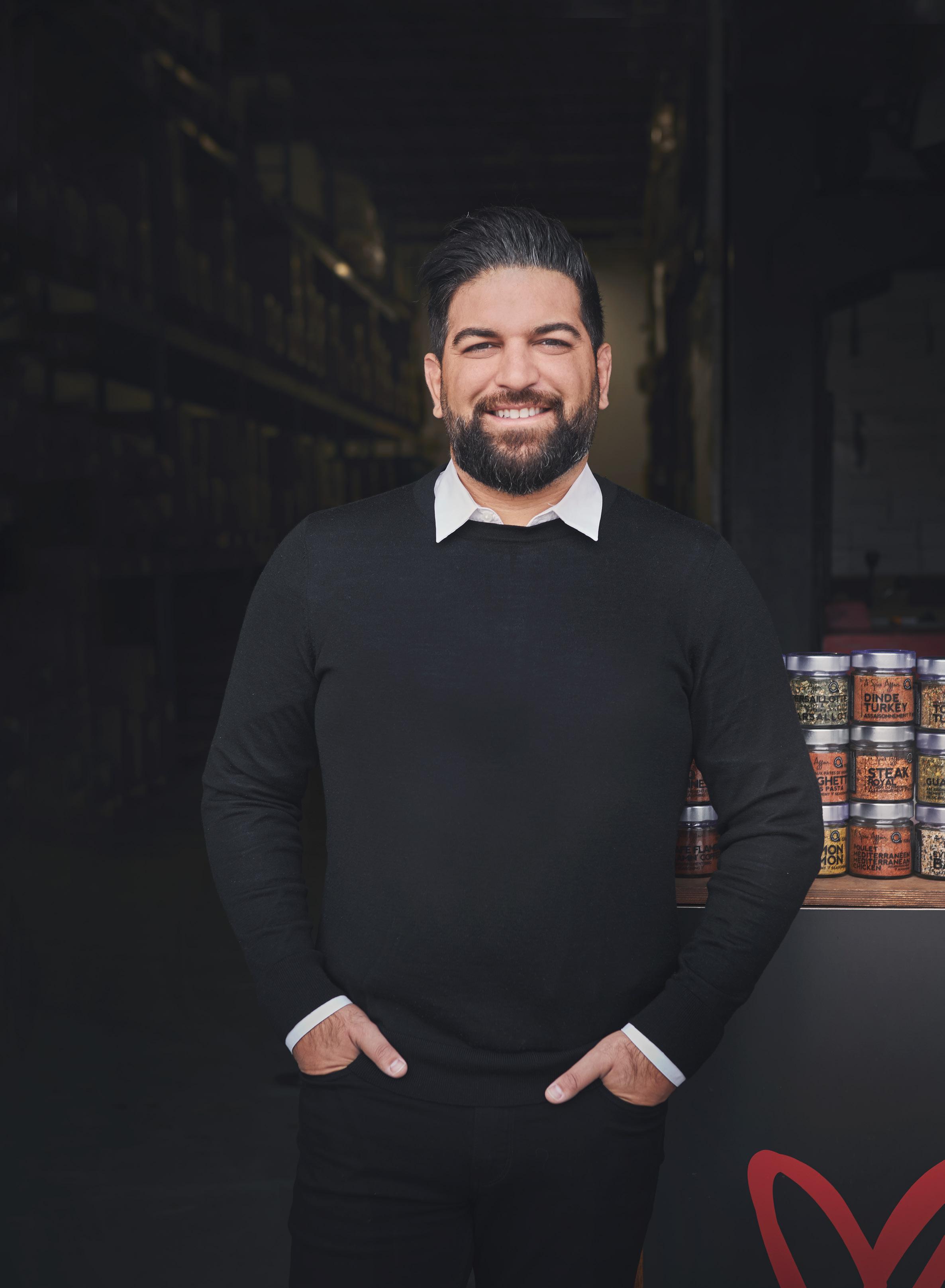
People Who you need to know THE SPICE OF LIFE After taking over his family’s spice business, Ayman Saifi pivoted to create custom spice blends inspired by his own cooking
Ayman Saifi’S roots in the spice industry go back more than a hundred years. “I’m a fourth-gen eration spice merchant,” Saifi explains. “We’ve been trading spices since my great-grandpa, Husni, started the business in Palestine in the early 1900s.”
From there, Saifi’s grandfather and father expanded the business, shifting from Pales tine to Jordan in the 1970s and 1980s and, ultimately, relocating their operations to Quebec in 1999.
While completing his university studies in the late 2000s, Saifi worked for his father’s business as a sales representative. At the time, the company focused mostly on the distribution of imported finished goods, such as rice and dry legumes, while a third of the business was spices. “Our customer base was mostly regional,” he explains. “Butchers, retail stores, a few restaurants and indepen dent mom-and-pop shops.”
A decade later (in 2013) Saifi’s parents made the decision to retire to Dubai, leaving Saifi to take over operations. “I helped build the business alongside my dad and he had full trust in me,” he says. At the same time, however, Saifi was losing his spark for sales. “I felt like something had to change because we had hit a plateau,” he explains. He wanted to pivot, but he wasn’t sure how to do it.
A few years later, the inspiration for change came from Saifi’s own kitchen, where he often experimented by making different spice blends. “I made tacos one time using my own spice blend,” he recalls. “I invited my neighbours for dinner and they were like, ‘They’re so good’ and wanted to know how I made them. I thought to myself: ‘I need to put this blend together and sell it as a fin ished product’.”
From there, Saifi went on to develop about a dozen spice blends, ranging from a steak spice to Thai-inspired combinations and a za’atar similar to his mother’s. He would test early recipes out on friends (“a lot of my neighbours were my guinea pigs”) and gave samples out to his team of eight employees to test in their home kitchens.
After naming his new company A Spice Affair—“I wanted the brand to represent the love affair that people have with food and their kitchens”—his next task was finding retailers to list his products. Saifi’s first big account, and a validating achievement for the entrepreneur, was getting Winners on board in October 2016, just a few months prior to A Spice Affair’s official launch. “I actually pitched Winners before I had a finished prod uct ready,” Saifi recalls. “I got a few jars and
labels printed out from a regular printer. They looked really bad.” Nevertheless, the Winners buyer believed in Saifi’s product and agreed to stock A Spice Affair in more than 400 stores nationally. “The first time I saw it on the shelves of Winners was through a picture sent to me by a friend who lives in Toronto,” he explains. “It was a very humbling feeling. It gave me a huge sense of pride.”
From there, Saifi continued to seek out more distributors. His next big milestone came in 2018 when HomeGoods, a home decor retailer in the United States, came on board. A year later, A Spice Affair broke into the grocery retail market with Sobeys locations in Quebec. Saifi was just beginning to make further moves in grocery when the pandemic hit.
“It was actually a very scary few weeks,” he recalls. But Saifi persevered and focused efforts on increasing his grocery representa tion, along with pushing direct-to-consumer online orders. “We saw a 2,000% jump in e-commerce sales,” he says. “That was an incredible feat.”
A Spice Affair’s e-commerce growth caught the attention of a distributor in Ontario, who Saifi has since partnered with to gain contracts at Loblaws stores in the province. Saifi also grew his grocery reach in Quebec, working with Metro to develop a French sister brand called Passion d’épices.
And this year, Saifi brought A Spice Affair into more international markets—his former home country of Jordan. There, he secured his first celebrity partnership with renowned Jordanian chef Deema Hajjawi. “She fell in love with the brand,” Saifi says. “We did a collaboration and developed four custom blends that were her recipes.”
Today, A Spice Affair and Passion d’épices can be found in more than 1,000 stores in Canada. And Saifi has no intentions to slow down. Next year, he plans to enter the United Arab Emirates and introduce products such as infused maple syrups—his first venture outside of dry spices. “We’re working on a smoky jalapeño maple syrup and a maple pepper syrup,” he says.
Looking back at his family’s legacy, Saifi thinks his great-grandfather, who used to trade spices and goods by the boatload, might be surprised at the direction that Saifi has taken—but he’d still be proud. “Today, we’re selling [spices] in 100-gram jars, mix ing and matching them,” Saifi says. “I see this as more of an art versus a trade. Their trade was an art in its own form. And today, we’re taking that and turning it into an art that people can enjoy.” CG
30 seconds with …
AYMAN SAIFI
What do you like best about your job?
Getting feedback from customers, like testimonials and reviews. It’s a kind of reassurance and validation in what I’m doing. I think it’s extremely fulfilling and rewarding, especially when people are praising the customer service and the product, the taste, the quality.
If you weren’t in the food business, what would you be doing?
Custom pet supplies. Like many people during the pandemic, I got a pet, which was life changing. My dog, a German Shepherd-Husky named Berlin, is pretty much my other half. But it’s been very difficult to find nice, premium products and gear, like collars and leashes, in customizable colours.
What is the best career advice you’ve received?
Focus, focus, focus. [I received this advice] years ago when I was showing the progress of my business to a mentor and I had a lot of ideas.
What is your favourite product from the lineup?
The Everything Bagel seasoning is something I use almost daily. I put it in my eggs—I can’t have eggs without it—and in labneh, which is a Middle Eastern soft cheese. It’s really good. And the Brazilian barbecue, I use that for every meat, even to make burger patties. I love that flavour.
November 2022 || CANADIAN GROCER 9
Enterprise IT Services and











When you contact BFG, a dedicated specialist helps you every step of the way. Connect with us today!
Support Economy, Quality & Experience For over 30 years BFG has been Canada’s only nationwide single-source for IT systems, installation, maintenance & support. For Canada’s grocers, retailers, and hospitality, we help you pivot to meet the new realities of ecommerce and the way shoppers interact with your business. Implementation Services Asset Management Field Services Supply Chain Technology Electrical Services End-User Service Customized & Sustained IT Solutions Optimize your store, distribution centre and supply chain performance with the right technology. Maximize uptime with best-in-class technology 90%+ SLA success rate and Asset lifecycle management to stay on top of digital transformation Tailored National IT Solutions First-time-fix support, 7/24/365 bilingual call centre and Coast to coast service from in-house badged technicians. Minimize downtime with a 90%+ first-time-fix rate 170,000+ completed services calls annually Specialized system supporton top of digital transformation bfg.ca
COPING WITH COSTS


aS the coSt of groceries hits eye-watering highs, moneysaving measures are on fire.
That’s a key takeaway from a recent study by the AgriFood Analytics Lab at Dalhousie University, in partnership with Caddle, that examined how Canadian consumers are dealing with higher grocery prices.
The study of 5,000 Canadians found that in the last year, 33.7% of respondents have used more loyalty pro gram points to pay for their groceries, 32.1% read weekly flyers more often, and nearly 24% are using more coupons at the grocery store.

Canadians are cultivating a green thumb to save money on food: 15.5% of consumers have started growing their own food in the last year. Ontario has the highest percent age of budding gardeners (17.4%), followed by B.C. (16.2%), the Atlantic (15.2%), Quebec (13.7%) and the Prairies (13.1%).
“I think the media has done a pretty good job informing the public in terms of how to save money and Canadians



are paying attention,” says Sylvain Charlebois, senior director of the Agri-Food Analytics Lab. “Canadians are also domesticating themselves and doing things at home that are helping.”
The survey also looked at changes in shopping behaviour. While 8% of consumers have changed their primary grocery store where they buy most of their food, 12.9% of Canadians have started to visit more than one store in the last 12 months.
Just over 19% of Canadians have visited discount stores in the last 12 months, and 11.5% have visited dollar stores more often to buy food. Some are going straight to the source: 8% of consumers are visiting farmers markets more often, and 7.1% have visited roadside stands to buy directly from farmers in the last year.
Other money-saving tactics Canadians are using are: trying to waste less food (40.6%) and adding private-label products to their shopping carts (21%).
—Rebecca Harris
November 2022 || CANADIAN GROCER 11 GETTY IMAGES/MONKEYBUSINESSIMAGES
SHOPPER BEHAVIOUR Ideas RETAILERS || SUPPLIERS || SHOPPERS || INSIGHTS
EUROPEAN CHEESES ALWAYS PLEASE THE PALATE
There is something truly special about sampling a fine-quality cheese that tantalizes the tastebuds, and with a bevy of natural, artisan cheeses from Europe now available in Canada, it’s no wonder more Canadians are gravitating towards them.
In Europe, centuries of cheese-making tradition preserved across multiple regions have resulted in the production of delicious, unprocessed, locally made cheeses that are still so authentic their quality is unparalleled to this day.

Austria is among those revered European regions producing high-quality, authentic artisan cheese that work for any occasion. As a central European nation famous for its exceptional landscape, Austria produces more than 450 hard and soft cheese varieties. And in keeping with tradition, these cheeses are primarily produced by small, family-owned businesses guided by generations of cheese-making expertise. In fact, 90% of the milk farms in the region are family-owned and 85% of the land is supported by environment measures. Furthermore, all Austrian milk used to make cheeses is GMO-free, and farmers have been voluntarily producing GMO-free milk for nearly two decades. On average, farms keep only 22 heads of cattle, and most farmers still know their cows by name.
“We know that families have a very close relationship with their land and strive to cultivate it in a sustainable way in order to pass it on to the next generation,” says Margret Zeiler –Export Marketing Manager at Agrarmarkt Austria Marketing. “This kind of caring can’t help but be passed on in the careful crafting of these artisan cheeses.”


THE MAGIC OF THE MOUNTAINS







The Austrian Alps are at the heart of Austrian culture—as well as its cheese-making tradition. These majestic mountains coupled with pure air, soil and water, create the perfect backdrop for producing the nation’s famous mountain cheeses. Far, far away from urban life, pastures in the Alpine region nourish cattle to produce high-quality, GMO-free milk which is processed by small family farms using protected production methods passed down over multiple generations. This milk then plays a starring role in developing Alpine cheeses, the most famous of which is “Bergkase” mountain cheese known for its distinct buttery and nutty flavour.

With more than 500 years of cheesemaking practices passed on from generation to generation, today’s mountain cheeses from Austria offer the authentic taste of the Alps, while complementing Europe’s vast artisan cheese offerings. Consumers can be confident that Austrian mountain cheeses also follow the quality standards set by the European Union, which guarantees the authenticity, quality, place, and cheese-making technique
As more and more Canadians strive to fill their plates with tasty, natural foods—and opt for products that are more environmentally and ethically produced—unprocessed artisan cheeses from Austria fit the bill.

For more information, please contact: export@amainfo.at

The content of this promotion campaign represents the views of the author only and is his/her sole responsibility. The European Commission and the European Research Executive Agency (REA) do not accept any responsibility for any use that may be made of the information it contains.


When it comes to quality and taste, Austrian cheeses are in a league of their own
ADD AUSTRIAN CHEESES TO YOUR IN-STORE OFFERINGS! Special Promotional Feature in Canadian Grocer | November 2022
HOW ARE YOU RESPONDING TO CONSUMER CONCERNS OVER HIGH FOOD PRICES?
 Anthony Longo President and CEO LONGO’S
Anthony Longo President and CEO LONGO’S


“We appreciate that many Canadians are concerned about rising day-to-day costs, especially when it comes to necessities like food. To help mitigate the rising cost of food, we are working diligently to increase our Longo’s branded products and provide additional cost-friendly options to help Canadians get the most out of their food budgets. We offer meal solutions and recipes to provide inspiration about how to stretch dollars further. We also have our loyalty program, Thank You Rewards, which provides member pricing on items throughout the store and allows guests to accumulate points towards free groceries.”
Darrell Jones President PATTISON FOOD GROUP


“We understand their concerns as we are all being impacted by record-high inflation rates. Our manufacturers and supplier partners are seeing cost increases in all areas, from transportation and fuel costs to raw materials and packaging. I think it’s fair to say that all of us in the retail food industry are doing everything we can to mitigate passing these cost increases along to our customers. We will continue to work hard to provide options for our guests that are of the highest quality and the fairest prices.”
Jeff Ambrose Senior vice-president, operations & merchandising CALGARY CO-OP

“We understand there are many factors at play from supply chain issues to significant infla tion that are impacting grocery budgets. We encourage our customers to take advantage of our promotional offers including weekly flyer specials, Butcher’s Best savings in the meat department, and our Big Deals offered throughout all departments. We recommend our customers become mem ber-owners by purchasing a one-dollar lifetime membership. They can get even more value with Member Exclusive Pricing throughout our stores, partner discounts and offers, and an
Eric La Flèche
President and CEO METRO
“Inflation affects all departments and categories right now. Metro is well positioned to meet the changes in consumer behaviour and deliver the best value possible to consumers in these inflationary times with our multiple store formats, effective promotional strategies and a strong private-label offering. There’s a shift to value and it’s our job to provide the best value we can.”
Digs Dorfman CEO THE SWEET POTATO
“We’ve done our best to keep prices static during these turbulent times, but in some cases raising prices has been inevitable. To help reduce the strain on customers, we’ve negotiated great everyday low pricing on some key items, which we’ve strongly messaged. But, ultimately, if a customer asks why we had to raise a price on a particular item, we’ve just been direct with them every time: our costs have gone up.”
November 2022 || CANADIAN GROCER 13
THE BIG QUESTION Ideas
Deliver on quality, safety, and compliance, every time.
1
Canadian businesses work hard to ensure the freshness, quality, and safety of their products. Bell is able to help deliver on these commitments with innovative technologies that optimize the distribution process during transport.
On Canada’s best national network,1 Bell Smart Supply Chain allows you to:
Deliver fresh and quality products to customers
Maintain high product quality during transport, with automated near real-time alerts when trailer temperatures rise above or fall below thresholds specific to the cargo being transported.

Drive efficiencies in inventory and fleet management
Track the location of your trailers and allow fleet managers to monitor driver and vehicle performance. Map the location and status of all shipments on a visual dashboard with notification reports, and cross-reference data from multiple operational databases.
Prove compliance with regulations
View and maintain cold chain records with trip temperature graphs that outline events and range limits. Isolate and address quality issues to maintain regulatory compliance and a trustworthy brand image.
To learn more about Bell Smart Supply Chain, visit bell.ca/smartsupplychain
Based on a third party score (Global Wireless Solutions OneScore™) calculated using wireless network testing in Canada against other national wireless networks of combined data, voice, reliability and network coverage. Visit bell.ca/mobilenetwork.
MASTERING THE ‘F’ WORDS
Flexibility, feedback and failure—words that have been traditionally frowned upon or feared in business. But, during a recent panel discussion at Canadian Grocer’s Star Women in Grocery Awards ceremony in Toronto, some of this year’s winners explained how these ‘F’ words (and vulnerability, too) can positively impact company culture, employee engagement and personal success.

“Failure for the longest of times was perceived as a sign of weakness, which is not the case. When you fail, you learn and grow. I think it’s very important for each one of us to be humble and reflect and share those failures.”
—Stephanie Goyette, head of marketing & strategy, Taste Elevation, Kraft Heinz Canada

“It’s funny because people always talk about work-life balance, but for me it’s been about integration and being with a company that helps me do that. I’ve learned not to stretch myself too thin and to leave time for unplanned things. Flexibility has been key for me and exploring the options my company offers.”
—Shilpa Mukhi, VP, sales, P&G Canada

By Kristin Laird
“Early in my career I was running away from feedback. My best advice is to actively pursue feedback. It is a gift. It makes one feel so uncomfortable, but in that discomfort can come really great things.”
—Louisa Furtado, VP human resources Ontario and health & safety, Metro
“Vulnerability is a key aspect of building a strong workplace culture. I didn’t have a traditional career, I was out of the workforce for about eight years and when I [started at] Loblaw it was very difficult to return to work as a woman. I think it’s important to share that story with my teams and with my male colleagues that are hiring—to have that vulnerability of just how tough it is for women or men who are balancing caregiving and family. A big key is showing you’re not perfect. You have days where you forget to pack your kid’s snack.”


—Janet Rickford, VP, retail and merchandising data products and services, Loblaw Technology/Loblaw
“I am perfectly fine admitting I fail daily. The ‘F’ word is becoming a superpower and we have to embrace it. Nobody will ever put more pressure on me than me, so I get to choose how I accept my failure. If I can turn that around and make it a secret weapon, I’m going to own that all day long.”
—Bonnie Birollo, SVP retail operations, Sobeys
“People want to feel a sense of belonging and to feel understood. Be vulnerable, especially in a leadership position, to show them it’s not easy and create an environment where people feel heard and supported.”
—Jessica Armstrong, VP, eCommerce, Maple Leaf Foods

November 2022 || CANADIAN GROCER 15 GOLDMEDIA.CA
Ideas
LONGO’S TEAMS UP WITH KITCHEN HUB
Grocery S tore S continue their slow but steady evolution from solely selling raw ingredients to being a one-stop shop for both fresh foods and pre-cooked, restaurant-quality meals.
Kitchen Hub, a two-year-old company that brings together “celebrated restau rants” using the ghost kitchen concept, has opened its fourth location, this time inside a Longo’s store in Toronto’s Liberty Village neighbourhood. It is being billed as the first ghost kitchen to open inside a Canadian grocery store.
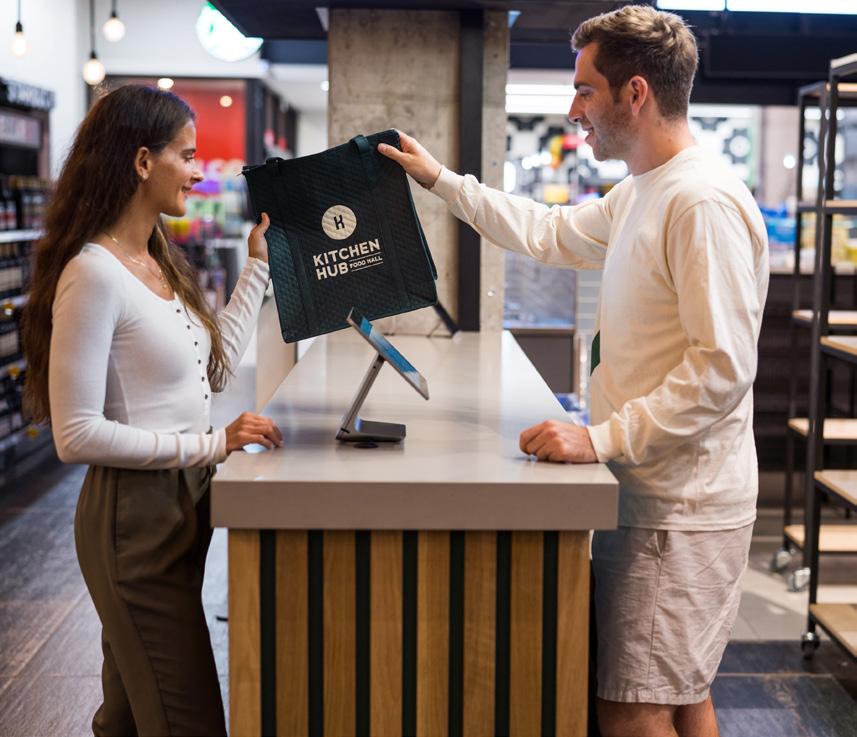
The store-within-a-store concept fea tures a full menu of items from Thai restaurant PAI, as well as Mandy’s Gour met Salads, fried chicken and burger joint Cabano’s Comfort Food, and the Mexican spot Tecolote. Customers can mix and match items from any of the four restaurants and can also add graband-go offerings from The Cheesecake Factory Bakery and Elle Dee Bakery, as well as ready-to-eat items from Longo’s kitchen, including pizza, sushi, salads and whole roasted chickens. Longo’s and Kitchen Hub say it is the beginning of a longer-term relationship.
“Partnering with Kitchen Hub gives us a very unique opportunity to provide meal solutions, quality food options and convenience to our guests,” says Longo’s vice-president of merchandising, Joey Bernaudo. “We’re continually looking for ways to innovate and meet evolving shop ping needs and are proud to partner with companies that can help us do that.”
Longo’s operates 36 stores in Ontario, but Bernaudo says the Liberty Village location was selected for the Kitchen Hub debut because the neighbourhood’s residents are predisposed to restaurant experiences and “eclectic” food options, “which showed us that store location was a natural fit for Kitchen Hub.” He says Longo’s plans to test the concept and gather feedback from both guests and employees. “We can take those learnings and apply them to potential opportuni ties in the future,” he says.
Bernaudo says having Kitchen Hub operating from the Liberty Village loca tion provides customers with an abun dance of high-quality, ready-to-eat meal options, “which we know the community is looking for.” The diversity of food items available at the store, he explains, means more choices and convenience for shoppers.
While the idea of ghost kitchens in grocery stores is still relatively new, the idea has been adopted by Walmart Canada, which partnered with Toronto’s Ghost Kitchen Brands in 2021. The first Walmart-based Ghost Kitchen opened in St. Catha rines, Ont., followed by Toronto and Woodstock, Ont. Customers can order from a kiosk in the Walmart store or online for pickup or delivery, choosing from more than 20 brands including Quiznos, Canadian Jerk, Saladworks and Taco del Mar.—Chris Powell
Loblaw, Gatik hit the road with driverless delivery fleet
FULLY DRIVERLESS grocery delivery has arrived in Canada.
Loblaw and U.S. autonomous trucking company Gatik have removed the safety driver from behind the wheel of a fleet of multi-temperature box trucks, which will start moving select online orders for the grocer’s PC Express service.

According to the two companies, this marks the first time an autonomous trucking company has removed the safety driver from a daily delivery route in Canada, and enables Loblaw to operate more routes, make more frequent trips, and “establish a supply chain that is safer, more sustainable and more resilient.”
Since partnering in 2020, Loblaw and Gatik have completed 150,000-plus autonomous deliveries (with a safety driver on board) between a Loblaw warehouse and five retail locations throughout the Greater Toronto Area on fixed, predictable routes.
In a press release, David Markwell, chief technology and analytics officer at Loblaw, said being the first company in Canada to deploy a fully driverless solution “illustrates our commitment to making grocery shopping better for customers.”
16 CANADIAN GROCER || November 2022 LEFT: UNBOUND PRODUCTIONS, TOP RIGHT: LOBLAW COS. LTD/GATIK
The store-within-a-store concept is being described as Canada’s first ghost kitchen to open in a grocery store
Ideas
A pop-up freezer shop to fight waste
In September, U.K. grocer Sainsbury’s launched a pop-up in London, aimed at fighting food waste. Described by the retailer as a “first-of-its kind” walk-in freezer store, “Sainsfreeze” was packed with foods customers would normally buy fresh—eggs, herbs, fish, meat, baked goods—but that were all frozen in innovative ways and given away for free. The aim was to show visitors to the pop-up how to freeze foods they usually wouldn’t think to, and avoid waste while also saving money. Sainsbury’s says the items on display at Sainsfreeze were selected based on research revealing the food items most commonly thrown away by Brits. Sainsbury’s has committed to halving food waste across its operations by 2030.

IdeasGLOBAL GROCERY News and ideas from the world of food retail
ASDA EXPRESS
Deliveroo gets physical

ALDI’S NEW ECO STORE
Discount chain Aldi has unveiled what it is calling an eco-concept store in the town of Royal Leamington Spa, in central England. The new store is designed to significantly reduce carbon consumption and cut overall energy demand by 57%, compared to a normal Aldi store. Among the store’s sustainable features: timber fibre insulation, a partial green roof, solar panels, chiller doors to reduce energy consumption and a parking lot with dedicated electric vehicle charging ports with capacity to expand as demand grows. To help its shoppers “reduce, reuse and recycle,” Aldi is piloting several plastic reduction initiatives at the store including a refill fixture dispensing package-free nuts and coffee (consumers can use their own containers or free FSCcertified paper bags). And a “hard to recycle” unit allows customers to recycle items like coffee pods, medicine packets, batteries and cosmetics packaging.
Aldi says the store will be a testing ground for the retailer and if it proves successful, it may roll out the concept to other stores across the United Kingdom.

U.K. rapid delivery giant Deliveroo recently launched its first bricksand-mortar grocery store, in partnership with grocery retailer Morrisons. The Deliveroo HOP store in London offers three ways to shop: customers can walk in and order from a kiosk; order through the Deliveroo app and pick up the order at the store; or have the order delivered “within minutes.” The shop offers more than 1,750 grocery items from Morrisons’ popular product ranges.

Known for its supercentres and supermarkets, U.K. grocer Asda is thinking smaller with its newest format. The retailer has announced plans to open its first two standalone Asda Express convenience stores this year. The smaller-format stores will be in “convenient” residential locations and carry some 3,000 products across groceries and food to go. Asda says it plans to open another 30 Asda Express locations as it “steps up its presence” in the convenience market—a sector forecast to grow by double-digits in the United Kingdom over the next five years.

Lidl’s smart refill station
Lidl is testing a “state-of-art” laundry detergent refill station at three of its U.K. locations. Customers pick up a pouch from the station and follow simple, touchscreen instructions to select their detergent and quickly fill the pouch. Each time a pouch is refilled, Lidl says 59 grams of plastic is saved and each pouch contains a special chip so Lidl and Algramo, the Chilean startup providing the tech for the stations, can track how many times each pouch is refilled and credit customers with 20p (about 30 cents) for refilling. The discount retailer says the compact stations optimize shelf space, taking up space equivalent to 66 single-use bottles, but with the potential to fill 245 pouches, increasing capacity by almost 300%.

November 2022 || CANADIAN GROCER 17 SAINSBURY’S, ALDI, SHUTTERSTOCK/INK DROP, SHUTTERSTOCK/ALEX YEUNG, LIDL, ASDA
CG

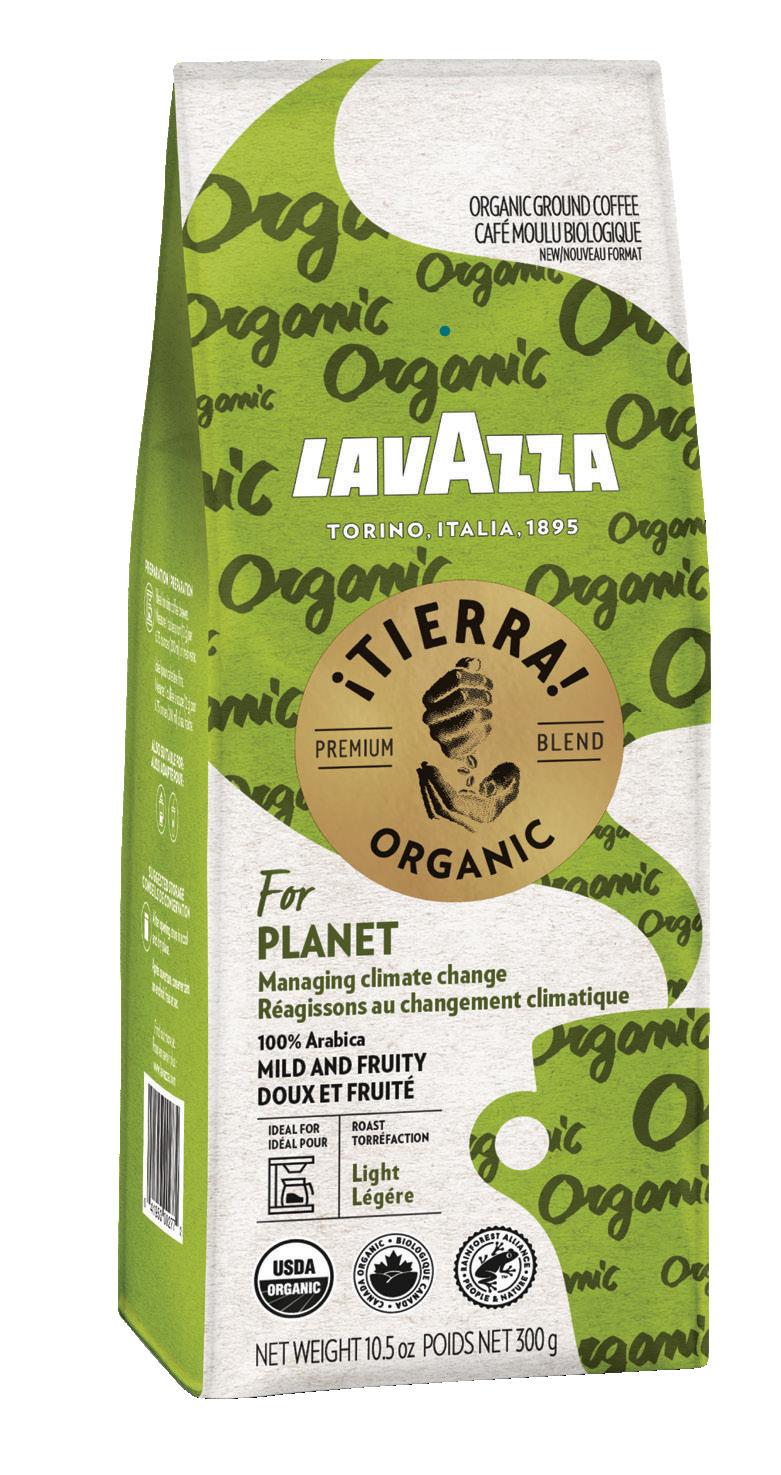

100% BIO ORGANIC FIND OUT MORE AT RA.ORG HAND PICKED COFFEE WE STRIVE TO TAKE CARE OF NATURE AND PEOPLE, LEARN MORE ON LAVAZZA.CA N E W ¡ T I ER R A ! O R GA N IC C O FF E E S
Consumers keen on sustainability and health benefits
These last few years have proven that Canada’s love of coffee wasn’t dampened even by a global pandemic. In fact, Canada is the only non-European country listed in this year’s top 10 coffee-consuming countries in the world! According to Nielsen, the Canadian coffee category is worth $1.46 billion, and data from global market research firm Mintel shows that 88% of Canadians shoppers bought retail coffee in the past year. The research also shows that 61% of people say coffee is an important part of their daily routine and 41% would pay more for a higher-quality cup of it too.


Here’s a look at what’s driving all this java love and what coffee trends are gaining favour in the foreseeable future.
Social responsibility/sustainability top of mind Millennials and Gen Zs are especially vocal about their desire for brands to use ethical and sustainable practices—and coffee is no exception. Coffee brands like Lavazza support sustainability projects in coffeeproducing countries, which in turn promotes social and environmental development in these communities. “Through its iTierra Foundation, Lavazza supports 130,000 coffee growers through 31 projects in 19 countries,” says Lauren Laventure, Trade Marketing Manager at Sofina Foods Inc., which distributes Lavazza. “This has been the core of the business for a long time, and these projects are improving living
Product Spotlight
conditions in these communities while also promoting entrepreneurship and economic autonomy.”
Coffee drinkers are getting younger According to the latest US National Coffee Data Trends report issued by the National Coffee Association, a record number of young adults (aged 18-24) are drinking coffee in 2022, with 51% reporting that they’d had some kind of coffee within the past day. Industry experts say the declining popularity of soft drinks in favour of ready to drink coffee is helping drive this trend among the younger set.
Alternative milks gaining popularity With a growing number of consumers going vegan, or dealing with dietary and health concerns, coffee drinkers are expected to keep turning toward non-dairy milk alternatives. Plant-based milks continuing to gain favour include almond, oat, soy, coconut, hemp and macadamia nut. According to Grand View Research data, the U.S. market-size value for non-dairy milks is expected to more than double in the next three years. Add-ins to boost health and well-being With society’s ongoing focus on better health, more and more coffee drinkers are also looking for healthy additives to their regular cup of joe. Whether its collagen to improve skin complexion and joint pain, or turmeric and cinnamon for their antioxidant properties, coffee is becoming the perfect vessel for additives that can boost metabolism and promote better health.
Mild and fruity with organic Arabica beans hand-picked from Africa, Central and South America, the brand supports the training of coffee producers in agricultural techniques to manage the effects of climate change.

Made from organic coffee beans from Peru and South America, the brand supports reforestation in degraded areas of the Rain Forest.

CATEGORY CLOSE-UP
SPECIAL PROMOTIONAL FEATURE IN CANADIAN GROCER || November 2022
coffee





1. SUBARU STARLINK® Connected Services are offered on an initial three-year free subscription on select trim levels. Customers are required to enroll in the SUBARU STARLINK® Connected Services program. To operate as intended, SUBARU STARLINK® Connected Services require a sufficiently strong cellular network signal and connection. See your local Subaru dealer for complete details. 2. Safety ratings are awarded by the Insurance Institute for Highway Safety (IIHS). Please visit www.iihs.org for testing methods. Visit us at subaru fleet .ca 2023 CROSSTREK 2022 FORESTER 2022 OUTBACK Innovative advance warning safety system that helps you avoid potential danger on the road. Subaru’s eye on safety. Full-time all-wheel drive for full-time confidence in motion. Superior drivability, outstanding control and handling you can count on. IIHS TOP SAFETY PICK+ On-board technology system connecting your Subaru to the world. 24/7 safety and convenience wherever you go.1 From innovative features to expert maintenance, plus leading resale value, Subaru brings safety to your drivers and value to your fleet. 2 welcome to uncommon peace of mind TM WHO’S WHO Annual directory of chains and groups in Canada 2022 Orderyour2022copyonlinetoday!Canadiangrocer.com/reports 2022
The new world of femcare
Comfort tampons, new packaging from U by Kotex that is focused on ComfortFlex design, as well as the rebranding of U.S.-based brand Cora, which has renamed its period items—The Comfort Fit Tampon, The Peace-of-Mind Pad, The Got-You-Covered Liner. Meanwhile, as consumers gravitate towards clean and ethical ingredients that resonate across the physical, emotional and planetary well-being axis, more businesses are introducing recyclable or even biodegradable packaging as well as plant-derived raw materials such as organic cotton, bamboo, sea weed and hemp. This is demonstrated by brands such as NIIMA in Canada, Daye in the United King dom and Rif Care in the United States, whose period products aim to provide not only efficacy but also sustainability that resonates with eco-conscious consumers. In fact, nearly two thirds of global con sumers reported in 2022 that they are worried about climate change and try to have a positive impact on the environment through their everyday actions, according to Euromonitor’s recent International Voice of the Consumer: Lifestyle Survey.
Marketing in femcare has also taken on a different tone, one that brings products’ health and emotional value— particularly comfort—to the forefront
hit by SoarinG inflation and the higher cost of liv ing, global consumers are more motivated than ever to flit between brands in pursuit of value in essen tials. And these days, value encompasses more than just a “nice” price but also quality, convenience, transparency, authenticity, sustainability and holis tic wellness. Such sentiment is increasingly reflected in product innovations, portfolio design and brand communications in feminine care, a category that most commonly refers to disposable sanitary prod ucts such as pads, pantyliners and tampons.
Indeed, consumers today are selective and mind ful about their spending. More than half of profes sionals working in the beauty and personal care space say value for money remains their customers’ most important priority, according to Euromonitor’s most recent Voice of the Industry: Lifestyle Survey. For businesses, this means putting tangible value creation at the forefront of brand positioning, and aligning their offerings and brand narratives with consumers’ priorities and preferences.
Health- and emotion-forward product enhance ments and marketing narratives form a key pillar of value creation in femcare. In fact, with a slew of new products, from tampons by U.S.-based Sequel that feature spiral grooves, which allow for even absorption, to period cramp-soothing tampons with optional CBD coating by U.K.-based Daye, busi nesses, especially insurgents, have been exploring new technologies and format designs to deliver tan gible benefits.
Marketing in femcare has also taken a different tone, one that brings products’ health and emotional value—particularly comfort—to the forefront. This is demonstrated in the Playtex launch of Clean
Lifestyle and regimen support offers another key avenue for value creation. With more female con sumers adopting an active lifestyle, underwear-style period pads—which typically offer mobility-assuring, comfort-enhancing features such as 360 leak protec tion, flexible movement and that are form-fitting— are gaining traction despite their higher prices, which many consider a fair trade for security and conve nience. Though the segment remains relatively small, its further penetration will likely contribute to the growth of overall pads, including slim/thin/ultra-thin pads, the fastest-growing segment within femcare.
Finally, expansion into adjacent categories that encompass skin, body and mind is another dimen sion of the value creation strategy. This has led to, and will likely continue to accelerate, a business drive to redefine femcare through a holistic well ness lens. In North America and Western Europe, for instance, skin care in recent years has become a natural extension of the holistic treatment of men struation, as explored by femcare brands such as Rael in the United States, Blume in Canada and Synk Organic in Australia, and sexual wellness and incon tinence care are the next two logical adjacencies to consider for femcare brands, which are already tack ling women’s below-the-waist taboo.
The elevated expectations of efficacy, convenience and, ultimately, value among consumers includ ing women, coupled with a more deeply entrenched penchant for wellness, will continue to underpin business strategies to further enhance femcare prod ucts in terms of comfort, performance and lifestyle adaptability, as well as to explore adjacent women’s wellness categories in the years to come. CG

November 2022 || CANADIAN GROCER 21
BEHIND THE TRENDS || Liying Qian
Today’s feminine care consumer has elevated expectations when it comes to efficacy, convenience and value
Liying Qian is head of tissue and hygiene at Euromonitor International, an independent provider of strategic market research. Euromonitor.com
Coming soon!
New!
Change is good, especially when it’s this yummy.
To our valued retail partners, I’m Natasha Questel, President of Happy Planet Foods.

We’re making big, bold changes over at Happy Planet and I wanted to personally reach out to share some exciting news.
As you know, we are seeing real shifts in the tastes and shopping habits of Canadians. Consumers are looking for higher nutrition and function in the forms of higher protein, less sugar, more fiber, and powerful ingredients like sustainable grains and superfoods. As a result of this shift, we’ve made the decision to discontinue production of all of our fruit smoothies as of this fall.
We know change can be hard and it’s definitely a bold move –but we’re a brand known for making bold moves that are better for people and the planet.
What does this mean for you? The launch of some exciting new innovations in drinkable snacks under our Mornin’ Oatz and Clean Protein ranges - that are higher in nutrition and better for the planet, made with supergrains and superfoods that are ethically and sustainably sourced.
We are also starting to transition away from plastic bottles to sustainable plant-based cartons.

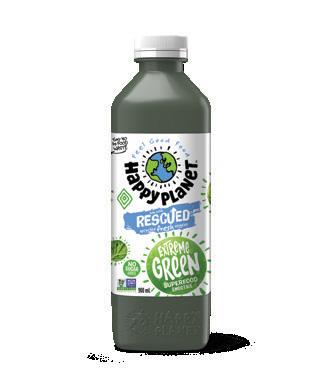
Our brand new Mornin’ Oatz Breakfast Shake, offers the goodness of a bowl of oatmeal in the convenience of an on the go shake. Launched this spring, it features 10g protein, 10 vitamins and minerals from real oats and fruit, milk, hemp, flaxseed and fonio - a super grain sourced from farmers in Mali, Africa, which thrives in regions struggling with the impacts of climate change.





Plus this fall, we’re bringing new flavours to our indulgent plant-based protein line, Clean Protein Plant-Based Shakes. Each shake contains 10 grams of protein and 70% less sugar than leading brands and will be available in a variety of decadent flavours, including Banana Cashew, Chocolate Coconut and Blueberry Almond Butter.
To the retailers that have been part of our Happy Family over the past 30 years - thank you. We couldn’t have built this brand without you, and we’re so excited to keep
When evaluating distinguishing behaviours among this group, per capita consumption rates of fresh food items are considerably lower among modest income consumers when compared to individuals in higher income households
Cracking the modest income shopper code
• While those in modest income households are more often motivated to save money, they do not show stronger development for buying in bulk or taking advantage of specials or promotions.
• They do shop more often at discount grocery stores, mass and dollar store channels, while sourc ing fewer items at Costco, foodservice and online channels; however, it should be noted that this is not new behaviour.
• They make fewer weekly major grocery trips, while instead making more quick re-stock and emer gency pickup trips.
• They rely more heavily on private-label products, which generally have a lower price. Again, this is not new behaviour.
When evaluating distinguishing behaviours among this group, per capita consumption rates of fresh food items are considerably lower among modest income consumers when compared to individuals in higher income households. In fact, they consume less fresh meat and fewer fresh fruits and vegetables, in part, due to the higher cost of these products. Con versely, they do, however, consume more frozen food options and this is driven by value.
the cultural conceptS of thrift, frugality and waste avoidance are engrained among many Canadi ans. In fact, the notion of “a penny saved is a penny earned” is often viewed as exemplary and principled.
However, with food prices today reaching a 41-year high, Ipsos FIVE consumption study’s latest data reveals that saving money is often a necessity rather than a habit practiced out of fiscally minded principles. Today, nearly one in four Canadians (23%) resides in a household with an annual income below $40,000. Further, one in five individuals (20%) resides in a household with an annual income between $40,000 and $60,000. In aggregate, nearly 44% of Canadians live in modest income households.
The data reveals that these consumers, because of economic circumstances, have different habits when it comes to assessing value for money spent and saving money. In fact, these individuals are less likely to participate in couponing activities, perhaps with less time and fewer resources to aggressively hunt for deals. Ongoing tracking reveals that less than half of those living in modest income house holds (42%) used a coupon in the past three months, though usage rates did increase 12% when compared to the previous three-month period.
Beyond the time and effort required to use cou pons successfully, we evaluated whether those in modest income households engage in other promo tional activities. Here’s what we found:
While Canadian grocery retailers continue to strategize how to provide value to all shoppers, it is important to understand how to target those in the modest income tier to grow your customer base. Consider the following strategies:
1 Geo-targeting coupon activities to enable auto matic downloads upon store entry to eliminate the hassle of logging in or loading coupons.
2 Waving delivery fees for those customers living in modest income households based on reasonable minimum trip spends.
3 Reward private-label loyalty based on cumulative purchases over a monthly period.
It’s worth noting that the share of Canadians who now reside in modest income households, and who are required to weigh food and beverage expen ditures against other necessary expenses, may be larger than previously thought. And while these shoppers are price sensitive, their sheer size and loy alty to retailers who can crack the price, convenience and selection code will undoubtedly be rewarded as we continue to wade through inflationary headwinds and rising prices. CG
Kathy Perrotta is a VP of market strategy and understanding with Ipsos Canada and leads the FIVE service, a daily diary tracking of what individuals ate and drank yesterday across all categories/brands, occasions and venues. Kathy.perrotta@ipsos.com

November 2022 || CANADIAN GROCER 23
EATING IN CANADA || Kathy Perrotta
As grocers seek to provide value to all shoppers, it’s important to understand how to target those with modest incomes
It was a packed house at Mississauga, Ont.’s International Centre on the morning of Sept. 28 as the grocery industry turned up to celebrate Canadian Grocer’s 2022 StAr WOMEN IN GrOCEry winners. “The Star Women in Gro cery Awards is one of the key ways this industry celebrates talent and achievement every year. It is so important that we continue to take the time to recognize those who are doing great things in the grocery industry,” says Vanessa Peters, publisher of Canadian Grocer.








The awards breakfast returned to an in-per son event for the first time since 2019, and more than 500 members of the industry attended the sold-out event honouring this year’s 49 winners for their career achievements and contributions to the industry. The morning kicked-off with an inspirational keynote on courage from UNFI president, and past Star Women winner, Stacey Kravitz. Another highlight was a powerful panel discussion featuring Bonnie Birollo of Sobeys, Janet Rickford of Loblaw Technology/Loblaw, P&G’s Shilpa Mukhi, Jessica Armstrong of Maple Leaf, Metro’s Louisa Furtado and Stephanie Goyette of Kraft Heinz Canada where panelists shared lessons learned and touched on topics such as navigating life as a working parent, building more inclusive workplaces and the power of vulnerability (read more on page 15) CG

24 CANADIAN GROCER || November 2022 GOLDMEDIA.CA
TIME
TO SHINE!




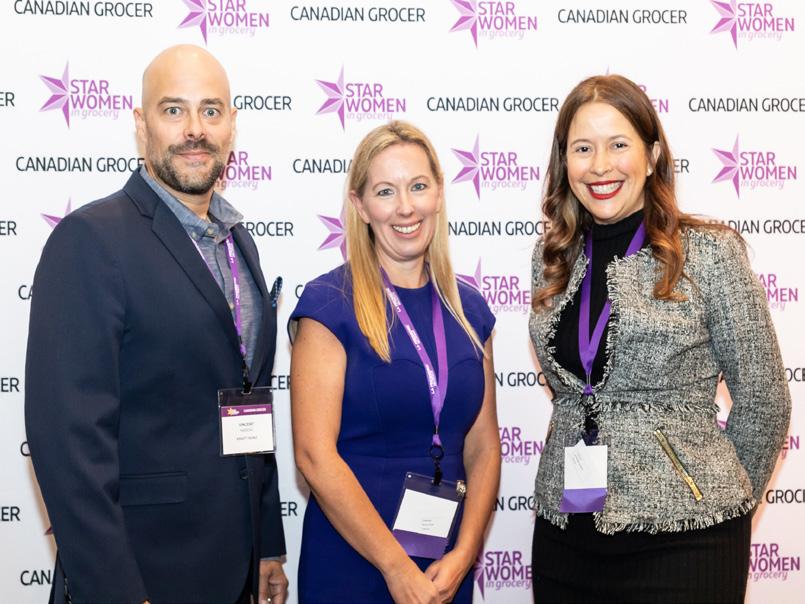





November 2022 || CANADIAN GROCER 25


THIS BLUE COW DRIVES BUSINESS TRUSTWORTHY HIGH QUALITY GREAT TASTING 3-in-4 Canadians associate these statements to products featuring the Blue Cow Logo REQUEST YOUR LICENSE NOW AWARE OF THE BLUE COW LOGO of Canadian consumers are86% ENCOURAGES PURCHASE Canadians say it4 in 5 Based on research provided by IMI, Q1 2022 https://dairyfarmersofcanada.ca/en/blue-cow-logo/producers/apply 100% CANADIAN MILK HIGH CANADIAN BLUE COW LOGO STANDARDS. STANDS FOR. That’s what the
Canadian dairy farmers commit to
net-zero greenhouse gas emissions by 2050
As part of the dairy industry’s ongoing commitments to sustainable milk production, Dairy Farmers of Can ada (DFC) is committing to a goal of net-zero greenhouse gas (GHG) emissions by the year 2050. Reaching ‘net zero’ will be done through emissions reduction and GHG removal off sets. Other strategies will include qualitative targets related to soil and land, water, biodiversity, waste, and energy.
This objective was formally announced in February 2022 and aligns with the Canadian government’s emissions reduction strategy. As Pierre Lampron, president of DFC, explained, “We are bearing witness to the impacts of climate change first-hand, on our farms and at our doorsteps.” It is no longer a question of how our livelihoods will be affected by cli mate change, Lampron said, but rather a question of how we will be affected if we don’t act now.
Fortunately, Canadian dairy farmers are naturally com mitted to environmental sustainability due to the nature of their work: not only do dairy farmers rely on the land to make a living, but many farms are passed down within a family, so being able to keep thriving on that land is imperative for today – and tomorrow. Building on this long history of environmen tal stewardship, DFC’s net-zero goal is an extension of the efforts Canadian dairy farmers are already taking to be part of a global sustainability solution. For example, from 1990 to 2019, Canadian dairy farmers reduced the carbon footprint of milk production by 22 per cent through improved manage ment practices.
“For generations now, Canadian dairy farmers have been stewards of the land, adapting their practices based on sci ence and innovation,” says Pierre Lampron, President, Dairy
Farmers of Canada. “Our leadership in the area of sustainabil ity is already recognized internationally, as we have one of the lowest carbon footprints per litre of milk produced.”

DFC’s net-zero goal aligns with worldwide commitments, as well. The Paris Agreement, for instance, aims to foster climate resilience and lower greenhouse gas development, as well as to make climate flows consistent with a pathway toward a lower carbon future. Last fall, DFC joined 11 of the world’s largest dairy organizations in supporting Pathways to Dairy Net Zero, a Global Dairy Platform-sponsored commit ment towards net-zero GHG emissions.
“A global effort is underway to cut emissions and reduce the direct costs of climate change on our health, our envi ronment and our economy,” says Steven Guilbeault, the federal Minister of Environment and Climate Change. “Every economic sector and every region needs to step up to reduce emissions. The Dairy Farmers of Canada’s com mitment to achieving net-zero shows important leadership and our Government will continue to support our collective efforts to get there.”
This dedicated stewardship has led to the adoption of improved techniques based on research and innovation, which is why it now takes six per cent less water and 11 per cent less land to produce a litre of milk than it did just a decade ago. Dairy farmers also lowered GHG emissions by seven per cent in that same timeframe. Few industries can report that kind of progress and we are incredibly proud of what we have accomplished together.

For more information on DFC’s Net-Zero 2050 announce ment, please visit dairyfarmersofcanada.ca
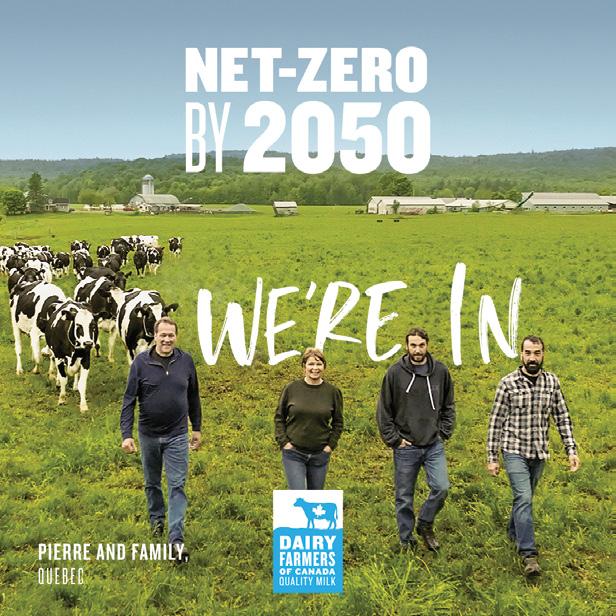
SPECIAL PROMOTIONAL FEATURE IN CANADIAN GROCER–NOVEMBER 2022
Manseau


















































from your friends atCongratulations Carmen Fortino and Michel
on your 2022 Golden Pencil Award!
GROCERY’S GREATS THE 2022 GOLDEN PENCIL WINNERS
By Shellee Fitzgerald Photography by Mike Ford
A
November 2022 || CANADIAN GROCER 29
Metro exec with deep family roots in the grocery business and a veteran of one of Canada’s largest tissue product companies are this year’s recipients of the prestigious Golden Pencil Awards. Presented annually by the Food Industry Association of Canada since 1957, the awards recognize an individual’s lifetime contributions to the grocery industry and their communities. Read on to learn more about this year’s outstanding winners Metro’s Carmen Fortino and miChel manseau of Kruger Products.
The Golden Pencil Awards ceremony will take place at Toronto’s Fairmont Royal York Hotel on November 21. For tickets visit groceryconnex.com Golden Pencil
CARMEN FORTINO Executive vice-president, national supply chain and procurement Metro
CARMEN FORTINO’S roots in grocery run deep.
He got his start at age 15, with a part-time job at a Dominion (a chain that Metro would eventually acquire) in Stoney Creek, Ont. Later, he went to work in the family business—Fortinos Supermarkets. He stayed on after the family sold its Ontario grocery stores to Loblaw in 1988 and by the time he parted ways with Loblaw, in 2007, he had ascended to the post of executive vice-president, Loblaw, Ontario region.

After a seven-year stint in the health and wellness sector, Fortino says a “fateful” meeting with Metro CEO Eric La Flèche ultimately wooed him back to gro cery. “Our one-hour meeting turned into four hours and subsequent meetings after that, and it got my juices flowing,” recalls Fortino. “Once grocery is in your blood, it’s there.”
Since joining Metro in 2014, Fortino has success fully led the retailer’s Ontario division and has added national supply chain to his responsibilities. Currently, he is transitioning to the role of executive vice-president national supply chain and procurement.
When asked how he accounts for his success, For tino is quick to say it’s about “being surrounded by great people.” His approach to leadership is to create an environment where making a mistake is not the
end of the world. “I don’t like to live in the safe zone. I like to push the envelope and try things and see what works and what doesn’t,” he says. “A big emphasis for me is creating an environment of trust where people can be themselves and express themselves and where we all learn from each other’s triumphs and mistakes.”
He credits his dad, Luciano, for his work ethic. “My dad was a huge influence on my life,” he says, adding that his father, an immigrant from Italy, helped set his emotional intelligence compass and instilled in him the importance of hard work. “I remember when I started my first job at Dominion, I was nervous, and I remember him telling me like it was yesterday: ‘Just make sure you give them 10% more than what they’re expecting and everything will be fine.’ I learned a lot from my dad.”
In addition to being “extremely” proud of his roots in the Fortinos’ business, Fortino says he’s proud to have joined Metro. “Metro was a relatively young Ontario company at the time. It acquired all A&P, Dominion, Miracle Mart, The Barn, Loeb—there were a bunch of different businesses that it acquired in the Ontario land scape, and I was lucky enough to get involved at a time when I could help weave all those different cultures into one culture, called Metro, which I’m really proud of.”
30 CANADIAN GROCER || November 2022
Golden Pencil
A proven track record of driving results with a customer-first approach.



























Carmen Fortino is from a family of grocers, but his passion for his work and his colleagues, has been his own since starting with the family business in 1985. Carmen has long believed that when you love what you do and when people are your passion, then it is impossible to be bored.



The METRO team congratulates Carmen Fortino on his Golden Pencil Award and his lifelong dedication to the Canadian food industry.






 Carmen Fortino Executive Vice President, National Supply Chain and Procurement
Carmen Fortino Executive Vice President, National Supply Chain and Procurement
MICHEL MANSEAU
Senior vicepresident and general manager, consumer business Canada
Kruger Products
WHEN MICHEL MANSEAU joined Kruger Products (then Scott Paper) back in 1988, he couldn’t know he’d spend the next three decades with the tissue company.

“You never know when you start with a company how long it’s going to last. I think the honeymoon has been pretty good,” he jokes.
Manseau’s earliest days with the company were as a sales rep in Montreal, calling on retail stores. He quickly moved up the ranks at the organization in various sales roles that took him to the United Kingdom and eventually to Toronto, where he’s been based since 2004. He joined Kruger’s leader ship team in 2006 and was promoted to his current role as senior vice-president and general manager, consumer business Canada in 2018.
Not one who’s comfortable in the spotlight, Man seau is modest about his achievements and gives a lot of credit to his team. “I love people and I’m a firm believer that it’s people that make a difference to the company’s success.” As a leader, Manseau sees his role as an “enabler,” one who gives his team the tools to help them be their best. “And I’m a leader who’s not looking to be right. I listen. I like to chal lenge ideas and I like my ideas to be challenged. If we
always agree and say the same thing, we’re not going to be successful.”
Manseau describes himself as a hard worker who is engaged and disciplined—qualities he says are inherited from his parents. “My dad was super disci plined and had high standards and my mother gave me positivity, curiosity and a never-quit attitude.”
Among his career highlights, Manseau points to the successful transition of the company’s brands after Kruger purchased Scott Paper as something he’s particularly proud of. “I think we did it well and it allowed us to double the size of the company.”
More recently, he’s proud of how the company ral lied during the COVID -19 crisis, efficiently managing supply amid a consumer frenzy around paper prod ucts, especially toilet paper. “We implemented a lot of things to maximize the output of our lines and supply as much as we could in the market.”
And what keeps Manseau passionate about his work after more than 30 years? “The grocery indus try is one of the best industries, from my stand point,” he says. “I’ve met so many great people over the years, and even if the industry has become a little bit more challenging, it’s still a people business that touches consumers’ lives every day.” CG
32 CANADIAN GROCER || November 2022
Golden Pencil





Payment trends
NOT LONG AGO, paying for goods was just a means to an end—the way cus tomers were able to get their items from their carts and into their trunks. Now, payments are no longer an afterthought. They’re an integral part of the shopping experience, as new options beyond the classic “cash or card” are meeting chang ing consumer needs. In this new age of payments, grocery retailers can’t afford to get left behind.
“Adapting the way you run your busi ness and having options for how people can pay is key to both attracting and retaining customers,” says Jon Purther, director of market insights at Payments Canada, a not-for-profit organization that owns and operates Canada’s pay ment clearing and settlement infrastruc ture. “If businesses limit their payment options, they’re going to potentially elim inate or put up an obstacle for customers who may have been interested in making a purchase, but because of the payment option just don’t shop there.”
As the payments landscape evolves, the pressure is on retailers to stay on top of new payment options and respond to consumer shifts. “Retailers need to listen to what their customers are asking for and watch what their competitors are doing, and adapt their business accordingly,” says Purther. “Knowing what new tech nologies are out there and being nimble is important in allowing [retailers] to adapt.”
So, what trends in retail payments should grocers pay close attention to? Here’s a look at what’s here today and here to stay:
No going back from digital payments
During the pandemic, many shoppers discovered the convenience of contact less payments, which kept their hands off potentially germy terminals. The Canadian Payment Methods and Trends 2022 report by Payments Canada found that since the pandemic started, 43% of Canadians tapped their credit card and 42% tapped their debit card when paying at a store. In addition, 43% agreed the pandemic has changed their payment preferences to dig ital and contactless for the long-term.
Mobile payments also continued to increase through 2021 (the latest year tracked by Payments Canada). Mobile payment volume and value each grew by 13% from 2020. Since the pandemic started, 45% of Canadians who used their
WHAT RETAIL PAYMENT TRENDS ARE HERE TO STAY?
the heavy lifting [for retailers]. So, the pandemic and the paytechs really act as a catalyst to create change in Canada for us to become more digital.”
The (almost) end of cash and cheques
As the use of digital payment methods increases, it comes at the expense of good old-fashioned cash and cheques. According to the Canadian Payment Methods and Trends 2022 report, cash transaction volumes decreased by 62% from 2016. More than half of Canadians (53%) report using cash less often since the start of the pandemic and 31% report using cheques less often.
With paper payments going the way of the plastic bag, Canada is inching closer to becoming cashless. “Are we moving towards cashless? Absolutely. But we need to be thoughtful about how to do that,” says EY Canada’s Halder.
By Rebecca Harris Illustration by Gary Neill
Halder points to Rogers’ massive ser vice outage this past summer, which left millions of Canadians without internet and wireless services. “That impacted our debit network,” says Halder. “And so, as we move towards digital payments and digital interactions, we need to put in the right controls from a redundancy standpoint so if there is another outage, our systems will continue to run in a seamless manner.”
mobile wallet to make store purchases said they were using it more than they used to. “We expect that digital payment options like contactless and mobile pay ments is absolutely going to continue,” says Purther. “Canadians who tried it and switched over will not be going back.”
Diana Halder, payments leader at EY Canada, says the pandemic was one of two main factors behind the surge of digital payments. “With everything being shut down, we still had to move forward as a society and be able to make purchases,” she says. “And so, we had this move towards digital payments, online pay ments, mobile payments and even using QR codes to initiate payments,” she says.
The second factor is the rise of fintech and paytech companies, the latter of which focus on payments and transac tions. “Paytechs are making apps turn key for merchants, so they don’t have to spend reams of money,” says Halder. “They create that digital experience, which connects to the payment gate ways, with the paytechs basically doing
Payments Canada’s Purther agrees we’re moving toward becoming cashless, albeit slowly. “It won’t be tomorrow that the world will be cashless,” he says. While Payments Canada data shows 50% of consumers believe stores could become completely cashless in the next 10 years, 42% said not being able to use cash to buy goods would make them anxious. “Even if it’s not their primary or preferred pay ment method, Canadians like knowing they have the option to use cash when need be,” Purther says. “I think for both consumers and businesses, the more pay ment options the better.”
Loyalty programs and payments become one
While the days of fumbling around for punch cards and coins are long gone, it’s still a pain point for customers to have to pull out two pieces of plastic—their loy alty card and bank card—or two separate apps. This is the next battleground in the payments space, as loyalty programs can now integrate payments.
» November 2022 || CANADIAN GROCER 35
Contactless is in and cash is out, as savvy retailers give shoppers new ways to pay
Payment trends
“Retailers are rethinking their loyalty programs and payments is becoming a big weapon in terms of how to improve the loyalty offering,” says Marty Wein traub, partner, national retail leader at Deloitte Canada. “By offering a way for a customer’s payment to be connected to their loyalty card, they’re reducing fric tion and increasing the engagement rate. From a customer perspective, it’s just a cleaner, simpler experience.”
One retail example is loyalty pioneer Starbucks, which gave its members more ways to pay in 2020. Rather than just accept preloaded gift cards as payment, Starbucks Rewards lets members link their credit, debit or select mobile wallet accounts to pay within the app. In the gro cery sector, a first-mover is Germany’s Lidl, which launched a mobile payment option inside its Lidl Plus loyalty app in 2020.
Integrating loyalty and payments can potentially have big bottom-line benefits for grocers. In the global 2022 Retail Report by payments firm Adyen and KPMG, 57% of consumers surveyed said they would be more likely to shop with a retailer if the retailer's loyalty program worked auto matically through their payment card. As Adyen notes in a blog post on its retail report: “Payment-linked loyalty, espe cially when sales channels are connected through a unified commerce solution, can help businesses capture richer data insights, understand shopping prefer ences, assign loyalty points, and better anticipate customers’ needs.”
Ales Novak, a principal director who leads Accenture’s Canadian payments practice, says having a good loyalty pro gram will arguably be the most import ant differentiator in the coming years. Loyalty programs help attract and retain customers, and they allow retailers to understand their customers better through data, he says. “But more impor tantly, your loyalty program sets you ahead for what’s to come in the new and next generation of payments.”
Real-time payments becoming a reality
There may be a lot of exciting tech possi bilities with payments, but the reality is, Canada is still a work in progress. “We’re still evolving when it comes to payments when you compare Canada to other mar kets, such as Asia Pacific, Australia, Saudi Arabia, the United Kingdom and Sweden,
which have very sophisticated payments landscapes,” says EY Canada’s Halder. “However, we’re making investments in modernizing our infrastructure, which is foundational. You can’t necessarily pro vide faster, richer digital payments if you don’t have the foundation in place.”
Those modernization efforts are paving the way for real-time payments that are initiated, cleared and settled in a mat ter of seconds. As part of a multi-year payments modernization initiative, Pay ments Canada is building Canada’s first real-time payment system, the Real-Time Rail (RTR), which is expected to go live in 2025. The organization says RTR will sup port faster, data-rich payments and act as a platform for payment innovation and competition. Canada is one of more than 50 countries that have implemented—or are in the process of implementing—realtime payments capabilities.
For retailers, the benefits include bet ter cash flow management, cost savings through lower transaction fees, and an enhanced customer experience. And it’s not just about the need for speed. “As the money moves, it sends rich data along with it, like what is the purchase, what’s the location, what is [the customer’s] loyalty information,” explains EY Can ada’s Halder. This would allow retailers to develop more targeted campaigns and provide tailored product recommenda tions. “[Real-time payments] allow the average merchant the ability to replicate some of Amazon’s techniques,” explains Halder. “They can compete.”
On the cost-savings front, Accenture’s Novak says around the world, real-time payment capabilities are driving innova tion and competition. “The availability of these new technologies will drive new, innovative ways of bringing payment to the front end,” he says. “As a result, this will put more pressure on reducing mer chant service charges through competi tive reasons rather than regulation.”
Biometrics and BNPL on the distant horizon
In the brave new world of payments, bio metrics could be the next evolution. In the United States, Amazon is rolling out Amazon One—a contactless payment option that lets customers link their palm print to their payment card—at select Amazon Fresh and Whole Foods Market locations. U.K. grocery chain Tesco is
reportedly introducing biometric pay ment methods, including face and palm recognition, at checkout early next year. And Mastercard introduced a biometric card that combines chip technology with fingerprints to verify cardholders’ identi ties for in-store purchases.
In Canada, biometric payments hav en’t quite taken off. “It’s just not at scale right now,” says Deloitte’s Weintraub. “[Retailers] had a bit of a pause around innovation over the last couple of years because of the pandemic and a lot of cap ital was going into just keeping afloat, quite frankly.” But, with the pandemic now behind us, Weintraub says: “I think we’re going to see a reset around retailer innovation approaches, where they start investing and innovating in this space.”
Another new payment method that might take hold is “buy now, pay later” (BNPL), a modern take on the classic lay away model. Through BNPL companies like Afterpay and Affirm, customers can buy products online or in store and pay for them in installments, typically with no interest when payments are made on time. And unlike traditional layaway, consumers can get their goods right away.
According to the Canadian Payment Methods and Trends 2022 , only 8% of Canadian merchants currently offer BNPL, but nearly half (45%) of those not offering it have indicated they are inter ested in doing so.
“We are seeing big growth in the buy now, pay later model because there are a number of benefits,” says Payments Can ada’s Purther. “For the consumer, there is ease and convenience. From the mer chant standpoint, they can potentially get customer business or consumer spending they wouldn’t have gotten otherwise.”
While it might be a stretch for custom ers to put their groceries on a modern-day layaway plan, BNPL could gain traction in the sector. “I think all industries are look ing at [BNPL] and considering whether it will work for [their sector],” says Pur ther. “I can’t comment specifically as to whether the grocery industry will jump on board—we have not measured the gro cery industry on that. But I will say this: Absolutely the grocery industry is going to look at this and see whether there is potential. I would not be at all surprised if someone does at least pilot the idea. But no doubt, consideration is going to take place.” CG
36 CANADIAN GROCER || November 2022

BUSINESS BRING IT ON. 2 Your industry. Your agency. If you’re competing in B2B you need a strategic creative partner that knows your industry inside and out. Only EnsembleIQ’s BrandLab offers full-service marketing capabilities and deep experience across retail, CPG, and technology, infused with industry knowledge and marketing intelligence. ensembleiq.com/marketing | brandlab@ensembleiq.com










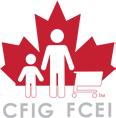







MICHEL MANSEAU SVP & GM, Canadian Consumer Business Unit, Kruger Products MARK TAYLOR President & CEO, Lactalis Canada CARMEN FORTINO EVP, Ontario Division Head and National Supply Chain, Metro GERALDINE HUSE President, P&G Canada DARRELL JONES President, Pattison Food Group GREG RAMIER President, Market Division, Loblaw Companies Limited ERIC LA FLÈCHE President & CEO, Metro DANIEL BURRUS Global Futurist, Strategic Advisor, and Best-selling Author WENDY OUTRAM VP North America Procurement, Grupo Bimbo Monday, November 21, 2022 10:00 am - 6:00 pm (edt) • Fairmont Royal York, Toronto FUTURE FORWARD Attend the premier event for Canadian grocery executives GroceryConnex.com Now a full day event featuring: Exclusive GenNext Partner: Gold Sponsors: Silver Sponsors: Keynote Speaker Sponsor:Presented by: Industry Partners: Lunch Sponsor:Coffee Sponsor: Grocery Connex
Self-checkout
CHECKING IN ON SELF-CHECKOUT
By Rosalind Stefanac
FOR YEARS, GROCERS have been looking to self-checkout stations as a way to reduce labour costs, often directing reluc tant consumers this way in spite of issues with not-so-intuitive technology. But now, for the first time, a significant number of shoppers are actively seeking a frictionless shopping experience that self-checkouts can finally accommodate.
According to the latest data from The Food Industry Associa tion (FMI), 29% of transactions at food retailers were processed through self-checkout in 2020, up from 23% the year prior. In the meantime, major retailers like Kroger and Walmart are pilot ing self-serve checkout-only stores in locations throughout the United States and Canada.
“More and more, technology is making the self-checkout expe rience flawless—I can’t remember the last time I had problems using these systems, compared to years ago,” says Sylvain Charle bois, senior director of the Agri-Food Analytics Lab at Dalhousie University in Halifax. He points to a 2021 survey conducted by Dalhousie in partnership with Caddle (the largest daily active survey panel in the Canadian market), showing that 75% of Cana dians have used self-checkouts while visiting the grocery store at least once in the past six months. Moreover, 85% of respondents said they were satisfied with their experience and 47% said they’d
be willing to visit a cashier-less grocery store in the future.

“I think before COVID -19 it was seen as more of an experiment, but the commitment is quite clear now,” says Charlebois. “We’re finally seeing retailers adopting the right technologies to make the exit experience flawless for consumers.”
FACTORS DRIVING SELF-CHECKOUT
While the pandemic was destructive on so many fronts, industry experts agree it was a catalyst in accelerating the adoption of self-checkouts. “Along comes the pandemic and people don’t want to linger in stores anymore, they don’t want to talk to peo ple and so self-checkouts get a very big turbo boost,” says Marty Weintraub, partner, national retail leader at Deloitte Canada.
Retailers are also feeling the heat with current labour short ages in the sector. Grocers know long lines and poor service that deter customers from shopping, will inevitably feed through to their bottom lines; self-checkouts can help. The 2022 Global Self-Checkout Systems Industry report notes that the global market for self-checkout systems is expected to grow 11.9% year over year to 2026. Supporters of self-checkout also contend that existing staff can be better used to provide direct assistance as needed and avoid repetitive tasks that can be automated.
November 2022 || CANADIAN GROCER 39 GETTY IMAGES/FATCAMERA
»
As technology improves,
shoppers are more willing to skip the line and do their own checking out at the store











MINGLE • GIVE • REJOICE Get tickets at nighttonurture.caGet tickets at nighttonurture Jason Derulo Saturday, January 28, 2023 • Metro Toronto Convention Centre
Weintraub says another key factor contributing to the increas ing adoption of self-checkouts is the variety of technology options emerging, from traditional, scan it yourself versions to A.I.-driven, computer vision options that do the scanning for you (see more on these technologies below). “The checkout process is the highest friction pain point in the shopping expe rience, especially in food, but we’re going to see more and more technologies that address that,” he says, noting that grocery retailers are increasingly experimenting with cashier-less store formats, similar to the one Amazon pioneered with its Amazon Go model in 2018.
WHAT’S STALLING WIDER ADOPTION?

There’s no doubt that cost is still a factor preventing widespread adoption of these technologies, especially when it comes to com puter vision, says Weintraub. “Obviously a store of 50,000 to 100,000 square feet with 80,000 SKUs is a different story than [putting cameras] into a small footprint format,” he explains. “But the technology is getting cheaper and more accurate and people are starting to be more comfortable with being watched.”
Another challenge is that there are still consumers who aren’t keen on a cashier-less future. If reaction to Tesco’s plans to replace staff tills with more self-checkout is any indication, some are vehemently opposed to it. Nearly 240,000 people signed a petition started by 69-year-old retiree Pat McCarthy this summer, calling on the British multinational grocer to stop the rollout of self-checkout machines and bring staff back. “What used to be a great shopping experience has now become physically difficult, overwhelming and a nightmare,” she wrote in the petition started on change.org.
Self-checkout

Sentiments from Canadians and Americans on social media on this side of the world indicate a similar attitude with a “say no to self-checkout” Facebook group and anti-checkout posts actively circulating.

And while self-checkout technology has vastly improved of late, Charlebois notes that the systems aren’t universally wel coming just yet. “Hundreds of thousands of Canadians live their lives with cash only, for example, and some of these machines don’t take cash,” he says. “Plus, when I look around and see who is struggling with the technology, it’s often a senior.” That’s why for the next while at least, he says it’s essential for grocers to recognize that some demographics aren’t comfortable with self-checkout, so human intervention is still critical.
Charlebois also suggests grocers find ways to incentivize shoppers to self-checkout. “Over the long-term, the percep tion will likely disappear but for now there is a lot of work to self-checkout at the grocery store compared to buying a T-shirt in a retail setting,” he says, noting that people generally prefer assistance when they’re checking out more than 10 items.
“I don’t think we’ll ever get to the point where you’re com pletely on your own—a hybrid method is more likely where there are [live] people making self-checkout more palatable,” says Ransom Hawley, founder and CEO of Caddle. “But as tech nology continues improving and removing the friction from checking out, I think Canadians are going to embrace it.” In fact, results from a survey conducted by Caddle in September 2022 show that not only are 48% of Canadians across demographics extremely or moderately familiar with ‘scan-and-go’ technology, 65% are somewhat or very likely to use self-checkout for items other than grocery, too.

NEXT-GENERATION TECHNOLOGY TRANSFORMS THE SHOPPER EXPERIENCE
New options in cashier-less checkout are dramatically improving the grocery shopping experience. Here’s a look at key technologies in the works now.

Intuitive scanning: Mashgin, based in Palo Alto, Calif., is one of several companies perfecting next-generation self-checkout machines that use computer vision to identify and ring up items automatically. Mashgin’s machines allow customers to check out in as little as 10 seconds, with an accuracy rate of 99.9%. Already the technology has been successfully piloted in 500 Circle K stores with plans to install them in another 7,000 locations over the next three years.
Earlier this year, Asda became the first grocery chain in the
United Kingdom to test selfcheckout terminals equipped with age-verification software for consumers purchasing alcohol. Shoppers are asked to look into the system’s camera and the software estimates their age; if the system determines the person looks younger than 25, they can prove their age by scanning their ID.
Smart carts: A screen attached to a physical, A.I.-equipped grocery cart allows grocers to display product information as shoppers scan items they put into the cart; they can also apply coupons and pay without going into a checkout line. Sobeys was among the first grocers in Canada to pilot smart carts at one of its Ontario locations and has since introduced them
to Atlantic Canada. Amazon recently updated its Dash Cart so it is now capable of carrying more groceries and allows customers to wheel the carts to their cars. Dash Carts are available in Amazon Fresh stores and made their debut at certain Whole Foods Markets in the United States this year.
Cashier-less stores: Fully autonomous checkout technology (using computer vision) allows shoppers to identify themselves via an app or avatar when entering or exiting the store, and “grab and go” without checking out at all. In stores like Amazon Go, cameras, shelf and RFID sensors are used to detect the grocery items a shopper adds to their smart bag or cart and payment
is made later through an app. At French retail giant Carrefour’s Flash 10/10, a network of cameras on the ceiling are used to monitor shoppers as they move through the store. Each customer is allocated an avatar as they enter and the products they pick up are automatically detected and added to their virtual baskets. Once finished, customers pay at a contactless kiosk and have their receipt sent to them immediately.
November 2022 || CANADIAN GROCER 41 ASDA
»
Self-checkout
But, there is another key issue irking grocers with self-check out: increased shrinkage. In North America, grocers experience billions of dollars in losses as a result of shoppers (and employ ees) neglecting to scan items during checkout. “The biggest issue we’re starting to see, because there are a lot more self-checkout units deployed, is a lot of risk around shrink, and some of that is malicious and some of it is not,” explains Deloitte's Wein traub. “The economic situation, unfortunately, is driving more malicious theft and there are a number of retailers right now struggling with this.”
In addition to deploying more staff to oversee self-checkout kiosks (which can be difficult with current labour shortages), grocers are turning to technologies using computer vision to thwart thieves. In 2020, U.S. grocery giant Kroger partnered with Irish artificial intelligence firm Everseen for technology that uses computer vision cameras to detect if a shopper is skipping scans. When they do, a video pops up to remind them and if that fails, the technology discreetly alerts an employee to intervene.
As the technology around computer vision continues to prog ress, Gary Hawkins, CEO of the Center for Advancing Retail & Technology (CART), expects its benefits will extend beyond the checkout process throughout the entire grocery store. “I see traditional self-checkout, smart carts, scan-and-go apps and so on as waypoints to computer vision,” he says. With computer vision cameras covering an entire store’s footprint, Hawkins says grocers can get “a new world of understanding” around store performance and the way consumers shop.
“I think in five years we’re going to see this in the bigger retail and convenience stores and in 10 years it will be truly pervasive,” says Hawkins. “Once you shop that way you don’t ever want to go back to standing in line.” CG
FINDING THE RIGHT SELF-CHECKOUT SOLUTION
When choosing cashier-less solutions, industry analysts stress the importance of looking at the big picture in terms of benefits to customers, employees and a grocer’s own strategic objectives. According to the 2021 trend report from Forrester Research Inc., Grocers and C-Stores: Check Out Cashierless Technology Decisions Points and Benefits, here are some key considerations:
• Is it flexible? Make sure the solution can be easily adapted to new store layouts with limited resources; rapidly changing store environments can be challenging for systems that use overhead cameras.
• Does it fit the store format? Large stores with quickly
changing planograms might fit scan-by-customer solutions, while those carrying bulk or fresh vegetables primarily may benefit better from smart carts.
• Can it integrate with existing systems? Look for opportunities to connect existing technologies, such as using screens in self-scanning or smart carts to promote your loyalty program, discounts and product recommendations.
• Can it cause more friction? Some examples of this are systems that force the shopper to download an app to start an account before they enter the store, or ones that ask consumers to find and scan barcodes that can be affected by low-lighting or damaged labels.
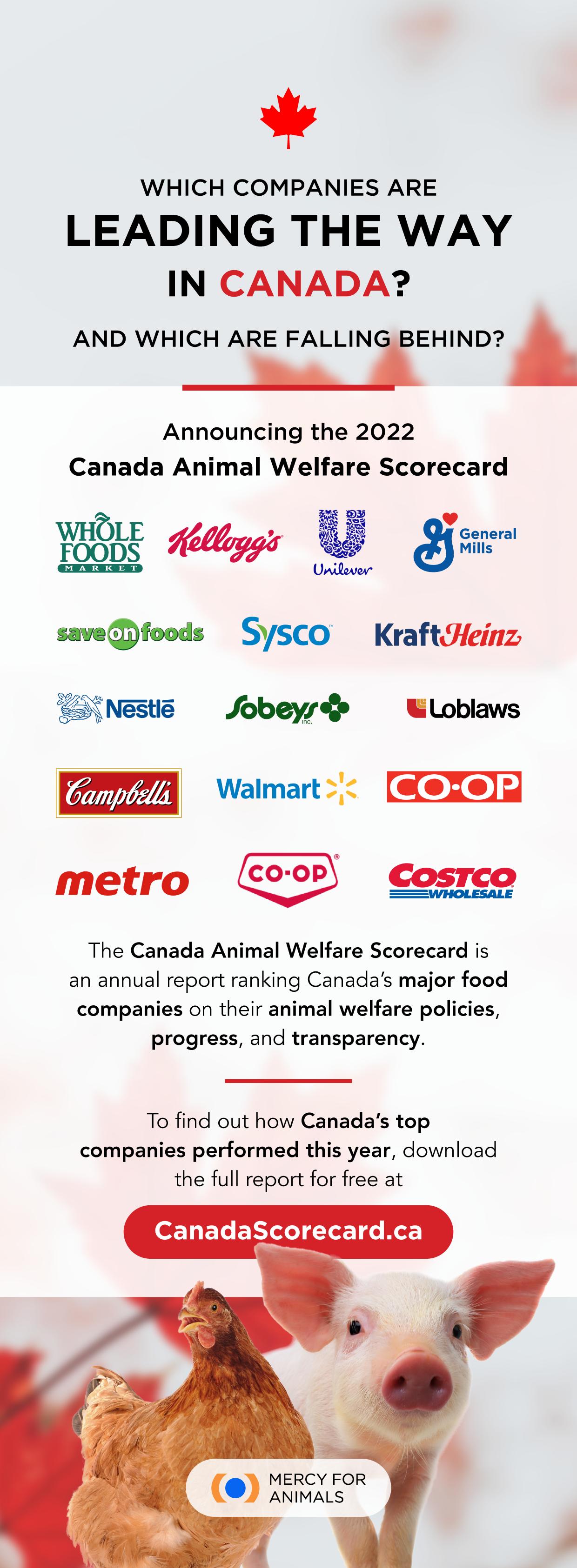
Ocean Spray® Sparkling Cranberry Beverages
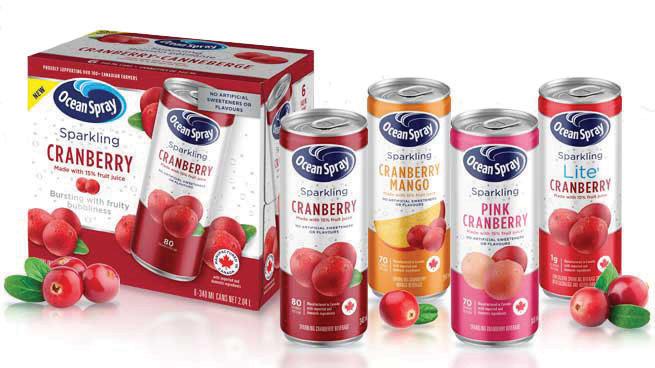
Made with real fruit juice, these cranberry sparkling beverages are bursting with fruity bubbliness. The naturally bold taste of cranberries plus the refreshment of bubbles, provide the ultimate in flavourful refreshment. These sparkling beverages contain no artificial sweeteners, flavours, or preservatives and come in a convenient single serve 6 pack that can be enjoyed at home, or on the go. Consumers can drink it straight up or add it to their favourite beverage.
Protein-Packed Snack from Freybe



For consumers who are looking for a protein-packed snack stick, they need look no further. One of the Freybe favourites refrigerated snacks is now o ered in two new exciting flavours: Honey Sriracha, that brings a light heat and sweet, to the smoky Ham flavour; and Cheddar, that is cheesy but in a good way.


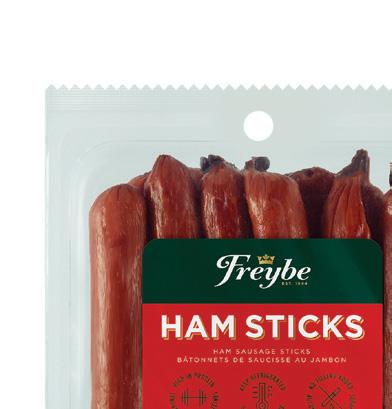
More to Love from Nature’s Path
Love Crunch Organic Dark Chocolate and Hazelnut Butter Granola takes the iconic flavour of hazelnut spread consumers love and adds a satisfying crunch. This decadent chocolate granola cluster is coated with sustainably sourced organic hazelnut butter and Fairtrade dark chocolate chunks. Love Crunch was made to help spread love worldwide with Nature’s Path’s Bite4Bite program, where they donate $2 million worth of food every year to food banks.

WHAT’S NEW PRODUCTS IN GROCERY NEW
SPECIAL PROMOTIONAL FEATURE IN CANADIAN GROCER || November 2022


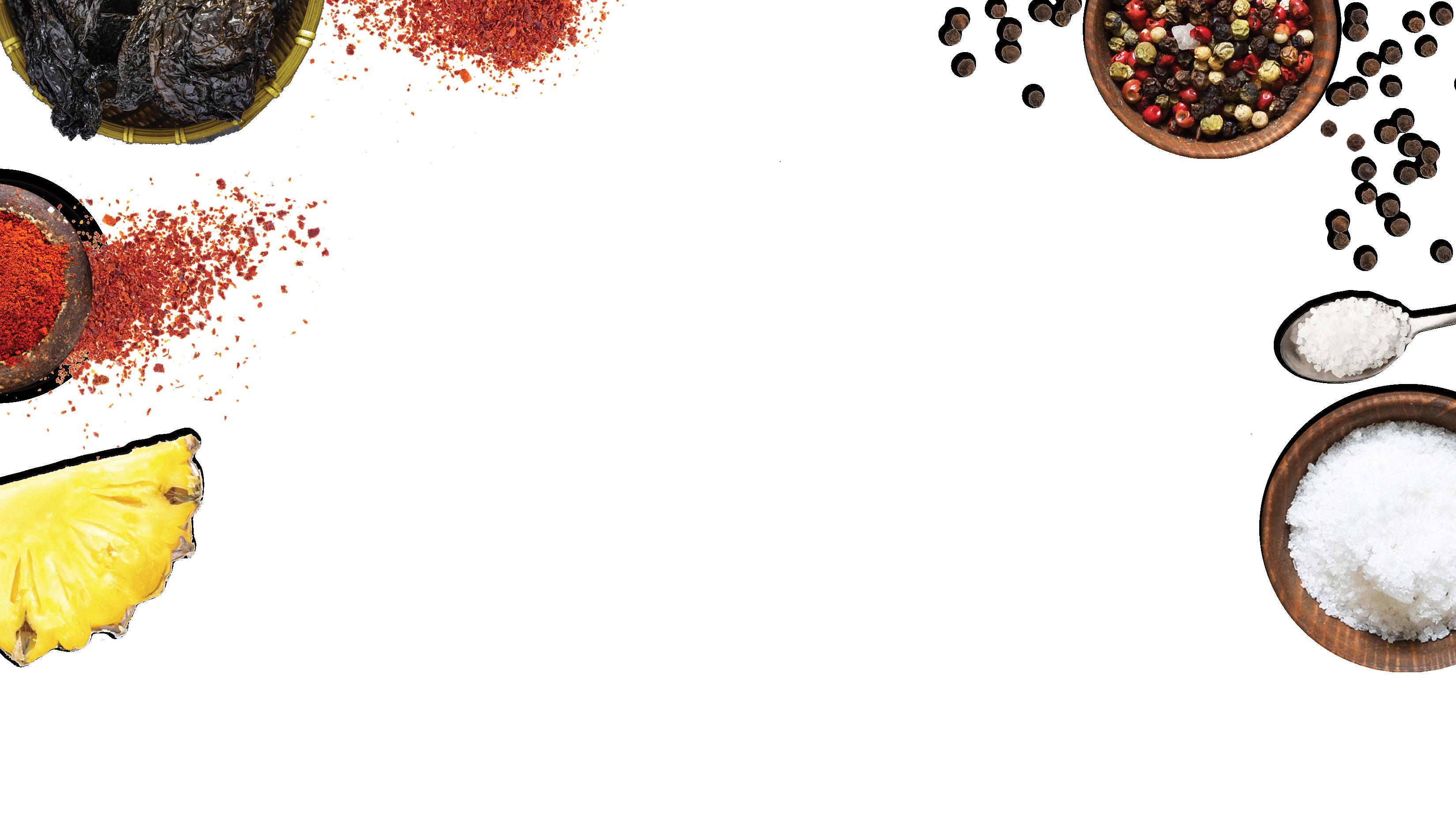

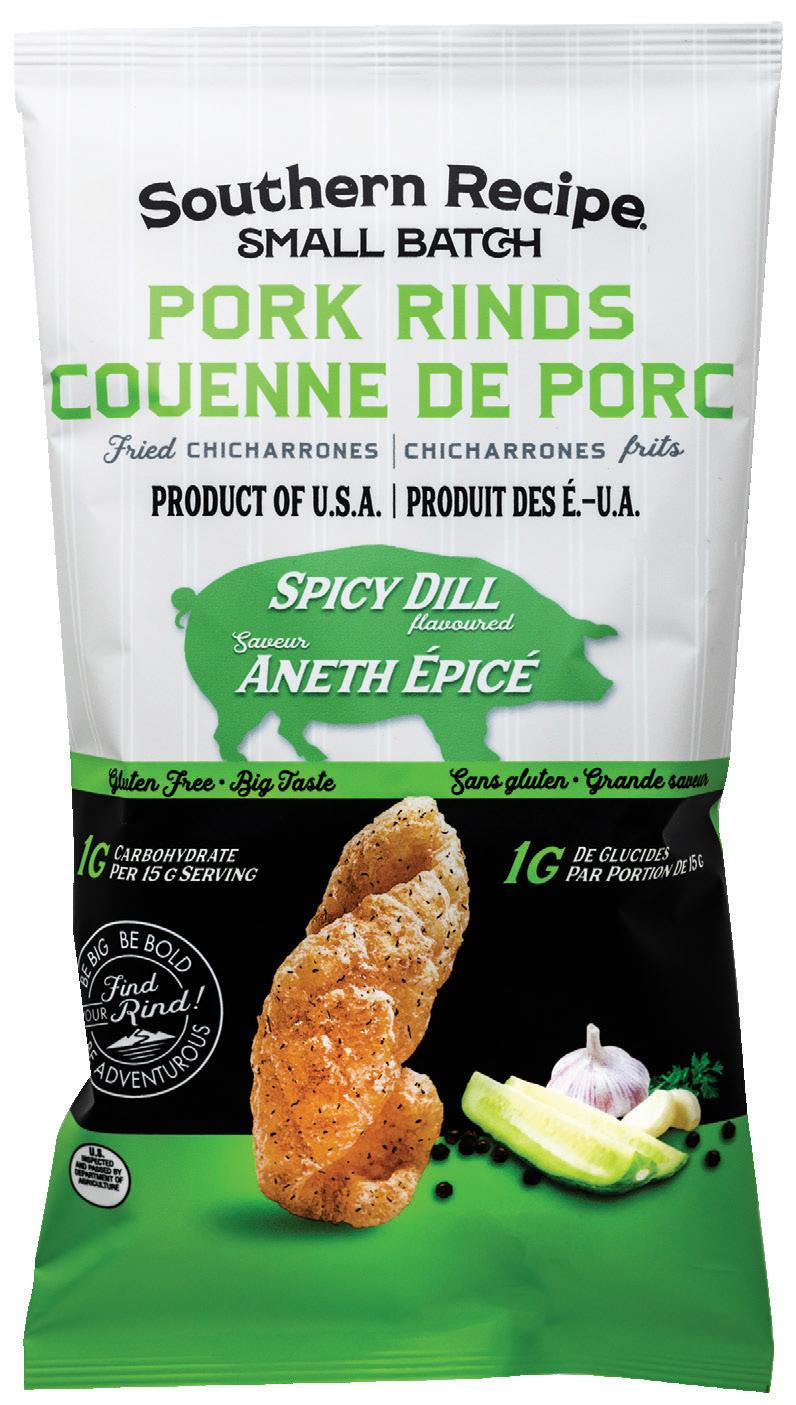


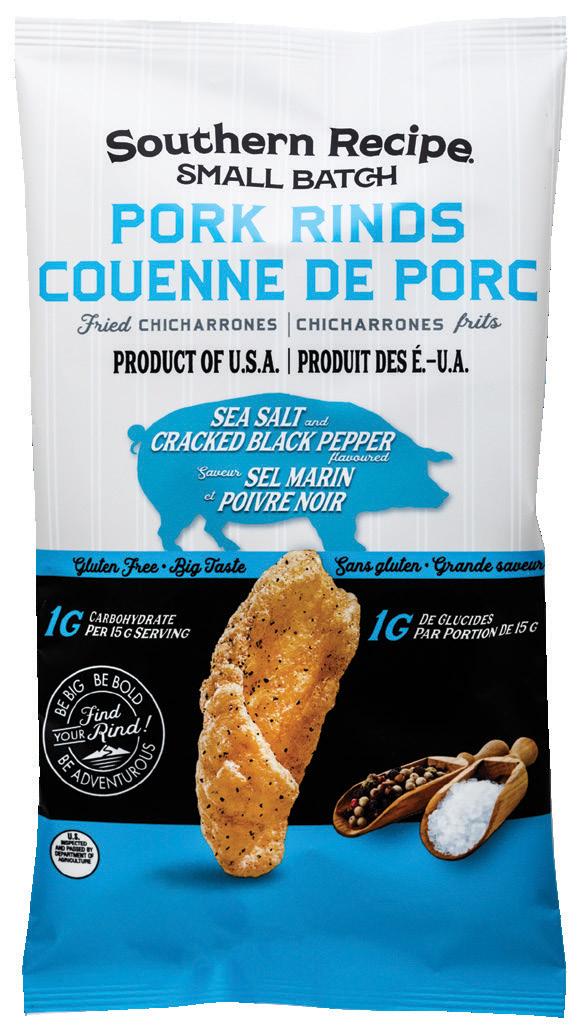
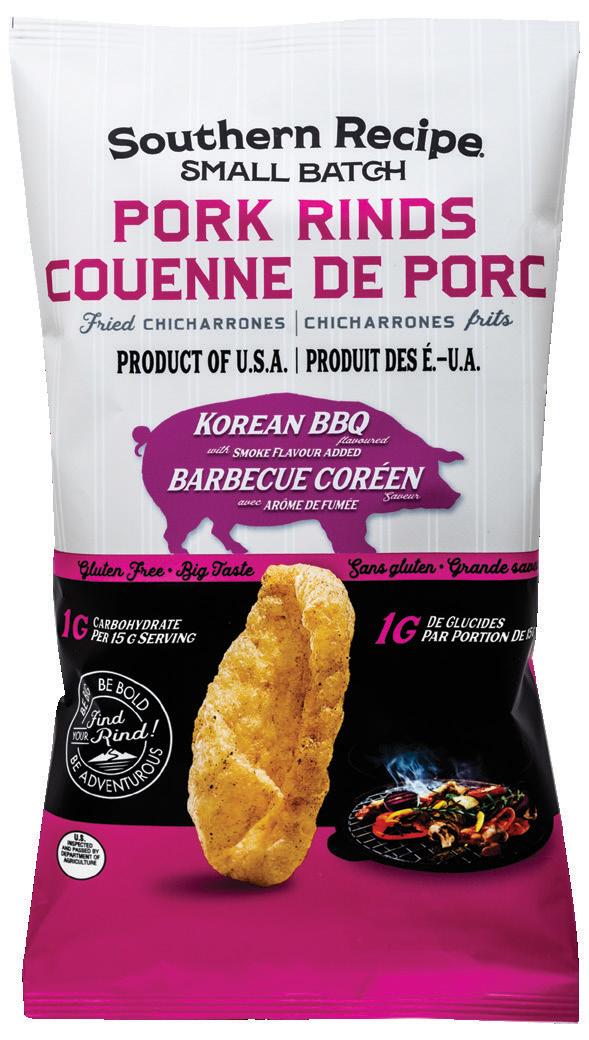
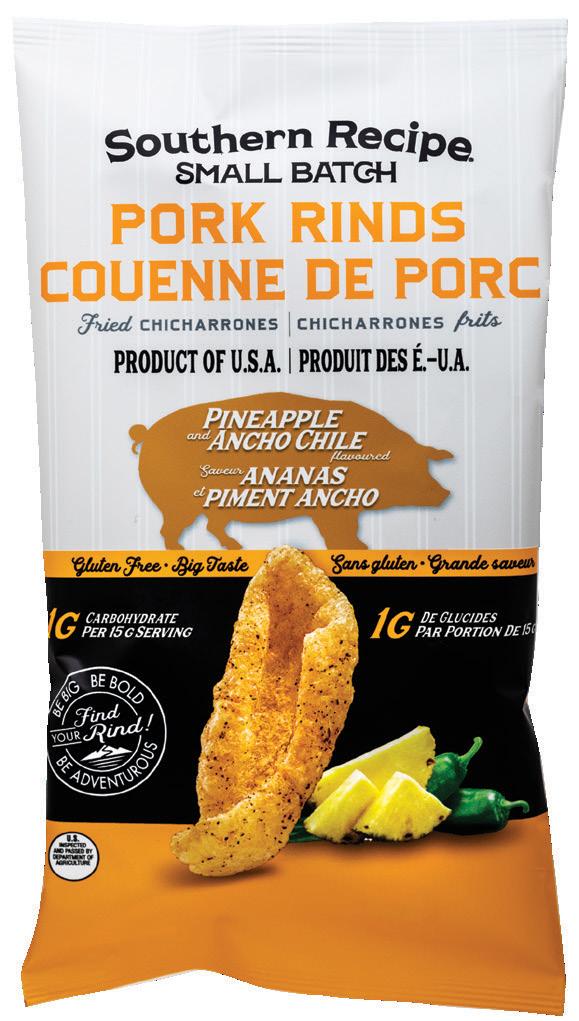



Can You PrediCt
Tomorrow’s Food Trends?
by Mark Singleton, VP of Sales and Marketing

In a volatIle market, there’s nothIng that brIngs more confIdence to your snack category set than knowIng you’re chasIng the rIght trends –wIthout a shadow of a doubt.
Leading brands have tapped into consumers’ desires for better-for-you options that help to fuel their busierthan-ever lives, make them feel good about what they’re putting in their baskets and give them something to share with their communities (or, might we even say, brag about).
To understand what’s encouraging shopping behaviour today to better predict what they’ll want to see on shelf tomorrow, there are three primary trends to take part in:
better-for-you snacks appeal to health-minded shoppers
Despite challenges with inflation, and as shoppers are discerning how best to adjust their spending habits, today’s better-for-you consumers are still choosing to dial down their budgets in other areas to continue prioritizing healthy foods.
This commitment to healthy foods amid economic uncertainty is proof that today’s better-for-you brands have an opportunity to support the conversation around overall health in a powerful way. High protein, low carb, collagen, gluten free, low sugar and low sodium claims should be brought to the forefront. Whether through on-pack messaging or in-store marketing, brands and retailers both can continue to educate shoppers hungry for information. As we lean into the better-for-you movement, we can build trust and shopper loyalty. We can be a partner in their food journeys.
flavour still wins when consumers are making choices about how to “Zig” and “Zag”
Yes, the better-for-you shopper has indicated that they won’t compromise on the brands they support through their purchasing decisions. However, consumers also consistently indicate taste as a major driver in their grocery purchases.
How today’s leading snack brands satisfy the need for flavour can be a major indicator of brand success. While shoppers intend to keep their pantries stocked with clean nutritional labels that fulfill their need for better-for-you options, they have also made it clear that they want to enjoy their food – and they won’t compromise on flavour.
regional and seasonal flavours Intrigue shoppers
Flavours that are bold, exciting, seasonal or nostalgic are an exciting way to deviate from a strict diet without completely breaking away from a healthy eating plan. In fact, as foods and flavours from cultures around the world become more accessible for consumers everywhere, fusion flavours and authentic, international flavour profiles can be seen in snack food innovations today.
Korean BBQ, Pineapple & Ancho Chile, Spicy Dill and Sea Salt & Cracked Black Pepper have all graced the snack food aisle, and with an unlikely pairing, nonetheless. The appeal of keto-friendly, protein-packed, low carb pork rinds have been elevated with such innovations and brought to a hungry market by Southern Recipe Small Batch pork rinds.
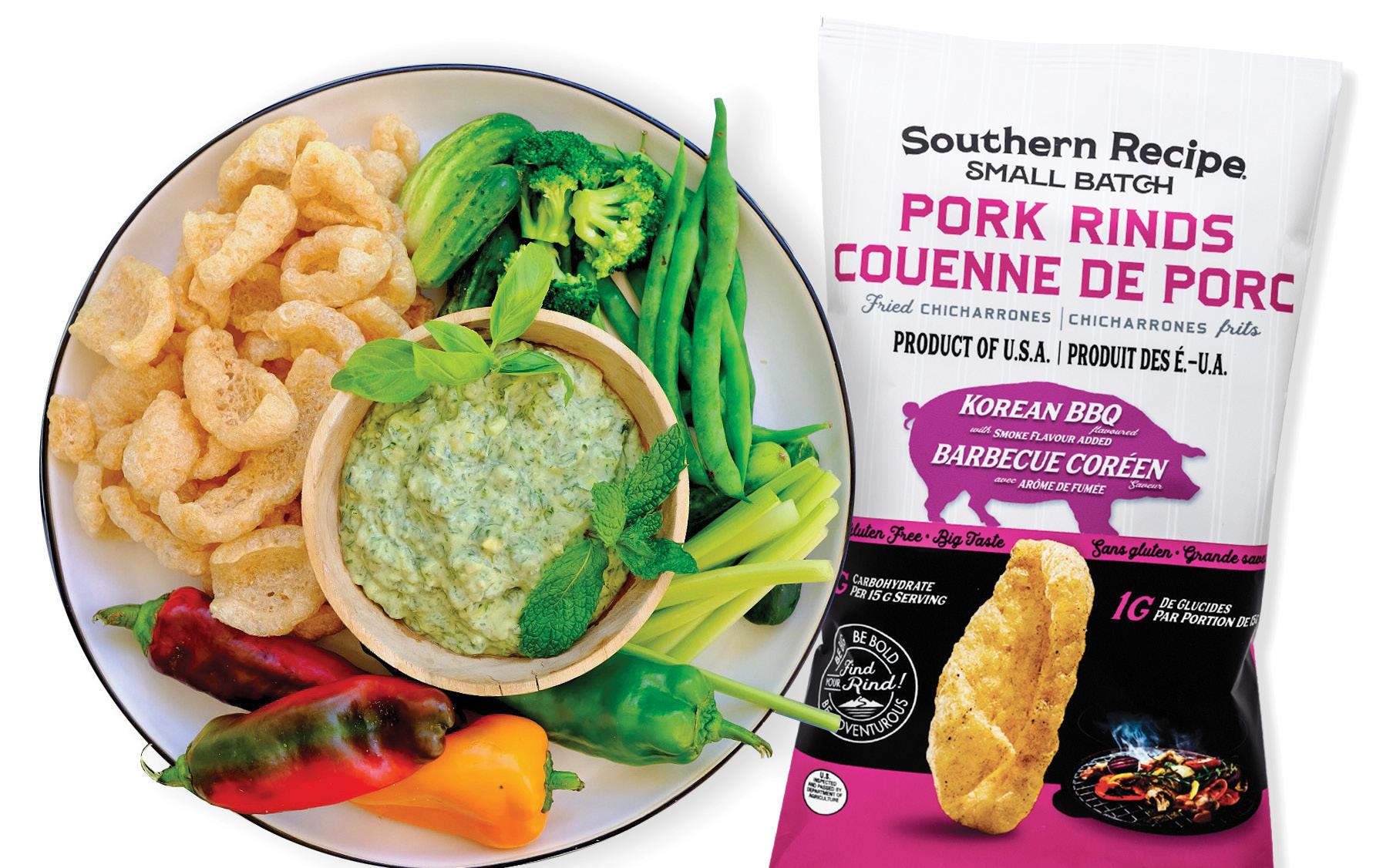

continue leading the way Flavour innovations and bold seasonings are bringing the spice we like to call variety to snack shelves, now more than ever. When shoppers are gripping just a little tighter to their purse strings and maybe even adhering to stricter diets, they’re also leaving a little wiggle room to enjoy their favorite flavours and newfound favorites.
about southern recipe small batch Southern Recipe Small Batch, a division of Southern Recipe – “The tastiest crunch in the South” – is a small batch, handcrafted brand of pork rinds. Developed with the purpose of delivering iconic flavour in a nostalgic recipe, Southern Recipe Small Batch offers this traditionally indulgent Southern snack in internationally inspired flavours that boast eight grams of protein, low carbs and are naturally gluten free. For additional information, visit SouthernRecipeSmallBatch.com.
how
to appeal to
today’s
consumer and build shopper loyalty



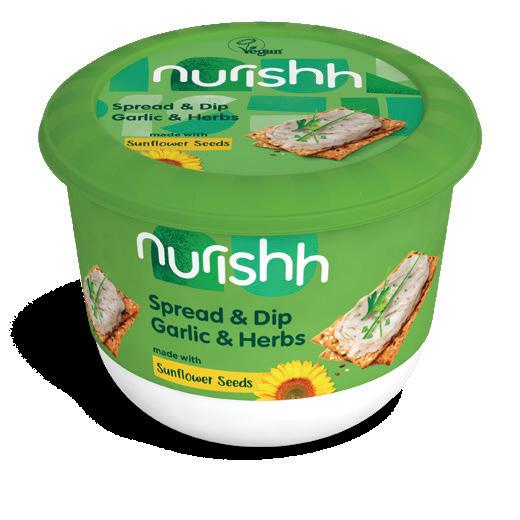
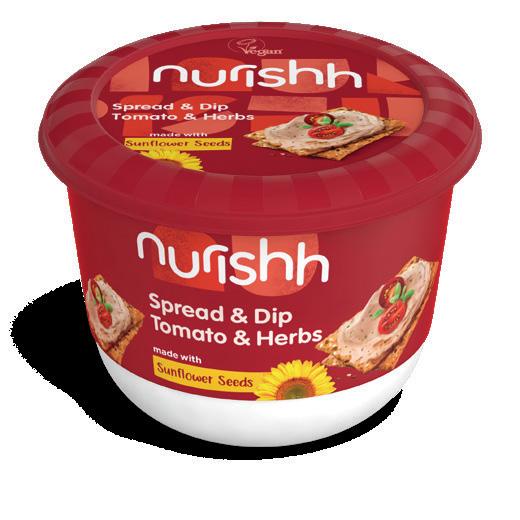
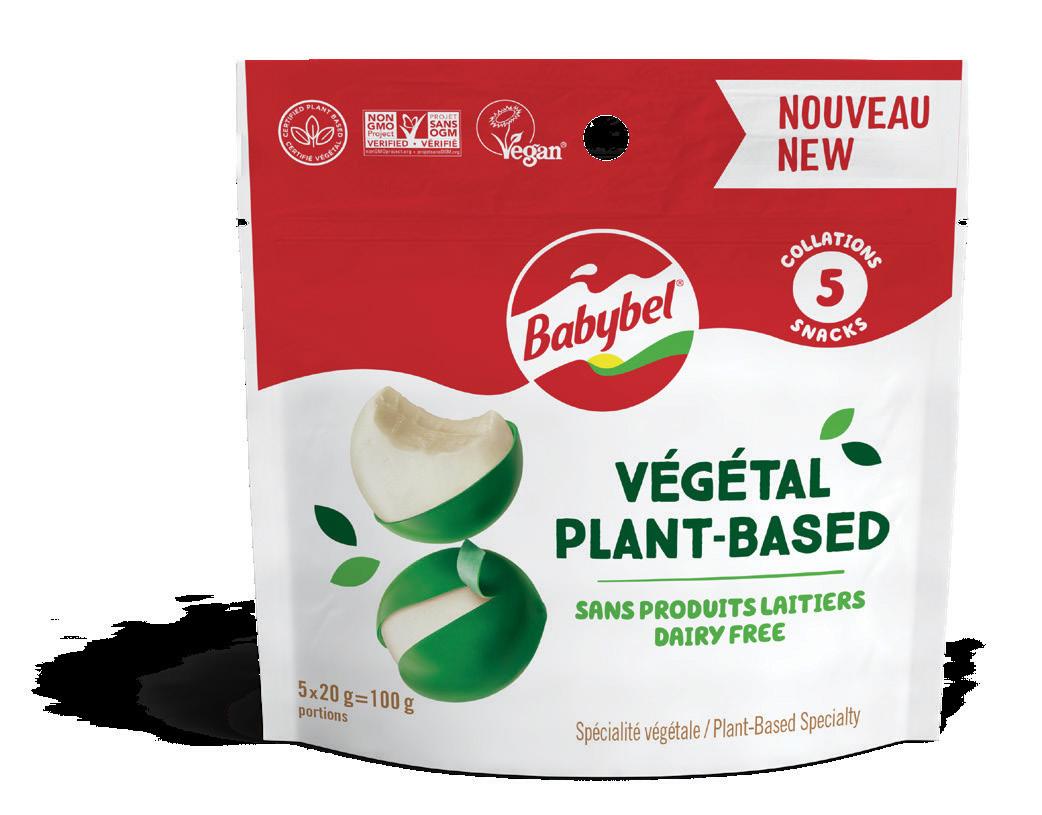



The Babybel® portfolio isexpanding: Discover the NEW Mini Babybel Plant-Based, a playful and convenient dairy-free snack! Add some delishhh to your sandwiches, crackers, AND favorite recipes! TOMATO & HERBS A sunny taste of sunflower seeds and tomatoes that everyone will love! GARLIC & HERBS A delicate taste of sunflower seeds and garlic that is sure to please everyone. Introducing Nurishh Spreads & Dips! Bel continues to INVEST IN plant-based alternatives as part of its mission to champion healthier and responsible food for all. It is committed to developing products consumers want while caring for the planet. Nurishh adds to its line-up of plant-based offerings:
SNACK OF ALL TRADES
At home and onthe-go, experts say consumers are experiencing a serious snack attack
 By Jessica Huras
By Jessica Huras
From grab-and-go bars that fuel a mid-afternoon energy slump to latenight munchies that help us unwind after a busy day, snacks are as diverse as the reasons why people eat them.
A study from market research company Ipsos for the 12 months end ing July 2022 suggests the average person consumes a food or beverage between meals 11 times per day. Kathy Perrotta, vice-president of market strategy and understanding at Ipsos Canada, says this number has seen a noteworthy 8% growth since 2020.
“Snacking has surged for different reasons and across different catego ries through the pandemic,” says Perrotta, “and now with movement rates [outside of the home] up, we see that snacking remains robust and—at certain points like morning snacking—it’s growing.”
Perrotta adds that rates of snacking at home remain higher than prior
November 2022 || CANADIAN GROCER 47 GETTY IMAGES/PROSTOCK-STUDIO SNACK TRENDS
Aisles PRODUCTS || STORE OPS || CUSTOMERS || TRENDS
to the pandemic. This trend is now dovetailing with a resurgence in on-the-go snacking, as many consumers return to the office and other out-of-home activities. “The biggest growing category in our store is snacks,” confirms Ryan Dennis, owner of Vancouver grocer Larry’s Market.
Bethany Pfohl, vice-president of marketing for SimplyProtein, agrees that this blending of pre- and post- COVID consumer snacking habits is creating big opportunities in the space for brands and retailers alike. “With more consumers navigating a hybrid life style, it’s opened up a whole new plethora of snacking occasions,” she says.
Rabba Fine Foods has seen a “steady and consistent increase of snack sales” in its stores, says Rima Rabba, marketing communications manager for the Toronto area retailer. She says the grocer takes a three-pronged approach to selecting snacks for its 30-plus stores. “Our more recent decisions on new snacks typically revolve around something that tastes great, uses quality ingre dients and our customers can feel good about eating,” she explains. “Whether it’s because a snack is nonGMO, has specific nutritional benefits or comes from a trusted brand, customers must connect with that great feeling they get from snacking.”
A NIBBLE HERE, A NIBBLE THERE The definition of “snack” is evolving, with many consumers opting to graze on light bites throughout the day, rather than eating three main meals at breakfast, lunch and dinner.
Mondelēz International’s 2021 State of Snacking report found 63% of Canadians prefer to eat many small meals throughout the day, as opposed to a few large ones. This number has seen a significant 13% rise since 2019.
The same Mondelēz report revealed 75% of Canadi ans say their definition of snack has evolved over the last three years to include more or different types of foods, occasions for eating or other elements.
Ipsos’ Perrotta says the softening distinction between meals and snacks is likely to continue as con sumers return to their busier, out-of-home schedules. “As we move outside the home more, you can expect to see morning snacks continuing to grow: ‘I don’t have time for breakfast. I’m just going to grab a snack on the way out,’” she explains.
“It’s still not as robust as the pre-pandemic period
when it was a habit, but it’s growing versus 2020 and 2021,” Perrotta adds.
Ipsos research is supported by Mondelēz’s data, which shows 51% of Canadian consumers replace at least one meal each day with a snack.
A PERMISSIBLE INDULGENCE For many consumers, a snack is about more than satisfying hunger. The Mon delēz report found that nine in 10 consumers say they eat at least one snack for sustenance and one snack for indulgence each day.
“Some of the new innovation that we see in the mar ketplace really targets not just what’s in the product, but how it can provide benefits both physical and emotional to consumers. I think it’s a way to make indulgence per missible when there are benefits to it,” says Perrotta.
According to the Mondelēz report, 37% of consum ers say they snack for “a sense of comfort,” while 36% snack “to boost mood.”
Many snack companies are creating products that touch on the diverse needs that snacks serve for con sumers. The concept of permissible indulgence, for example, is the strategy behind many of the prod ucts in No Sugar Company’s lineup, according to the brand’s chief strategy officer Zelka Ridjosic. “[Con sumers] are not just looking for a healthy product, but they want something that’s indulgent and rich and creamy,” she explains.
No Sugar Company recently launched Chocolatey Caramel Pecan Keto Shellz, which Ridjosic describes as a better-for-you take on Turtles chocolates made with dark chocolate and zero sugar. “It’s about finding something that feels and looks like a treat,” she says.
Dennis from Larry’s Market is noticing a similar trend around better-for-you versions of chips. “Potato chips, they’ve stayed steady, but the growth is in veg gie chips and fruit chips—anything in that category of healthy snacking,” he says.
Mid-Day Squares takes a similar approach to its snacks, which blend the taste of a chocolate with the better-for-you benefits of a protein bar, according to co-founder Jake Karls. “We call it a functional choco late snack,” he says. “People want to indulge but they want to feel good after.”

Mid-Day Squares’ high-protein component taps into a particular better-for-you benefit that consumers are seeking right now. “Calories, sugar, fat and carbohy drates are the top four, but they’ve pulled back a little bit,” says Perrotta. “They’re still the largest, but rising in priority is protein.”
While better-for-you benefits can increase a prod uct’s appeal for consumers, taste still reigns supreme when it comes to these permissible indulgences. “Some thing like 80% of consumers cite taste as being the most important element of their purchase decision,” says SimplyProtein’s Pfohl. “All of our innovation needs to deliver on taste first and then we get to nutrition.”
SNACKING WITH A CONSCIOUS Consumers are turning a more critical eye to the values of the snack compa nies they support with their dollars. In the Mondelēz
48 CANADIAN GROCER || November 2022 GETTY IMAGES/SERTS
Aisles
report, 79% of respondents say they have become more conscious over the last year of what products they’re buying and why.
Matthew von Teichman founded Purplesful Snack ing with the goal of giving back to local communities. “It’s trying to divert some of the profits of the high-vol ume category of snacking away from just padding the profits of shareholders and over to people that need the help a little bit more,” he says.
Launched earlier this year, Purplesful’s ready–to-eat popcorn is made with non- GMO purple corn, which is rich in antioxidants and amino acids; and 25% of the company’s profits are donated to commu nity organizations like Breakfast Club of Canada.
“We satisfy the taste piece, which everyone really needs in order to get repeat sales,” explains von Teich man, “but we’re different in that we then satisfy the health piece and we [also] satisfy that ‘brand with a conscience’ piece.”
No Sugar Company’s Ridjosic notes that clean label and ethical products often come at a higher retail price, which can cause sticker shock for some consum ers. No Sugar Company’s snacks, which are made with organic coconut oil, fair trade organic cocoa and sus tainably-sourced dark chocolate, cost consumers more than their conventional sweet snack counterparts.
“I think that’s part of our biggest challenge, because people look at our products like our new Gemz choco late covered peanuts, for example, and they look at the cost of M&M’s and they’re like, ‘that makes no sense,’” says Ridjosic. “But we are trying to educate consumers that it’s not a direct comparison.”
Ipsos’ Perrotta says consumers’ willingness to pay more to support ethical snack companies varies by demographic, explaining that older cohorts are more likely to be unwilling to accept the higher price even if they align with the company’s values. “They feel like the manufacturers should pay for it,” she says. “The younger cohorts take a responsibility stake in it and they’re willing to pay for it.”
PACK A PUNCH From Nestlé Canada’s commitment to ensure an average of at least 30% recycled content across all its plastic packaging by 2025 to smaller brands such as Humble Potato Chips using certified compostable bags, sustainable and biodegradable packaging is now a hot topic in the world of snacks.
Seventy-seven per cent of Canadian consumers say the No. 1 environmental impact on their food choices is low-waste packaging, which includes using recyclable or reduced packaging, according to the Mondelēz report.
After noticing a lack of organic, environmental ly-friendly-packaged snack options, husband and wife team Alicia and Jeff Lahey came up with the idea for Humble Potato Chips—a chip brand made with locally sourced, organic potatoes and packaged in 100% com postable bags.
From perfecting the packaging to developing sea soning for the chips, it took the couple five years to commercialize the brand, which hit grocery stores shelves earlier this year. Humble Potato Chips are
available in original, sea salt and vinegar, smokey barbecue, honey mustard, and creamy dill, and the Lahey’s hope to introduce two more flavours and a smaller grab-and-go size to their lineup next year. Ipsos’ Perrotta says packaging is part of an emerging aspect of sustainable operations for snack brands. “When you talk about sustainability, there’s ‘product provenance’—locally-sourced, functional ingredients, and freshness—and I think manufacturers have done a lot of work around that already,” she explains.
“But the other space is the Earth’s health, which is sustainable packaging, regenerative farming and an environmental footprint that’s favourable—that one is kind of a newer, less-developed space.”
Mirroring wider conscious snack consumption trends, younger consumers are more likely to pay the higher retail price associated with biodegradable packaging. “They’re willing to support products with a brand DNA that really says, ‘we understand the impor tance of the sustainability footprint,’” Perrotta says.
IN-STORE INSIGHTS With inflation increasingly impact ing consumers’ purchasing decisions, Perrotta advises retailers not to overlook the demand for snacks.
“In an environment where there are inflationary pressures, there tends to be a really big focus on meal essentials and a mindset that snacking is not as important—and that’s not the case,” she says.
Perrotta adds there’s an opportunity for retailers to connect snacks with consumer enthusiasm for the return to socializing in groups.
“We do see a slow movement back to social and cel ebratory occasions, so I think it’d be a great time for those in-store promotions that look at celebrating with different kinds of foods and beverages that meet those ‘outside meal’ occasions,” she suggests.
Mid-Day Squares’ Karls says better-for-you snacks often benefit from placement in the produce depart ment, which can be more effective in helping them reach their target audience of health-minded consum ers. “We’ve slowly started changing to merchandise in the produce section, where the consumer indirectly is looking for products like ours,” he says.
Long-term, however, Karls hopes more Canadian retailers will take a cue from their U.S. counterparts by having entire aisles dedicated to functional snacks. “In Canada, we’re still not there yet—and we hope to be the pioneer—but the goal is when we can build them [functional snacks] sets together, then basket size will go up,” he says.
Karls adds that retailers could also benefit from supplementing the chocolate and chips traditionally showcased in the check-out area with more innovative snack products.
“Think about the cashes today in grocery stores, they still sell candy bars and diet beverages or sodas but, if you think about it differently—on where the consumer is going in life—they’re moving towards better-for-you products,” he says. “I think that’s where we need to go in the next decade in order to help the consumer out and drive more sales for retailers.”
November 2022 || CANADIAN GROCER 49
The definition of “snack” is evolving, with many consumers opting to graze on light bites throughout the day, rather than eating main meals at breakfast, lunch and dinner
Aisles

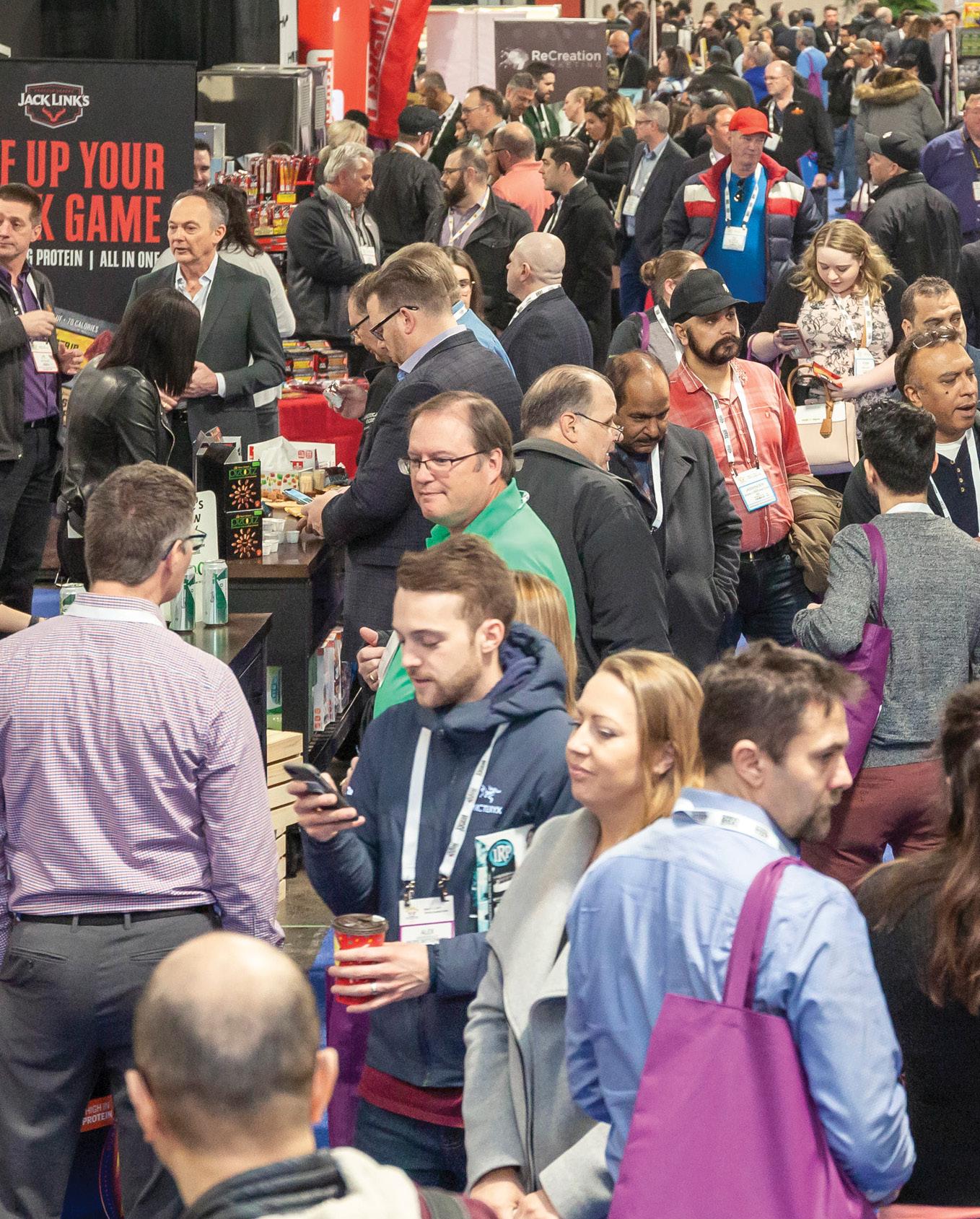

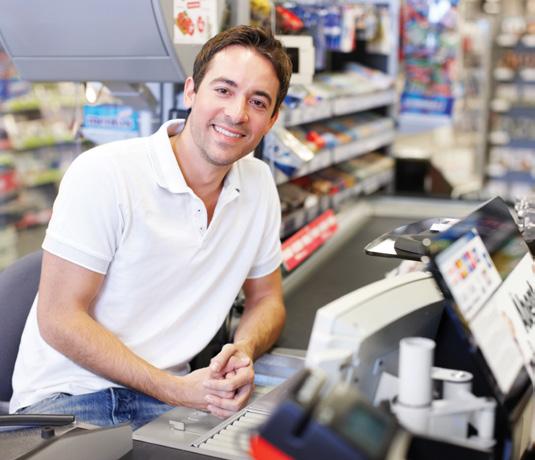

SAVE THE DATE! MARCH 7 & 8, 2023 TORONTO CONGRESS CENTRE LIVE AND IN-PERSON ConvenienceU.ca Canada’s LARGEST convenience, gas and car wash industry event
UltraPür Goodness
Lactantia UltraPūr is pure, fresh milk from Canadian dairy farms that is ultra-filtered to concentrate its natural goodness to give consumers more of what they want - 50% more protein, less sugar, and 10 essential nutrients*. That’s a lot of wholesome goodness in a glass. Now available in Skim Milk and Homo Milk.


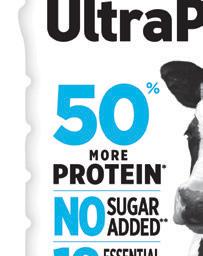

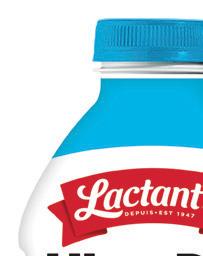


*When compared to regular milk per serving

Get a Boost from Dove
New from Unilever, Dove Body Love Moisture Boost Body Cleanser is formulated to boost skin’s moisture and fortify the skin barrier. The skin-quenching formula is enriched with hyaluronic acid serum (yes, the same ingredient that’s in face care products), moringa oil and Dove’s unique 10X Moisture Boost Complex,* to help skin retain moisture.

*10X the moisturizers of the leading body wash.



Bring on the Barista!
Canada’s beloved Kraft Peanut Butter Bears are brightening up consumers’ mornings with premium co ee proudly made with 100% Arabica beans and roasted and packed in Canada. Kraft Café Barista is available in both roast and ground and compostable pods, and is available in two indulgent flavours: Chocolate Hazelnut and Salted Caramel.

WHAT’S NEW PRODUCTS IN GROCERY NEW
SPECIAL PROMOTIONAL FEATURE IN CANADIAN GROCER || November 2022
Raisinomics for the Holiday Baking Season

An analysis of business reasons to stock up on California Raisins, the naturally sweet, no sugar added, ingredient for incredible holiday baking – in traditional and unconventional recipes. Raisins are the most popular dried fruit purchased by 67% of Canadians The most consistent supplier in dried fruits Visit Californiaraisins.ca for more information. *Rose Research Report conducted in April/May 2022 among nationally representative sample of 501 Canadians. 66% of Canadians surveyed perceive raisins to be a healthy and nutritious food DATA*: Retail
Canadians are 5x more likely to recognize California/ USA raisins than any other raisin origin 58% of Canadians feel raisins of California/U.S. origin are higher quality than raisins from other countries/regions ADDITIONAL CALIFORNIA RAISINS RESEARCH: Quality that surpasses worldwide quality standards Beloved by consumers for taste, nutrition, versatility and affordability 67%, 66% 5 X 58% Conclusion: With consumers looking for wallet-friendly, healthy holiday baking ingredients, California Raisins are an A+ decision! Stock up now.
RISING TO THE OCCASION
By Chris Powell
AS DEMONSTRATED by two-and-a-half years of pandemic, which ushered in the sourdough bread-making craze and produced a spike in cookie sales, baked goods remain a staple of Canadians’ diets.
According to Mintel’s recent Trends in Baked Goods report, Canadians’ love of bakery is “near universal,” with 98% of the population reporting eating baked goods in the past three months. Both breads and sweet goods enjoyed significant penetra tion—91% and 93%, respectively. “For the vast majority of Canadians, sweet and savoury baked goods are part of their reg ular diets,” the report says.

This year’s Mintel report looked at behavioural and attitudinal trends rather than its customary examination of ingre dients and/or innovation, says Meghan Ross, senior research analyst—home and beauty, Mintel. It’s a reflection of how food inflation, coupled with the linger ing effects of the pandemic, is shaping bakery trends for the year ahead.
AFFORDABLE INDULGENCE
Though rising food prices have become a major concern for Canadian fami lies, the relative affordability of baked goods—particularly when compared to bigger-ticket grocery items such as meat and seafood—means consumers are still willing to pay more for bakery items, and particularly those featuring higher-qual ity flour, chocolate and other ingredients, says Shelley Balanko, senior vice-presi dent of The Hartman Group.
“They’re going to be looking for high quality because they can still afford to indulge in a bakery offering when they might not be able to afford to go out for
dinner,” says Balanko. “It’s still some thing that’s within their reach, and you can trade up in bakery, whereas if you were trading up in something like beef, it’s cost-prohibitive.”
Jo-Ann McArthur, founding partner and president of Toronto-based Nourish Food Marketing, says bakery is a category that enables consumers to break bread without breaking the bank, meaning they’re willing to pay one or two dollars more for comfort items. “It’s worth it to them,” she says.
FUNCTIONAL AND HEALTHY FOOD
Consumers are realizing the short- and long-term importance of their physical health, which has them scrutinizing labels for health-associated ingredients such as vitamin C and fibre, says Balanko. “They’re the kind of things consumers will be looking for to communicate the inherent functionality that will really deliver on nutrients,” she says.
Negative connotations surrounding the nutritional value of baked goods will serve as a “barrier” to some Canadians, says Mintel, with a desire to cut back on carbs resulting in either reduced serving sizes or eating occasions.
This has already spurred brands to innovate by using grain alternatives and low- carb ingredients, according to the Mintel report. High-fibre and low-sugar options have already taken to emphasiz ing “net carbs” rather than total carbs to assuage misgivings consumers may have over carb consumption.
The growing vegan trend is also mak ing its way into the bakery department.
Baked goods using egg replacements such as aquafaba—the starchy, viscous liquid leftover from cooked beans and chickpeas—are becoming increasingly common on both the sweet and savoury sides of the business, says McArthur.
THE INTERNATIONAL INFLUENCE
The influence of international cuisines is being felt throughout grocery retail. And while it’s not as prevalent in bak ery, Balanko says grocery shoppers are increasingly seeking unique items in all sections of the store.
The Ethiopian pancake-like flatbread injera, for example, is gaining in popular ity in some markets because of its unique texture, sour taste (there’s the sourdough influence) and the health qualities of the teff flour it’s made with.
While acknowledging it’s a long way from going mainstream, Balanko likens injera’s potential to the Indian flatbread naan, which is now widely available including at the big-box grocery retail ers. “When packaged naan is a staple at Costco, you can pretty much say it’s a mainstream trend,” she says.
FROZEN, NOT FRESHLY-BAKED
Though par-baked bread from brands such as Ace, which enable people to finish the baking process at home, have been popular among consumers for years, Nourish’s McArthur predicts the trend will grow to encompass other baked goods such as muffins, cupcakes and bagels. “You get that lovely smell and feel like you did a little something.”
November 2022 || CANADIAN GROCER 53 GETTY IMAGES/PIDJOE
Though watching their budgets, Canadians are still willing to indulge in baked goods
Aisles
Sober curious. Mindful drinking. These buzz words have bubbled up from a growing global movement of adults giving up (or reducing their intake of) alcohol for health and wellness benefits. The behaviour takes Dry January, after holiday boozing, to a year-round practice.
Helping empower the movement to cut back are new non- and lowalcohol alternatives that taste like the real thing, minus the hangover and calories.
Joel Gregoire, associate director of food and drink at Mintel, says the firm’s research shows more than half of Canadian adults (approximately 57%) believe mocktails are a good substitute for the real thing, reflecting changing attitudes towards nonalcoholic drinking.
“No longer do you have that person sticking out with a glass of water or juice—with this category, they’re still able to enjoy the flavour profile of a cocktail as well as social moments,” he says. “The category offers a sense of inclusion.”
Booze-free bevvies Four thingsto know
 By Chris Daniels
By Chris Daniels
3 A SPIRIT-LESS SPIKE
Buzz-less beverages have surged in popularity, with NielsenIQ naming it as one of the biggest trends of 2022. According to the market researcher, consumers spent US$3.3 billion on no- and lowalcohol products within the U.S. off-premise market last year.
Fresh City Farms began carrying proof-less beverage options in some of its eight locations and online in 20202021, and Orford is buzzed about their reception so far.
“We have seen consistent growth,” he says. Breaking down sales for adult beverages, Orford says non-alcoholic spirits now sit “comfortably in our top three alongside beer and red wine.”
Though the non-alcoholic beverage market is still developing in Canada, Sarah Parniak, senior Canadian manager, non-alcohol for Seedlip—a seven-year-old brand acquired by Diageo in 2019—says once more retailers dedicate shelf space to these beverages it will prove “a turning point” for the category in Canada.
FAD OR THE FUTURE?
Will Orford, director of purchasing at Fresh City Farms in Toronto, sees no signs of the category fizzling out. “Non-alcoholic beverages have become a staple in many fridges,” he says. “As new parents, they’ve become a staple in our house for my partner and I when we want something refreshing with dinner but still need our wits about us.” Producers also continue to innovate in the category. “We’re seeing non-alcoholic options for things like Prosecco, stouts and porters,” he notes.
In 2021, consumers spent US$3.3 billion on no- and low-alcohol products within the U.S. off-premise market: NielsenIQ
“Shoppers need clear direction on where to find these products,” she explains. “Layering in education and occasion at shelf will help to establish a dynamic shopper story and set the stage for long-term growth.”
4 BEVY OF BRANDS
In recent years, Canada has seen new entrants like Sob rii, a brand featured on Dragons’ Den last year, which has a gin and a tequila with less than 0.5% alcohol, zero sugar and zero calories.
Vancouver-based Opus launched in late 2020 with a zero-proof Peach Bellini, Gin and Tonic, and Aperitivo Spritz. “In the first month, we sold 12 cases at retail, then 65 and then 90 and eventually moved 2,000 cases in a month,” says Opus founder and CEO Christos Kalaitzis.
And just in time for Dry January 2022, Corona Can ada launched Corona Sunbrew 0.0%, a non-alcoholic beer that the company says contains 30% of the daily value of vitamin D per 330-mL serving.
54 CANADIAN GROCER || November 2022 GETTY IMAGES/~USERGI15966731
2
1 BEYOND DRY JANUARY
Aisles
New on shelf!
1 GOOD TO GO BLONDIES AND BROWNIES
Whether for dessert or to ward off afternoon hunger pangs, Good To Go Blondies and Brownies are indulgent, guilt-free treats that are high in fibre with no added sugar. Made with almond flour, both products are also certified keto, vegan, gluten free, grain free, peanut free and Non-GMO Project verified.


2 CALIFIA FARMS OAT BARISTA BLEND
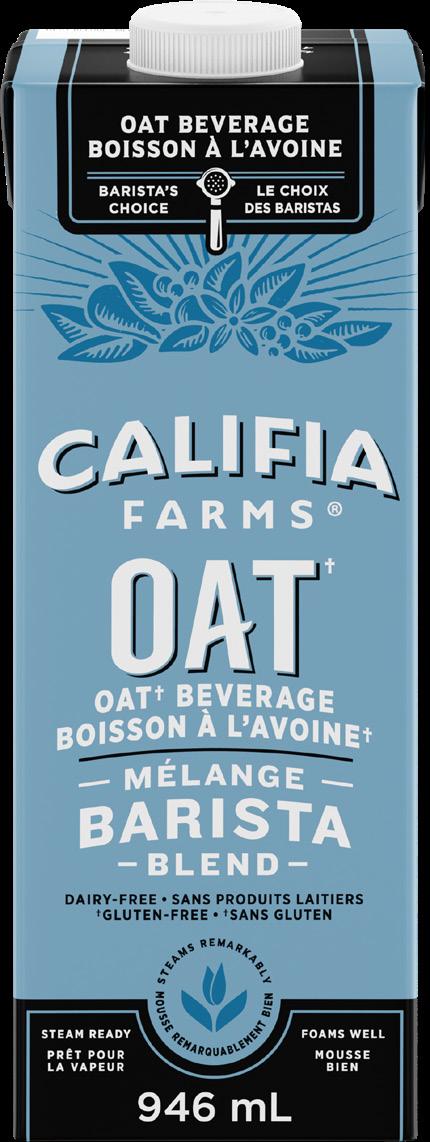
Oat Barista Blend from Califia Farms is made from gluten-free oats and boasts a rich texture and subtle sweetness. It “froths, foams and steams like a dream,” according to the Los Angeles-based company, and is also Non-GMO Certified, kosher and vegan. Oat Barista Blend is sold in 946-mL, shelfstable Tetra Paks.
3 KHAAS HALAL AND KHAAS DAHI YOGOURT
Lactalis has added two yogurts to its portfolio that the company says serve the “preferences and diets of Canada’s growing South Asian, Middle Eastern and North African market.” Taking cultural diets and restrictions into account, Khaas Halal and Khaas Dahi yogurts are free from gelatin and artificial preservatives. They are sold in 0%, 2%, and 3% milk fat in both 750-gram tubs and two-kilogram pouches.

4 MCCAFÉ HIGH GROWN ORGANIC DARK ROAST COFFEE

McCafé High Grown Organic Dark Roast Coffee is made from 100% Arabica beans that are grown at high elevations in Central and South America’s coffee regions. Rich and full bodied, this roast delivers subtle notes of cocoa and caramel and can be purchased in a variety of formats including single-serve, 10-pack K-Cup Pods, 300gram fine ground bags and 300-gram whole bean bags.
5 HELLMANN’S VEGAN SALAD DRESSINGS
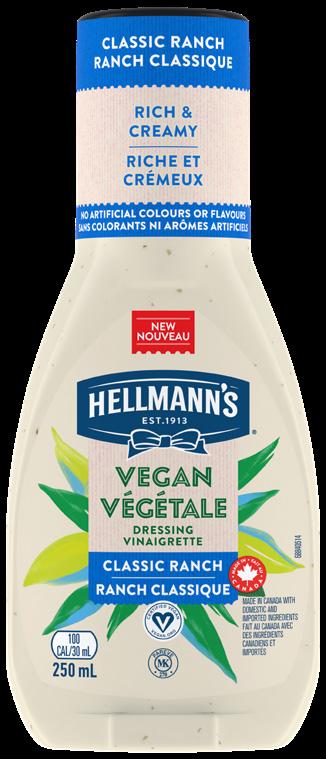
Adding to its growing line of plant-based products, Hellmann’s has launched three salad dressings that the company says are rich and creamy in taste, certified vegan and made in Canada. Hellmann’s Vegan Ranch Dressing is tangy, sweet and creamy with a bite; Vegan Caesar has notes of garlic, lemon and pepper; and Vegan Green Goddess has hints of lemon and herbs.
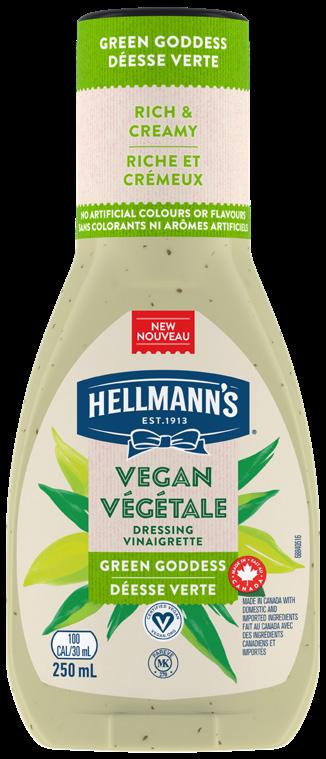
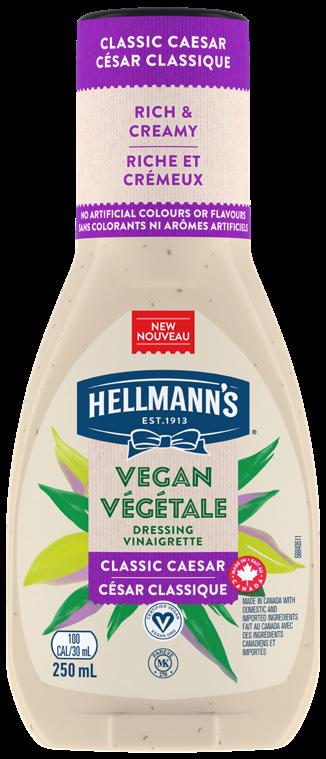
November 2022 || CANADIAN GROCER 55
CG
1 2 3 4 5 Aisles The latest products hitting shelves
TAKING STOCK What opportunities lie ahead for Canada’s grocers beyond the pandemic?
By Kristin Laird
CANADA IS transitioning towards nor malcy following two years of rolling pan demic-related lockdowns, but a labour squeeze, skyrocketing food prices and rising interest rates are taking a toll on both consumers and businesses. Yet, there’s reason to be hopeful. We recently spoke with CIBC Capital Markets’ equity research analyst Mark Petrie about Cana dians’ financial health and where the opportunities lie for in-store and online grocery sales. The interview has been edited for clarity and length.
There’s a sense of hope the pandemic has loosened its grip, but now Canadians are faced with mounting economic pressures. What is this doing to consumer confidence? Consumer confidence took a significant hit through the pandemic and then recov ered relatively quickly with a big boost from government assistance and then the trajectory towards reopening. Con sumer confidence has taken another hit in recent months as inflation has accel erated and reached new heights. The interesting part—and the sort of dichot omy—is that consumer confidence has been impacted by rising inflation, but consumer spending remains strong, I think buoyed by a strong employment market more than anything. There is con cern this may slow, but there hasn’t been any significant evidence of it yet.
COVID accelerated online grocery shopping
in Canada. How does e-commerce fit into grocery’s post-pandemic future?
E-commerce got a big boost during the pandemic and now it’s finding a more normalized level. We follow web traffic data and through much of the summer these businesses were in significant decline, likely due to the summer season and also the loosening of COVID restric tions. But, in recent weeks, web traffic is returning to positive year-over-year growth. From that perspective, I think it’s fair to say e-commerce remains an important part of consumer preferences. I would expect that to remain the case, but it’s certainly going to be a challenge in an environment where consumers are seeking value because e-commerce is more about convenience than value.
Should grocers leverage value to grow e-commerce?
Online is challenging from a profitability perspective. You want to maximize the online spend, but you don’t want to pull people away from the store with aggres sive promotions to drive volume. The solution for grocers is to build basket size as opposed to transactions. It’s difficult to discover items or to be inspired online, which is one of the best parts of being in a store. I think there’s room to bring more of that engagement that stores can provide to the online experience. There’s also room to improve targeted promo tions or sampling given the access to
consumer data and the ability to target specific consumers with specific promo tions or product launches.
What do grocery shoppers expect from the in-store experience post-COVID?
We’re returning to a time of shopper engagement. I don’t mean retail theatre, but things that add value to the con sumer. That could be product selection, an emphasis on local or sustainability, or elements of value. I think there’s room for continued product innovation, par ticularly as supply chains return to a more consistent state. I also think con sumers expect technology to be layered into their shopping experience as a way to improve the experience. And I’d say electronic shelf labels and self-checkout are both great examples of innovations and investments that provide returns for the retailer, but also provide value to con sumers, when used properly.
Where does Canada’s grocery industry go from here?
There are substantial challenges, but there’s a long track record of resiliency and bringing value to consumers regard less of the channel and in all economic conditions. I think we’re going to see further innovation from the grocers to deliver an engaging consumer experience with greater efficiency than ever before. I remain highly confident in the outlook for the grocery industry. CG

56 CANADIAN GROCER || November 2022 C IBC CAPITAL MARKETS
Express Lane







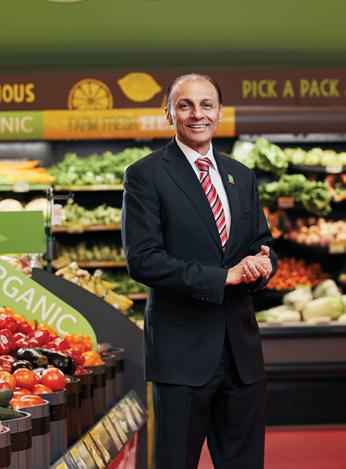




To subscribe visit: canadiangrocer.com To advertise contact: Vanessa Peters, vpeters@ensembleiq.com #1 Reach #1 Frequency #1 Website #1 E-Newsletter Design for the times The Save On Foods pres den a ks expans on e comm and a ways go ng he ext a m e or customers exclusive Darrell Jones Specialty cheese please! Grand Prix winners star WOMEN JUNE/JULY What’s next for click-and-collect? A big year for produce CEO Ken Keelor on making his stores the most trusted places to shop and putting more “Calgary” in Calgary Co-op CALGARY CO-OP’S MISSION The #1 grocery industry resource in Canada
CATEGORY CAPTAINS

2022
An Industry Leadership Supplement from Canadian Grocer SPECIAL PROMOTIONAL FEATURE

PUBLISHER Vanessa Peters vpeters@ensembleiq.com
ART DIRECTOR
Trinh Phipps
SENIOR DIRECTOR OF PRODUCTION


Michael Kimpton mkimpton@ensembleiq.com
SENIOR VICE PRESIDENT, GROCERY AND CONVENIENCE, CANADA


Sandra Parente sparente@ensembleiq.com
VICE PRESIDENT, EVENTS
Megan Judkins mjudkins@ensembleiq.com
SENIOR DIRECTOR, DIGITAL CANADA & SPECIAL PROJECTS


Valerie White vwhite@ensembleiq.com
SALES
NATIONAL ACCOUNT MANAGER
Katherine Frederick kfrederick@ensembleiq.com
ACCOUNT MANAGER

Karishma Rajani krajani@ensembleiq.com
SALES COORDINATOR

Juan Chacon jchacon@ensembleiq.com
SUBSCRIPTION SERVICES
Subscriptions: $85.00 per year, 2 year $136.00, Outside Canada $136.00 per year, 2 year $216 Single Copy $12.00, Groups $61.00, Outside Canada Single Copy $16.00.
Digital Subscriptions: $60.00 per year, 2 year $95.00
Category Captain: Single Copy $20.00, Outside Canada Single Copy $30.00
Fresh Report: Single Copy $20.00, Outside Canada Single Copy $30.00
Who’s Who: Single Copy $190.00, Outside Canada Single Copy $230.00
Email: contactus@canadiangrocer.com
Phone: 1-877-687-7321 between 9 a.m. to 5 p.m. EST weekdays Fax: 1-888-520-3608
Online: www.canadiangrocer.com/subscription
Printed in Canada
1K8.
Bread 5 Canned Tomatoes 7 Coffee 9 Dips 11 Dry Packaged Dinners 13 Fresh and Deli 15 Frozen Food 17 Health and Wellness 19 Peanut Butter 21 Premium Mixers 23 AN INDUSTRY LEADERSHIP SUPPLEMENT FROM CANADIAN GROCER CORPORATE OFFICERS CHIEF EXECUTIVE OFFICER Jennifer Litterick CHIEF FINANCIAL OFFICER Jane Volland CHIEF PEOPLE OFFICER Ann Jadown EXECUTIVE VICE PRESIDENT, OPERATIONS Derek Estey EXECUTIVE VICE PRESIDENT, CONTENT & COMMUNICATION Joe Territo MAIL PREFERENCES: From time to time other organizations may ask Canadian Grocer if they may send information about a product or service to some Canadian Grocer subscribers, by mail or email. If you do not wish to receive these messages, contact us in any of the ways listed above. Contents Copyright © 2022 by EnsembleIQ, may not be reprinted without permission. Canadian Grocer receives unsolicited materials (including letters to the editor, press releases, promotional items and images) from time to time. Canadian Grocer, its affiliates and assignees may use, reproduce, publish, republish, distribute, store and archive such submissions in whole or in part in any form or medium whatsoever, without compensation of any sort. ISSN# 0008 3704 PM 42940023 Canadian Grocer is Published by Stagnito Partners Canada Inc., 20 Eglinton Avenue West, Ste. 1800, Toronto, Ontario, M4R
to love.
Villaggio Artesano is baked to inspire passion in your next recipe.













are









TM style white bread breadyle white breadhisty dle white btt h breayl ew ite br brea More
Endless possibilities
waiting!
Commercial Bread is a large grocery
plays a significant role at retail with $3.0 billion in sales for the latest 52 weeks and sales growth of +3% and gaining over $94 million in Canada1
Higher Health—comprised of grains, dietary needs (weight management, no fat, no sugar, and gluten free) and organic breads—is the largest segment in Commercial Bread with 19% dollar share, followed by White Bread at 18%, Buns & Rolls at 18%, and Breakfast at 16%. These four major segments account for 70% of the Commercial Bread category.1
Higher Health is the segment that supports consumers’ growing awareness and
for healthy,
“better-for-you”
BREAD
category and
demand
nutritious and
products. 1 NielsenIQ MarketTrack L52W Period Ending August 13, 2022 INNOVATION KEY GROWTH DRIVERS COMMERCIAL BREAD SEGMENTATION ($ SHARE/GROWTH %) Commercial Bread = 100 (+3%) Commercial Bread Higher Health White Bread Wheat Bread Breakfast Buns & Rolls Flatbread Specialty Specialty 10.5 (+6%) Flatbread 12.7 (+3%) Breakfast 15.9 (+3%) Buns & Rolls 17.6 (+4%) Higher Health 19 (+3%)* White Bread 17.9 (+3%) Wheat Bread 6.5 (+2%) 2% 3% 1% 0% 1% 2% 2% 0% Source: NeilsenIQ Market Track BRANDED ONLY L52W Period Ending August 13, 2022 Source: NielsenIQ Market Track L52W Period Ending August 13, 2022, * Higher Health = Grains + Dietary Needs + Organic Needs Established Items New Items/Innovation CATEGORY CAPTAINS 2022 5 98% 97% 99% 100% 99% 98% 98% 100% New product innovation plays a key factor in category growth and innovation is coming mainly from the Higher Health*, Buns & Rolls and Flatbread segments.

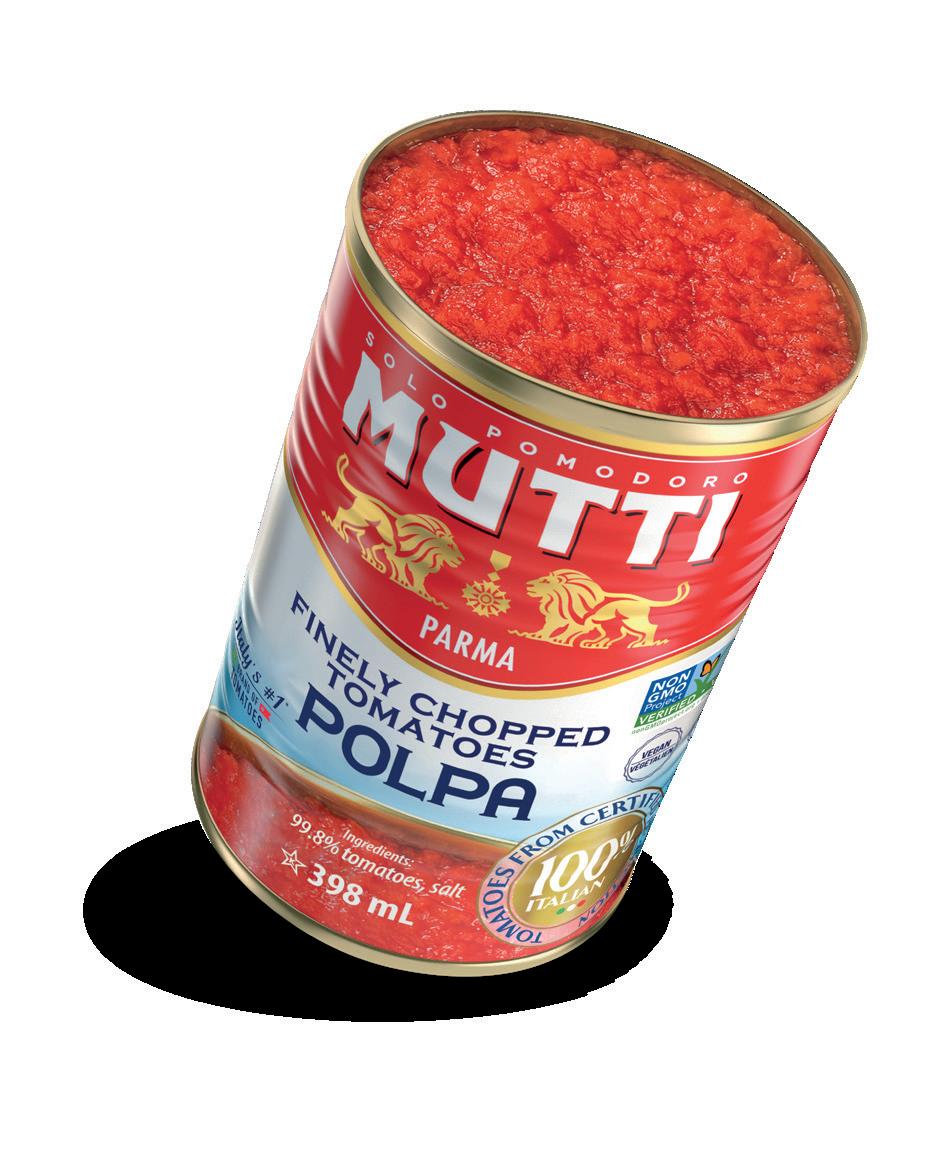
In the L52W period ending July 2, 2022, the Total Tomato category is valued at $255.2M dollars and experiencing declines of -2.5% (sales) and -7.5% (tonnage); and the Canned Tomato category is valued at $92.4M and is also showing declines of -3.6% and -7.2% in sales and tonnage respectively. Diced, ground + cut continues to be the largest segment, contributing 23% of category sales. Private label contributes 26% and is in decline (-3.1% sales & -7.6% tonnage) with the lowest average retail. All segments are also in decline, except for Sauce and Peeled which are relatively flat; and Passata, the fastest growing segment at +7.6% sales and -8.3% tonnage led by an imported brand, followed by Crushed at +3.4% sales and +1.6% tonnage. Quality is becoming increasingly important to consumers in the Total Tomato Category, as we see consumers paying double the price for a premium Italian brand over a value brand. This trading up is a key driver for the category value growth.
In the L6M same period, the Total Tomato category is valued at $130.2M and is showing growth in sales (+3%); and the Canned Tomato category is valued at $46.6M and experiencing growth at +3.8% (sales) and +4.9% (tonnage). As consumers begin entertaining in the home again, the category is growing in sales by 3%, with promotional levels at 51%, +3.5 pts, to help consumers mitigate increasing retails (+4.7%).1
More than ever, spending power is being pressured by inflation, as consumption increases in the L6M as consumers feel the impact of rising food prices on their wallets in the first half of 2022. The preference for authentic Italian products and brands, continues to increase as the ever-growing interest in premium food favours new consumption habits in the canned tomatoes category.
1 NielsenIQ GR+DR+MASS L52W
2,2022
0 10 20 30 60 50 40 70 DICE + CUT + GROUND TOMATOES L6 Months 2022 PRIVATE LABEL L52W 2021 TOMATO SAUCE TOMATO PASTE PIZZA SAUCE WHOLE PEELED TOMATOES STRAINED TOMATOES CRUSHED TOMATOES STEWED TOMATOES SEGMENT SALES TOTAL TOMATO CATEGORY CONSUMPTION (EXCL. PIZZA SAUCE) TOTAL CANNED TOMATOES Source: NielsenIQ GR+DR+MASS L52W Period Ending July 2,2022 Source: NielsenIQ GR+DR+MASS L52W Period Ending July 2,2022 Source: NielsenIQ GR+DR+MASS L52W Period Ending July 2,2022 92,486,085 65.9 57.9 29.2 28.9 24.2 19.1 14.4 11.5 4.0 68 61.1 29.3 29.3 25.3 19.2 13.4 11.2 4.4 225.8 46,676,038 221.4 $ SALES IN MILLIONS $ SALES $ SALES -3.1% -5.3% -0.1% -1.4% -4.4% -0.6% 7.6% 3.4% -10.2% -3.6% 3.8% -2.0% $ SALES YA SALES % CHG - $ SALES CATEGORY CAPTAINS 2022 7
Period Ending July
CANNED TOMATOES
Mornings



Just Got Smoother Coming this October,Kraft Café Barista coffee will be available in two rich and indulgent flavoured blends, Chocolate Hazelnut and Salted Caramel.
COFFEE
Coffee is a $1.4B category in Canada and is found in just over 80% of households. Over the last year, coffee manufacturers, retailers, and consumers have all been impacted as the world reacclimatizes post-lockdown. In-home coffee consumption was faced with two major headwinds.

First, the end of prolonged lockdown periods, and the relaxing of social distancing mandates suggested a shift back in coffee consumption from in-home to away-fromhome. Category household penetration reached a three-year high at the peak of the pandemic in 2020 at 80%. However, despite the reopening of away-from-home channels, retail Coffee has maintained its HHP into 2022.
Second, rising coffee commodity prices has seen an increase in coffee prices at retail. Price per ton for retail coffee has grown by 10% over the past two years. Yet, Coffee category sales are flat vs. previous year and up +3% vs. 2YA Time and time again, Canadians have shown that they are willing to pay more for their daily cup of joe.
The Coffee category in Canada has proven to be a resilient one. With more and more format and flavour innovation hitting shelves, the outlook on the Coffee category is optimistic.
TOTAL COFFEE - HOUSEHOLD PENETRATION
Sources: NielsenIQ Market Track, National GR+DR+MM, Coffee, L52W Period Ending August 20, 2022 NielsenIQ Factbook, Coffee, Period Ending April 2, 2022 Sources: NielsenIQ Market Track, National GR+DR+MM, Coffee, L52W Period Ending August 20, 2022, NielsenIQ Factbook, Coffee, Period Ending April 2, 2022 Sources: NielsenIQ Market Track, National GR+DR+MM, Coffee, L52W Period Ending August 20, 2022, NielsenIQ Factbook, Coffee, Period Ending April 2, 2022 0 L52W 2YAL52W 2YA L52W YAL52W YA L52WL52W 500,000 1,500,000 1,000,000 TOTAL COFFEE - $MM SALES 77.9 10.7 10.9 11.8 1,415 1,457 1,459 77.5 80.5 80.3 80.3 2018 2019 20212020 2022 TOTAL COFFEE - $ PRICE/TON CATEGORY CAPTAINS 2022 9 $ SALES 1 NielsenIQ Market Track, National GR+DR+MM, Coffee, Period Ending August 20, 2022 2 Nielsen Factbook, Coffee, Period Ending April 2, 2022


NEW Renée’s Dips Sources: Ipsos, Salad Dressings BVC Equity Report, Jan 2021; Nielsen MarketTrack, Nat XNFLD GB+DR+MM, PE APR22 2022; Nielsen Homescan Factbook Q1 2022 Made with real vegetables and herbs Proudly prepared in Canada No artificial colours, flavours, or preservatives Introducing • Renée’s accounts for 74% of the refrigerated dressings category. • The Renée’s brand scores #1 in key category attributes: tastes fresh; tastes more like homemade. • Made with real vegetables and herbs and absolutely no artificial flavours, colours or preservatives.
DIPS
Dips is a large and mature category within Canada, driving $406.7MM in $POS sales in the latest 52 weeks growing +3% vs. previous year (PY) 1. Dips is divided into two main segments, Mediterranean (58% of total) and Non-Mediterranean dips (42% of total), with brands competing against each other through shelf-stable, produce, dairy and other subsegments1
Within the sub-segments, Non-Mediterranean Dairy Dips contributes to approximately 47% of the total category1. Shelf-stable (+2% lbs vs. PY) and Deli (+4% lbs vs. PY) Dips have seen increased consumption in L52W despite inflationary price hikes1. As consumer interest weighs towards products prioritizing in freshness, convenience, and versatility, these subsegments have benefited greatly2 Specifically, within Refrigerated Produce Dips, consumers are more health conscious than other dips consumers and are more likely to avoid unrecognizable ingredients and products that contain artificial colours, flavours, or preservatives2. Beyond health claims, consumers value flavour exploration within the Dips category, as nearly 40% of dips consumers enjoy trying new varieties to make their food more exciting3
1 NielsenIQ Market Track National GR+DR+MM, Dips CIP, L52W Period Ending September 17, 2022
2 Bonnett, M. (2022, September 20). Dips and Savory Spreads - US - 2022. Retrieved from Mintel: https://reports.mintel.com/ display/1126501/
3 Riebe, S. (2022, August). Trending on US menus: sauces, dips & spreads. Retrieved from Mintel: https://clients.mintel. com/insight/trending-onus-menus-sauces-dipsspreads-3?fromSearch=%3F freetext%3Dveggie%2520di p&resultPosition=1

Non Mediterranean Refrigerated Dairy Non Mediterranean Refrigerated Deli Non Mediterranean Refrigerated Produce Non Mediterranean Shelf Stable Non Mediterranean Unspecified $10.00 $8.00 $6.00 $4.00 $2.00 7% 6% 5% 4% 3% 2% 1% 0% Non Mediterranean Refrigerated Dairy Non Mediterranean Refrigerated Deli Total Rfrg Non Mediterranean Dips 6.32 5.73 7.12 6.73 5.37 7.76 Non Mediterranean Unspecified Non Mediterranean Shelf Stable Non Mediterranean Refrigerated Produce Avg EQ Price Avg EQ Price % Chg YA POS $ by Segment (L52W Period Ending September 17, 2022) Price/lb (L52W Period Ending September 17, 2022) 11,538,949 5,843,679 PRICE PER LB AND GROWTH VERSUS LAST YEAR IN TOTAL NON-MEDITERRANEAN REFRIGERATED DIPS (BY SEGMENT) POINT OF SALES IN TOTAL NON-MEDITERRANEAN DIPS CATEGORY Source: NielsenIQ Market Track National GR+DR+MM, Dips CIP, L52W Period Ending September 17, 2022 Source: NielsenIQ Market Track National GR+DR+MM, Dips CIP, L52W Period Ending Septemer 17, 2022 CATEGORY CAPTAINS 2022 11 70,673,65336,438,504 44,612,678




• Made with 100% real cheese • KD is made with no artificial flavours, colours or preservatives • Proudly prepared in Canada be KD
DRY PACKAGED DINNERS
Dry Packaged Dinners (DPD) is a large and mature category of $262MM that spans across several sub-segments. DPD has shown growth with 2.54% CAGR over the last 2 years1, as it has proven to be a popular meal option while consumers ate out less and consumed more meals at home2. Canadians are consuming and preparing meals differently with seven out of 10 consumers prepping and cooking dinner under 30 minutes with 50% of all food and beverage choices motivated by the convenienceoriented trend3.
Macaroni & Cheese represents a whopping 70% of the DPD category sales with an average household penetration of 52.2% over the last two years4. In the last 52 weeks, DPD delivered over $260.4MM, up +17.7% compared to the year before. Macaroni & Cheese is driving this trend, growing +21.6% YOY behind the launch and growth of the new Cheetos line. Consumers are primarily loyal to the method of preparation they are used to (i.e. microwave vs. stovetop) driving low interaction between different formats. Macaroni & Cheese packaged meals also have a high degree of impulse for grocery categories with a split of 37% for unplanned purchases and 63% for planned purchases5.
1 NielsenIQ MarketTrack Data
– L52W Period Ending August 2022
2 Kraft Heinz Shopper Data, “Interaction between Product Groups as a function of Customers”, L52W March 2021

3 NPD Food Service Trends 2018. IPSOS Lumiere Study
4 KHC NielsenIQ Homescan Factbook L52W Period Ending Jul 02 22
5 IPSOS Lumiere Study. NielsenIQ Market Track Nat xNfld GB+DR+MM 2018.
Source: NielsenIQ, TOTAL National - L52W Period Ending July 2, 2022 Source: NielsenIQ, TOTAL National - L52W Period Ending July 2, 2022 Source: NielsenIQ, TOTAL National - L52W Period Ending August 2022 2020 2021 2022 2020 249,454,698 140,524,599 132,572,973 262,305,965 2021 2022 HOUSEHOLD PENETRATIONMACARONI & CHEESE MACARONI & CHEESE IS GROWING IN IMPORTANCE IN THE DPD CATEGORY MACARONI & CHEESE GROWTH IN SALES BUT DECLINE IN UNITS YOY DUE TO PRICE INFLATION 48.7% 49.4% 52.2% 64.5 65.3 69.6 300 200 100 0 L52W YA L52W MILLIONS $ Share $ Units CATEGORY CAPTAINS 2022 13
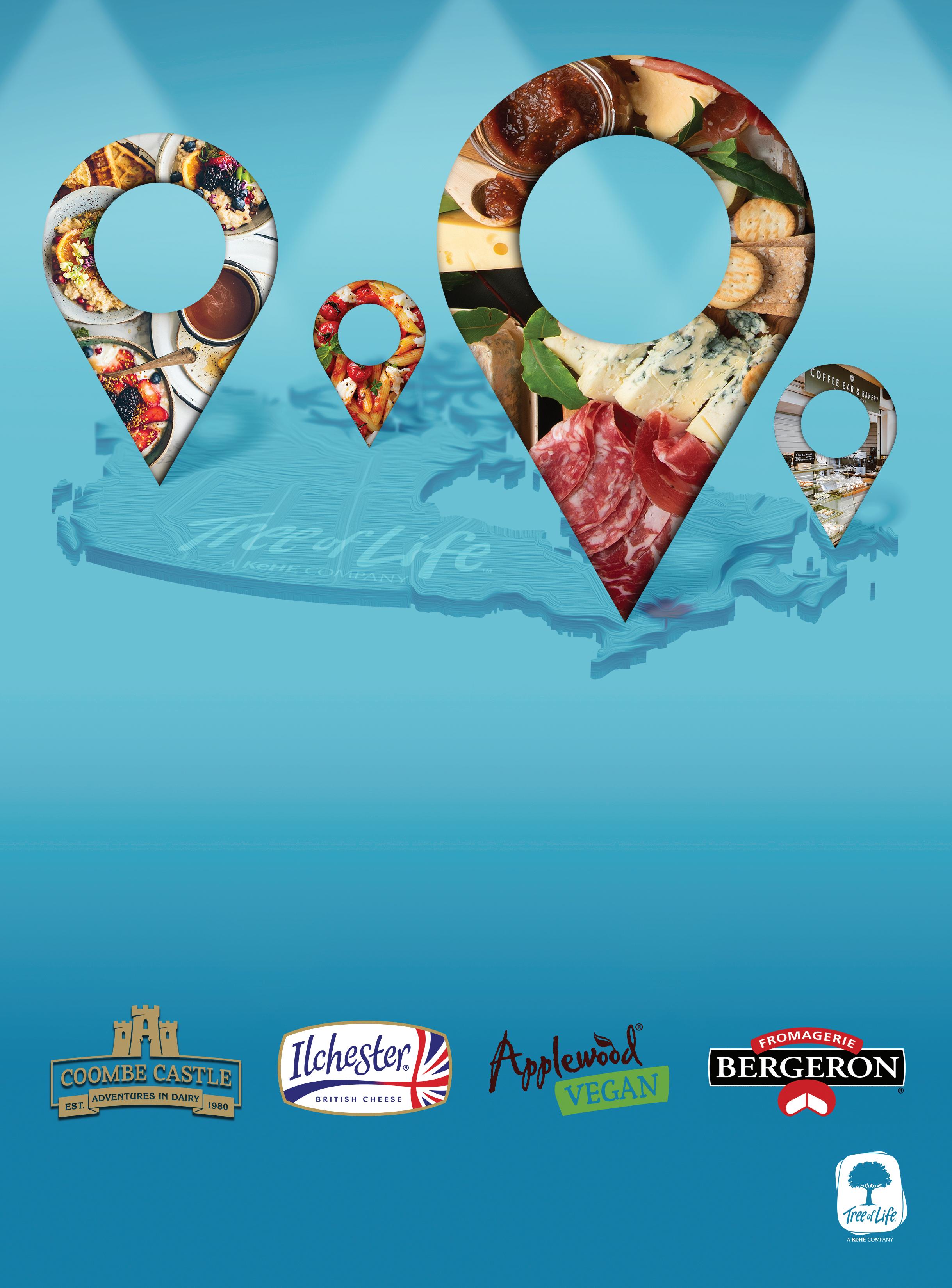


We are Canadian leaders in grocery and food service distribution, but we’re so much more We are curators of unique brands, helping to elevate brands in Canada and build customer demand through our appetite for fresh insights and data. ttreeoflife.ca reeoflifecan Tree of Life Canada From coast to coast, retailer to restaurant, we’ve got the solution. Natural. Specialty. Fresh. Food Service.
The average Canadian consumer enjoys 12.5 kilograms of cheese each year.1
Combined with the fact that category penetration sits at 95%2, cheese continues to be an important category for consumers and retailers alike. Moreover, 35% of consumers state they are consuming more cheese now than prior to the start of the pandemic.3
While most cheese production occurs within the European Union and the United States4, Canadian production continues to increase year over year; estimated to be around 540,000 metric tons in 2021.5
This growth, combined with the economic pressures of world (i.e. import and container costs, inflation, etc.), has allowed for more “local” Canadian brands to shine. Imported specialty cheeses continue to make their way into stores, but a Canadian-made specialty cheese at a fraction of the price resonates with those cost-conscious consumers.
Cheese continues to be a flexible ingredient for many. Available in an array of formats, flavours and sharpness, retailers and consumers will cheese the day!
1 Statista, Cheese Market in Canada, May 2022.
2 Mintel, Cheese - Canada, June 2022.
3 Ibid.
4 Statista, Cheese Market in Canada, May 2022.
5 Ibid.
STATEMENTS ABOUT VARIETY AND THE IMPORTANCE OF LOCAL CHEESE
Supermarkets should have a greater range of cheeses from local producers.
I often seek out different types of cheese.
Right now, I’m more willing to sacrafice on quality when it comes to cheese because of rising food prices.
I’m eating more cheese now than compared to before the start of the pandemic (March 2020)
FRESH AND DELI Source: StatCan; USDA Foreign Agricultureal Service © Statista 2022 Additional information: Canada; StatCan; USDA Foreign Agricultural Service; 2005-2020 Source: StatCan; USDA Foreign Agricultureal Service © Statista 2022 Additional information: Canada; StatCan; USDA Foreign Agricultural Service; 2005-2020
Source: StatCan; Kantar Profiles/Mintel, Cheese - Canada, June 2022
CATEGORY CAPTAINS 2022 15 VOLUME OF CHEESE PRODUCED IN CANADA FROM 2005 TO 2022
MAJOR CHEESE PRODUCING COUNTRIES IN 2021 (in 1,000 metric tons) 600 500 400 300 200 100 0 EU - 27 United States Russia Brazil Argentina Canada UK Mexico New Zealand Australia Belarus
Agree Disagree
Volume in thousand metric tons 2005 2006 2007 2008 2007 2010 2011 2012 2013 2014 2015 2016 2017 2018 2019 2020 2021 2022 379 6,206 10, 350 1,075 790 544 540 505 448 390 360 355 387 401 400 404 408 405 424 421 433 446 476 497 510 515 523 540 550 84% 65% 35% 16% 49% 35% 65% 51%





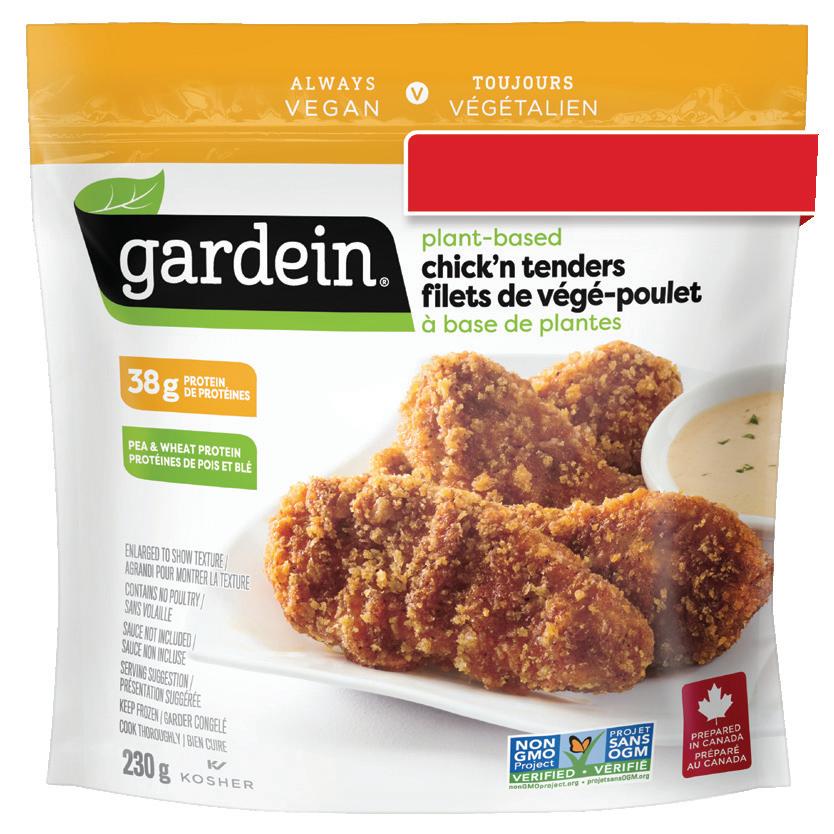


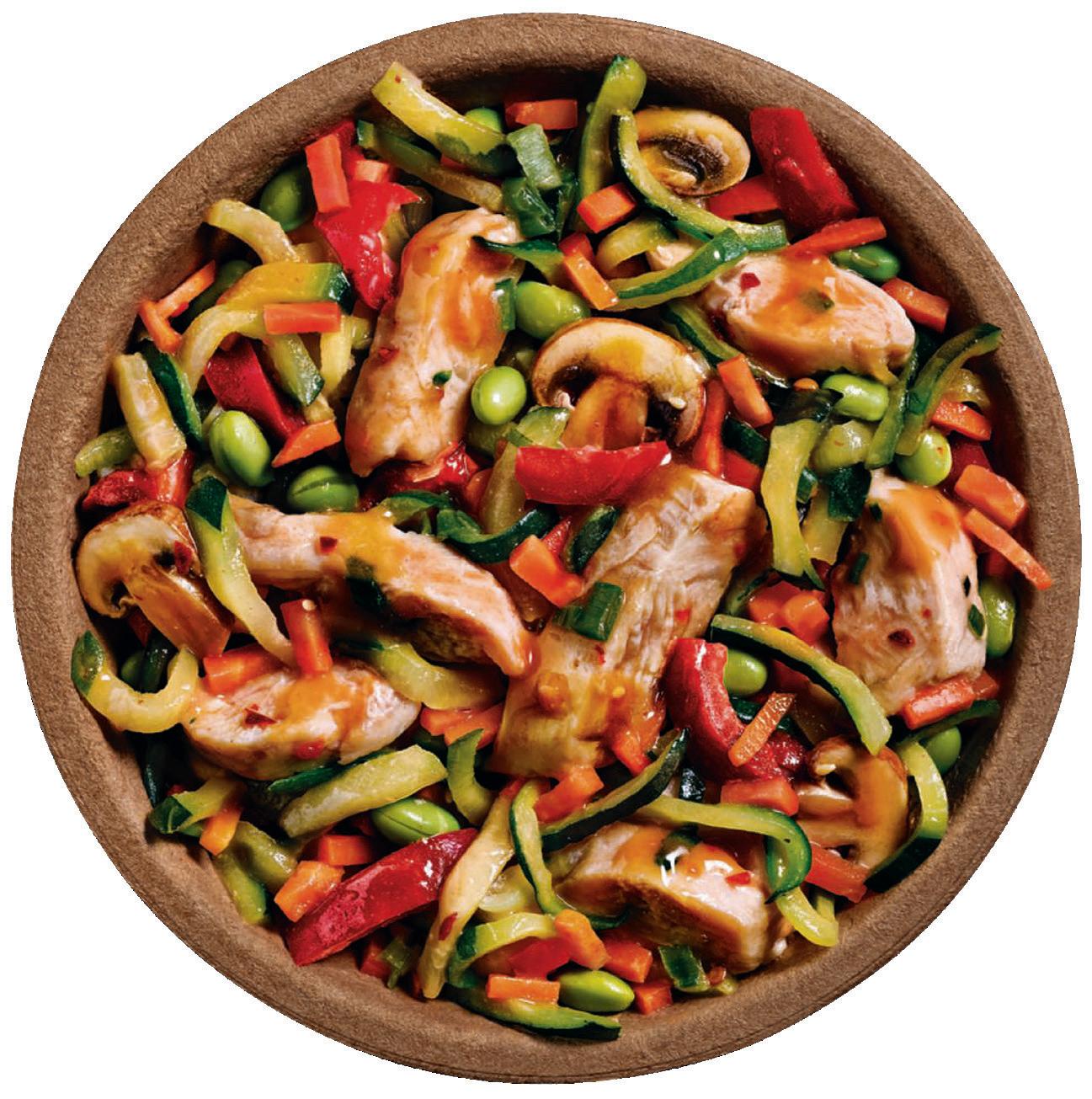






FROZEN
Frozen Food is increasingly gaining traction amongst Canadians as lifestyles and preferences evolve. Once known as a stagnant category, Frozen Food has transformed into a prominent staple in Canadian households with 98.6% households purchasing.1 A variety of offerings appeal to all types of consumers from the meat lovers to flexitarians.
Convenience is the main motivation behind purchasing Frozen with 55% of Canadians eating Frozen because of the quicker cook time2 (under 30-minute dinner prep rising +0.4%)3. With the average work week 10% longer than the start of the pandemic4, more Canadians are opting for quick and cost-efficient foods.
Nearly 80% of Frozen Food is consumed at home5 with dinners and entrees the largest category in Frozen contributing to approximately 30% of overall Frozen sales6. Young families and empty nesters are the dominant purchasers of the category driving growth in multi-serve meals prepared for families and single serve meals for small households. With empty nester baby boomers the largest portion of the population (25%) and millennial young families the fastest growing population (+9%)7, it is predicted that the Frozen category will continue to grow and evolve for years to come.
1
2
3
4
5
6
FIVE L52W
Aug 2021 vs PrePandemic Period L52W Period Ending Aug 2019
Work in
2022
Ending June 2022 vs June 2019
Period Ending May 21 2022
7
FOOD $ GROWTH OF FROZEN FUNCTIONAL MOTIVATION AS TO WHY CANADIANS PURCHASE FROZEN GENERATIONAL COHORTS BREAKDOWN - FROZEN BUYERS Jan 2017 5,632,790 5,692,655 5,902,454 6,105,054 7,570,442 7,506,763 Jan 2018 Jan 2019 Jan 2020 Jan 2021 Jan 2022 DOLLAR VOLUME $(000)S Source: NielsenIQ Market Track. National All Channel incl. NFLD. L52W to Jan 01 2022 Source: IPSOS FIVE data L12M Period Ending June 2022 Source: IPSOS FIVE data L12M Period Ending June 2022
NielsenIQ Homescan L52W Period Ending May 21 2022
Mintel Time and the Future of Food 2021
Ipsos
Period Ending
Statistia Remote
Canada
IPSOS FIVE data L52W Period
NielsenIQ Market Track National All Channel incl. NFLD. L52W
StatsCan Demographic Population 2016-2021 Motivation Easy to Prepare/Little or No Planning Wanted something tasty Satisfies a craving Satisfies my hunger Could be eaten quickly Good value for the money Alpha Gen (<11 years old) Gen Z (11–24 years old) Millenials (25–41 years old) Gen X (42–54 years old) Boomers (55–74 years old) Gen X (75+ years old) Total Frozen Foods (%Chg) 30.9% 2.8% 29.0% 2.5% 27.3% 2.0% 26.5% -0.7% 23.0% 3.3% 22.4% 3.9% CATEGORY CAPTAINS 2022 17 5 Year CAGR +6% 10% 20% 26% 18% 23% 3%

From floods to forest fires, the effects of climate change are, unfortunately, constant. Sustainability is a much-discussed sub-topic, primarily around how consumers can support the environment through their purchases. In fact, almost three-quarters of all consumers believe that sustainability is an important consideration when buying a product.1
Products considered sustainable:2
• Do not deplete natural, non-renewable resources
• Do not directly harm the environment
• Are not made in a socially irresponsible way
Sustainably marketed products represented one-thirdof all CPG growth between 2015– 2021,3 and are outpacing the growth rate of their conventional counterparts by 2.7 times.3
As consumers commit to more sustainable purchases, innovation carrying third party certifications are beneficial. Not only does third party certification promote a company’s sustainability efforts, but it also assists in building consumer confidence.
Sustainability will remain important for consumers and retailers alike. Consumers are making an intentional shift for the environment and retailers see larger basket rings as there exists a sizable price premium over conventional counterparts of 28%.3
1
June 2022 n=764
2 Earth Media Partners, 2022. “What makes a
earth911.com
3 IRI
Data for MultiOutlet across 36 core
analysis by NYU Stern Center for Sustainable
Sustainability
7.34%
3.45%
2.76%
Source: IRI POS data for Multi- Outlet across 36 core categories; Analysis by NYU Stern Center for Sustainable Business Source: IRI Edible Market Advantage™, Multi-Outlet CY 2021 Ending December 26, 2021; Multi- Outlet L52W Period Ending August 7, 2022, Label Insights Source: IRI POS data for Multi- Outlet across 36 core categories; Analysis by NYU Stern Center for Sustainable Business CATEGORY CAPTAINS 2022 19 140 130 120 110 100 2015 NON GMO Sustainability Marketed Products Conventionally Marketed Products $ Sales % Change vs. YA 5.9% 6.0 2.0 6.6 2.8 4.1% 5.8% 12.5% $ Share Current ORGANIC PARABEN FREE CRUELTY FREE 2016 2017 2018 2019 2020 2021 INDEX (Base Year 2015 = 100) Sustainability-marked products Category Conventionally-marked products
Marketed 6 Year CAGR:
Total Market 6 Year CAGR:
Conventionally Marketed 6 Year CAGR:
HEALTH AND WELLNESS
IRI Omniconsumer Survey Solutions
product sustainable,”
POS
categories,
Business SUSTAINABLY MARKETED PRODUCTS GREW 2.7X FASTER IN THEIR CATEGORIES AMONG TOP HEALTH AND WELLNESS CLAIMS ACROSS TOTAL CPG, CRUELTY FREE GREW MOST IN SHARE AND SALES Total Store Health and Wellness Claims SUSTAINABLE PRODUCTS DROVE A THIRD OF CPG GROWTH $ Share of Market Growth (2015-2021) 67.9% 32.1%

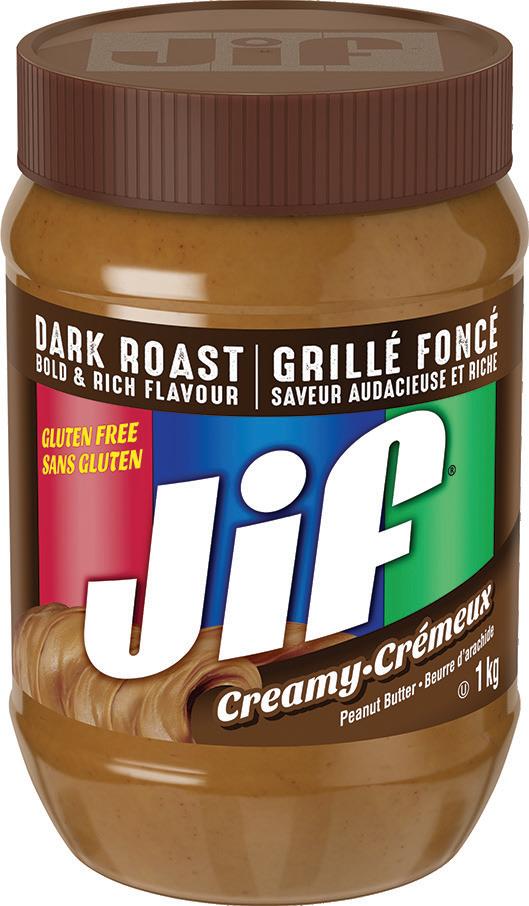
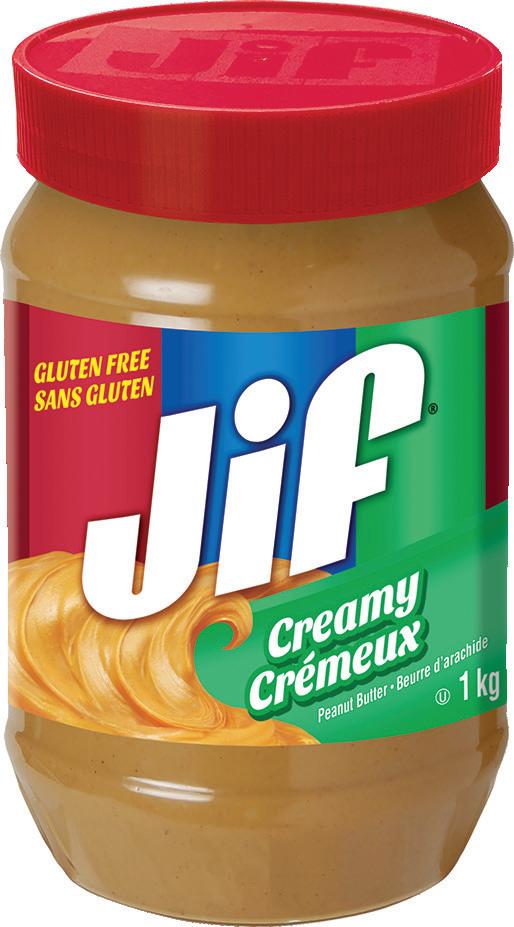

AVAILABLE IN JIF SQUEEZE ™ SAME GREAT JIF ® PEANUT BUTTER
PEANUT BUTTER
Peanut Butter remains a pantry staple, reaching $306 million in annual sales. The category experienced inflationary growth in dollar sales +0.3%, while tonnage volume declined -5%.1
The Regular (stabilized) Peanut Butter segment makes up about 79% of sales in the category, maintainig dollar sales vs. year ago. Natural Peanut Butter, representing 21% of the category, drives momentum with +3% growth as consumers seek a wide variety of Peanut Butter. The main subsegments include Creamy, representing 67% of category sales, Crunchy (19%), Light (12%), and Dark Roast (2%).1
With a household penetration of 75%, Peanut Butter offers Canadians a convenient comfort snack and meal.2 Peanut Butter provides flexibility with numerous usage occasions – in smoothies, paired with fruit, or in a classic PB&J sandwich. Daily at-home consumption and maintaining a full pantry has become the new normal.3 As consumer behaviour shifts, retailers should ensure shelving planograms display extensive Peanut Butter varieties to meet all consumer needs.
1 NielsenIQ MarketTrack, National All Channels, L52W Period Ending July 16, 2022



2 Numerator Panel, L52W Period Ending July 16, 2022
3 Deloitte, The Future of Food: A Canadian Perspective – Fresh, Focused, and Sustainable – The Role of the Grocery Store 2021

0 0 100 100 150 50 200 200 300 PEANUT BUTTER 3-YEAR TREND PEANUT BUTTER SUB-SEGMENTSPEANUT BUTTER SEGMENTS Source: NielsenIQ MarketTrack, National All Channels, L52W Period Ending July 16, 2022 Source: NielsenIQ MarketTrack, National All Channels, L52W Period Ending July 16, 2022 Note: Creamy and Crunchy calculations exclude overlap of Light and Dark Roast Sub-Segments Source: NielsenIQ MarketTrack, National All Channels, L52W Period Ending July 16, 2022 313 206 59 36 305 306 L52W 2YA Creamy Natural PB $65,691,080 Regular PB $240,358,251 Total PB $306,049,333 L52W YA Crunchy L52W Tonn Vol (KG) Light Dark $ SALES IN MILLIONS $ VOL IN MILLIONS 78.5% 21.5% 62,206,618 59,929,625 57,163,110 5 CATEGORY CAPTAINS 2022 21


Proud TO BE VOTED THE MIXER BY THE WORLD’S BEST BARS NO.1 BEST-SELLING & TOP-TRENDING And for the 7 years before that as the No.1 best-selling & top-trending tonic www.fever-tree.com | @FeverTreeCanada | #MixWithTheBest
PREMIUM MIXERS
Premium Mixers is an exciting and quickly growing category, almost doubling at +95% between 2019 and 20221. The premium category, worth over $23M1, drives value back into a beverage category where margins are typically razor-thin. Rapid premiumization has been evident as Canadian consumers seek to mix premium mixers with high-quality spirits. These include tonics, ginger beers, ginger ales, and sodas to create world-class, restaurant-quality drinks that are delicious and easy to make at home.
An indication of the future potential for the Premium Mixers category lies in the projected market split of the Premium Spirits category vs. Standard Spirits. In 2021 Premium Spirits accounted for 30% of the total Spirits market, but this number is expected to grow to an impressive 40% by 20252. As the acceleration of consumers to trade up with their spirits continues, they will also be eager to do the same with their mixer. This behaviour lends to a significant opportunity for retailers to designate premium shelf and display space to a fastgrowing category and earn more profit.
PREMIUM MIXER CATEGORY GROWTH
1 NielsenIQ Data Total
L52W Period Ending June 18,2022 & L52W Period Ending June 22, 2019
2 IWSR 2021 Actuals, IWSR 2022-2025 Estimates, (Exchange Rate used 1.32 accurate as of Sept 15, 2022)
PREMIUM SPIRIT PREDICTED CATEGORY GROWTH 2019 $12.0m $23.5m $ Sales in millions 2021 2022 2023 2024 2025 $8.3 million $8.5 million $8.8 million $9.1 million $9.5 million Market Share 2022 Source: NielsenIQ Data Total Canada L52W Period Ending June 18,2022 & L52W Period Ending June 22, 2019 Source: IWSR 2021 Actuals, IWSR 2022-2025 Estimates, (Exchange Rate used 1.32 accurate as of Sept 15, 2022)
Canada
Premium +11% Standard 0% CATEGORY CAPTAINS 2022 23 30% 33% 35% 37% 40% 70% 67% 65% 63% 60%

















































































































































































































 Carmen Fortino Executive Vice President, National Supply Chain and Procurement
Carmen Fortino Executive Vice President, National Supply Chain and Procurement





































































 By Jessica Huras
By Jessica Huras





















 By Chris Daniels
By Chris Daniels




















































































